Paul van Yperen's Blog, page 96
February 15, 2023
Raquel Welch (1940-2023)
Yesterday, 15 February 2023, American actress and sex symbol Raquel Welch (1940) died at the age of 82 after a short illness. She was one of the icons of the 1960s and 1970s. Welch first won attention for her role in Fantastic Voyage (1966). In Great Britain, she then made One Million Years B.C. (1966). Although she had only three lines in the film, a poster of Welch in a furry prehistoric bikini became an amazing bestseller and catapulted her to stardom.
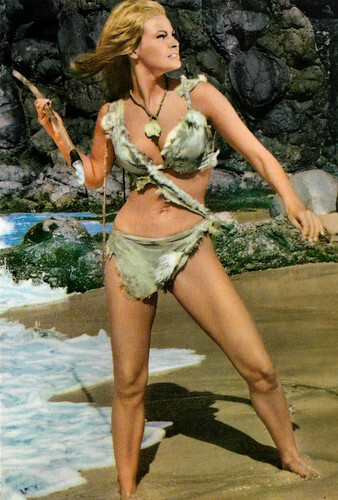
Italian postcard, no. 100 104. Raquel Welch in One Million Years BC (Don Chaffey, 1966).

Vintage photo by Terry O'Neill.
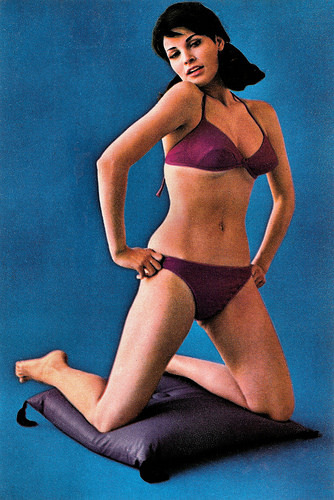
German postcard, no. 100 / 125.
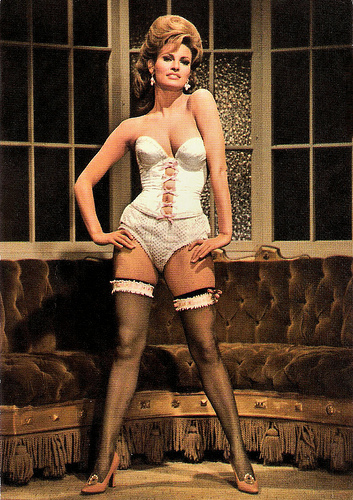
Vintage postcard. Photo: publicity still for Le plus vieux métier du monde/The oldest profession (Michael Pfleghar, 1967).
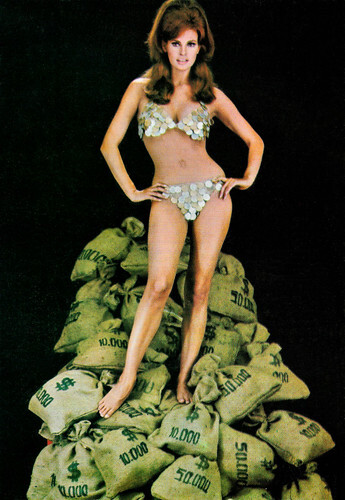
Belgian postcard by Edit. Decker, Brussels, no. P.U. 51. Raquel Welch in The Biggest Bundle of Them All (Ken Annakin, 1968).
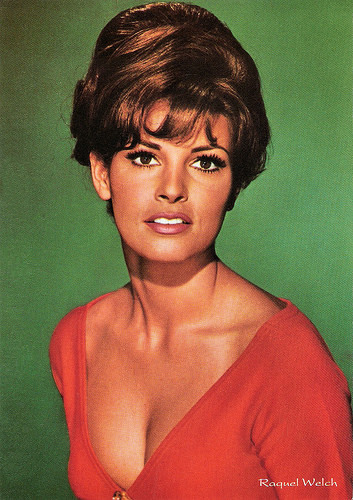
Italian postcard in the Artisti di Sempre series by Rotalfoto, Milano, no. 347.
Miss Photogenic
Raquel Welch was born Jo Raquel Tejada in 1940 in Chicago, Illinois. She was the first of three children born to Bolivian Armando Carlos Tejada Urquizo, an aerospace engineer, and his Irish-American wife Josephine Sarah Hall, who was the daughter of American architect Emery Stanford Hall.
At age 14, Raquel won her first beauty title as Miss Photogenic. She graduated from high school in 1958 and a year later, after becoming pregnant, she married her high school sweetheart, James Welch. Seeking an acting career, Welch won a scholarship in drama, took classes at San Diego State College and won several parts in local theatre productions. She got a job as a weather forecaster at KFMB, a local San Diego television station.
After her separation from James Welch, she moved with her two children to Dallas, Texas, where she worked as a model for Neiman Marcus and as a cocktail waitress. In 1963, she went to California, where she met former child star and Hollywood agent Patrick Curtis who became her personal and business manager and second husband. They developed a plan to turn Welch into a sex symbol.
After small roles in a few films and TV series, she had her first featured role in the beach film A Swingin' Summer (Robert Sparr, 1965). She landed a seven-year nonexclusive contract at 20th Century Fox and was cast in a leading role in the sci-fi film Fantastic Voyage (Richard Fleischer, 1966) opposite Stephen Boyd . Welch portrayed a member of a medical team that is miniaturized and injected into the body of an injured diplomat with the mission to save his life. The film was a hit and made her a well-known name.
Fox Studio loaned her to Hammer Studios in Britain where she starred in One Million Years B.C. (Don Chaffey, 1966). Her only costume was a two-piece deer skin bikini. Gary Brumburgh at IMDb : "Tantalizingly wet with her garb clinging to all the right amazonian places, One Million Years B.C. (1966), if nothing else, captured the hearts and libidos of modern men (not to mention their teenage sons) while producing THE most definitive and best-selling pin-up poster of that time."
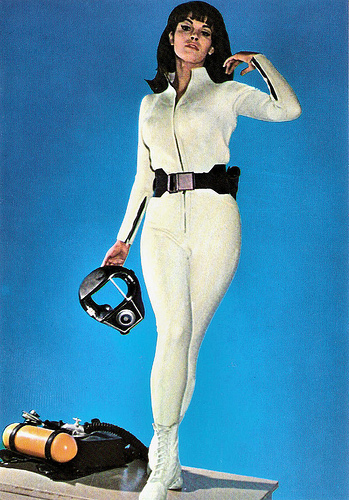
British postcard by Klasik Kards, no. 1541. Photo: publicity still for Fantastic Voyage (Richard Fleischer, 1966).
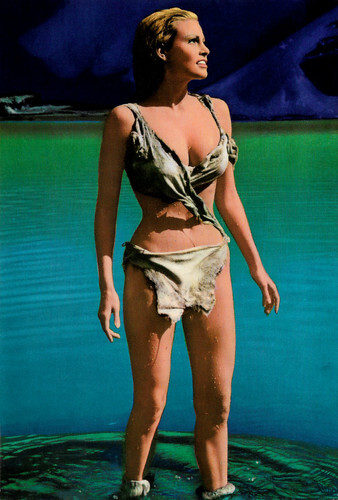
Italian postcard, no. 100 102. Raquel Welch in One Million Years BC (Don Chaffey, 1966).
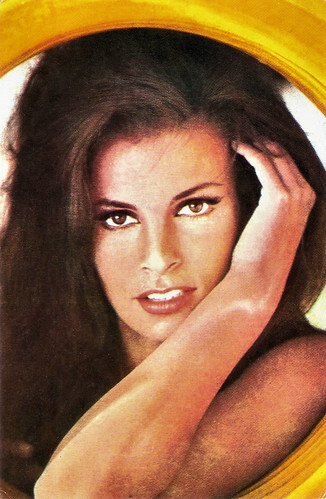
Romanian postcard by Casa Filmului Acin, no. 149.
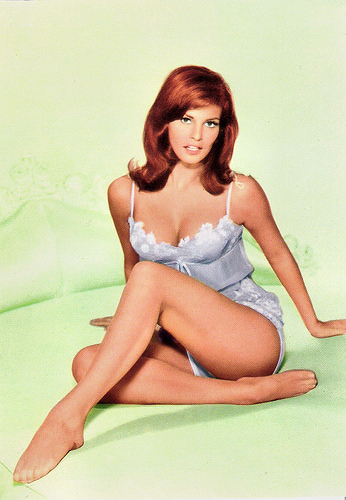
Italian postcard, no. 100/116.
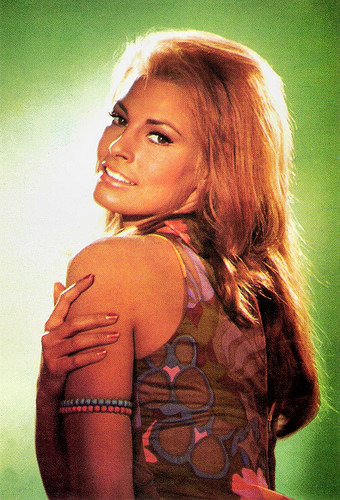
Spanish postcard, no. 597.
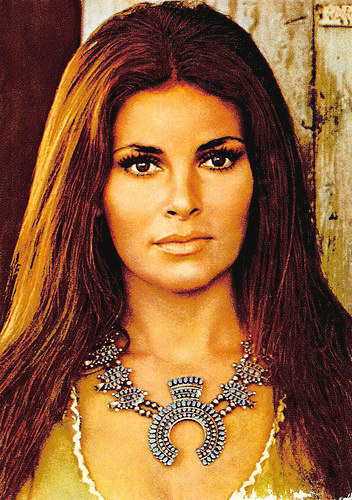
Romanian postcard by Casa Filmului Acin.
Ground-breaking sex scenes
Raquel Welch stayed in Europe for the French comedy Le Plus Vieux Métier du monde/The Oldest Profession (Michael Pfleghar a.o., 1967), a typical European anthology film of the 1960s. A collection of sketches on prostitution through the ages, made by a pan-European cast and crew. Some of the most sensual stars of the era played the leads: Michèle Mercier , Elsa Martinelli , Anna Karina , Nadia Gray , Jeanne Moreau and Welch.
She played Nini in the episode La belle époque/The Gay Nineties by German director Michael Pfleghar. When Nini discovers by accident that her antiquated customer ( Martin Held ) is a banker, she pretends to be an honest woman who has fallen in love with him. She even pays him, just like a gigolo!
Varlaam at IMDb : "Raquel Welch stars in the most amusing episode, relatively speaking. It's apparently set in 1890s Vienna (Emperor Franz Josef is on the paper money). One could probably say that Raquel's greatest classic role was as the injured party in the Cannery Row lawsuit. Finely nuanced she was not, normally. But she makes an appealing light comedienne here, and she can really fill a lacy Viennese corset. The Belle Époque it assuredly was."
Next, she appeared in the British seven-deadly-sins comedy Bedazzled (Stanley Donen, 1967). She played the deadly sin representing 'lust' for the comedy team of Peter Cook and Dudley Moore. In Britain, she was also the title secret agent in the sexy spy spoof Fathom (Leslie H. Martinson, 1967).
In Italy, she starred with Monica Vitti and Claudia Cardinale in Le Fate/The Queens (Mauro Bolognini, 1966) and with Edward G. Robinson and Vittorio de Sica in The Biggest Bundle of Them All (Ken Annakin, 1968).
Back in the United States, she appeared in the Western Bandolero! (Andrew V. McLaglen, 1968) with James Stewart and Dean Martin , which was followed by the private-eye drama Lady in Cement (Gordon Douglas, 1968) with Frank Sinatra . She caused quite a stir in her ground-breaking sex scenes with black athlete Jim Brown in the Western 100 Rifles (Tom Gries, 1969).
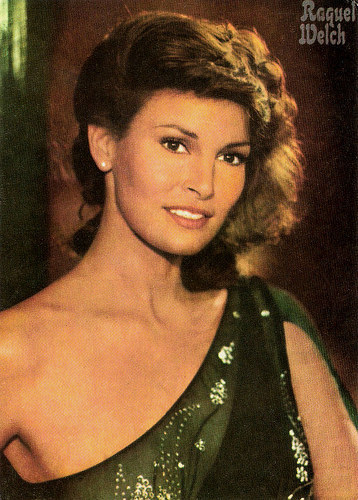
Romanian postcard by Casa Filmului Acin, no. 43079.
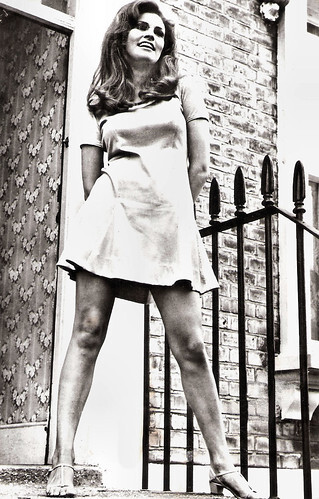
Romanian postcard by Casa Filmului Acin, no. 350. Raquel Welch at the set of Bedazzled (Stanley Donen, 1967).
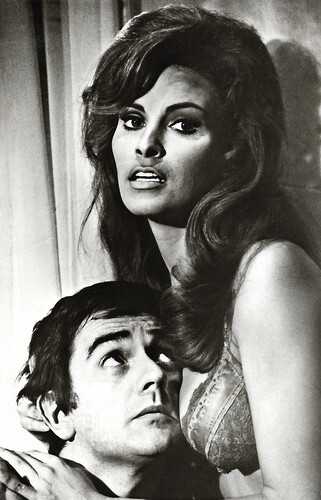
Romanian postcard by Casa Filmului Acin, no. 362. Raquel Welch and Dudley Moore in Bedazzled (Stanley Donen, 1967).
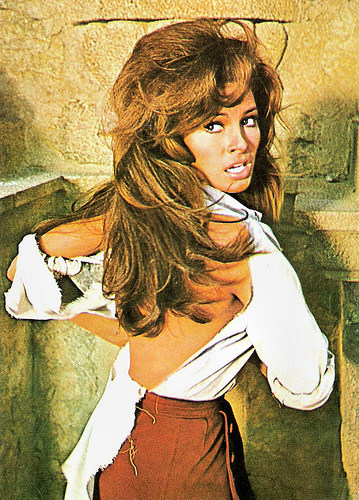
Romanian postcard by Casa Filmului Acin. Photo: publicity still for Bandolero! (Andrew V. McLaglen, 1968).
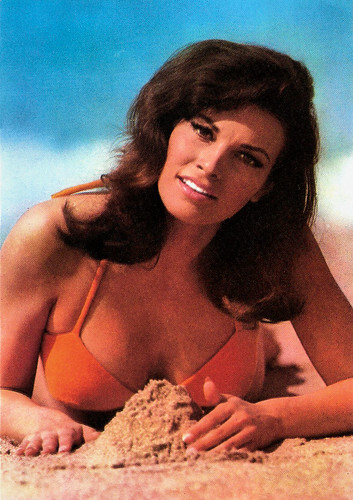
Italian postcard, no. 536/4. Raquel Welch in The Biggest Bundle of Them All (Ken Annakin, 1968).
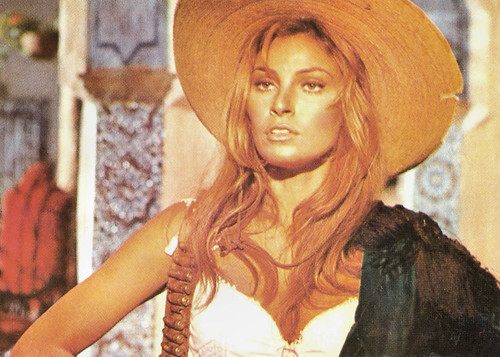
Romanian postcard by Casa Filmului Acin. Raquel Welch in 100 Rifles (Tom Gries, 1969).
Breaking the mould of the submissive sex symbol
Raquel Welch's most controversial role came in the comedy Myra Breckinridge (Michael Sarne, 1970), based on Gore Vidal's 1968 novel. She took the part as the film's transsexual heroine in an attempt to be taken seriously as an actress. The picture was controversial for its sexual explicitness, but unlike the novel, Myra Breckinridge received little to no critical praise. It is cited in the book The Fifty Worst Films of All Time.
Jason Ankeny at AllMovie : "Her situation was unusual; she was certainly a star and a household name, yet few people ever went to see her movies." Welch took a measure of control over her screen persona, producing and starring in Hannie Calder (Burt Kennedy, 1971), the first film in which she carved out a place in movie history portraying strong female characters and breaking the mould of the submissive sex symbol. She altered the image further with Kansas City Bomber (Jerrold Freedman, 1972), insisting on doing her own stunts as good-hearted roller derby star Diane 'KC' Carr.
She followed that with a series of successful films in Europe that included the thriller Bluebeard (Edward Dmytryk, 1972) starring Richard Burton , the swashbuckler The Three Musketeers (Richard Lester, 1973) - for which she won a Golden Globe, the sequel The Four Musketeers (Richard Lester, 1974) both with Oliver Reed and Michael York , and The Wild Party (James Ivory, 1975).
A big hit in Europe was the French action-comedy L'Animal/Animal (Claude Zidi, 1977) starring Jean-Paul Belmondo . Raquel Welch's unique persona on film made her one of the reigning icons of the 1960s and 1970s. Later, she made several television variety specials. In 1980, Welch planned on making a comeback in an adaptation of John Steinbeck's Cannery Row (David S. Ward, 1982), but was fired by the producers a few days into production. The producers said that at 40 years old she was too old to play the character. She was replaced by Debra Winger. Welch sued and collected a $10.8 million settlement.
She starred on Broadway in Woman of the Year, receiving praise for following Lauren Bacall in the title role. She also starred in Victor/Victoria, having less success. In 1995, Welch was chosen by Empire Magazine as one of the 100 Sexiest Stars in Film History.
Her later films included the hit comedy Legally Blonde (Robert Luketic, 2001), starring Reese Witherspoon, and Forget About It (BJ Davis, 2006) with Burt Reynolds. Welch was married four times and was the mother of Damon Welch (1959) and actress Tahnee Welch (1961).
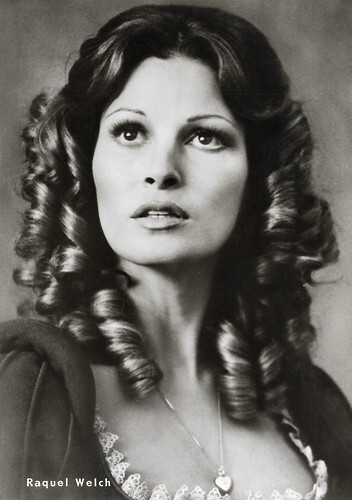
East German postcard by Progress Film-Verleih, Berlin, no. 117 /76. Raquel Welch in The Three Musketeers (Richard Lester, 1973).
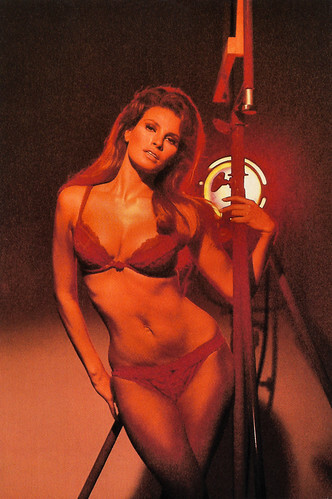
American postcard by the American Postcard Company Inc., no. 1057.

American postcard by Coral-Lee, Rancho Cordova, Ca., no. Personality 21. Photo: Douglas Kirkland, 1978.
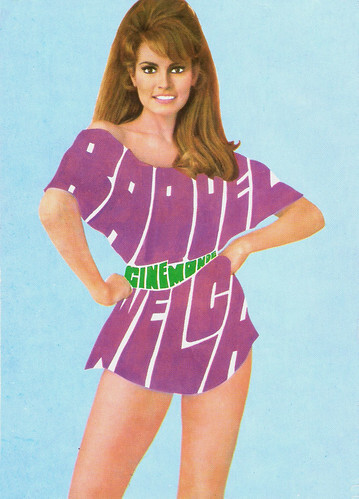
Romanian postcard by Casa Filmului Acin.
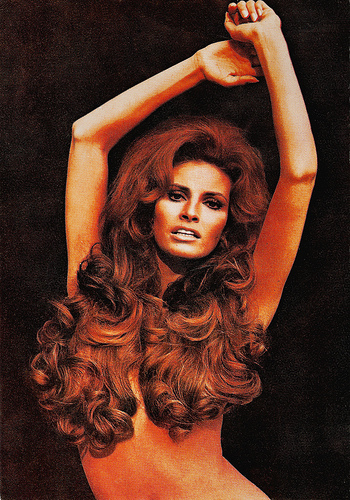
Spanish postcard, no. 11. Photo: Terry O'Neill.
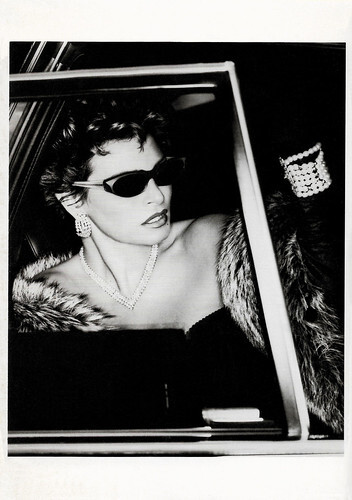
American postcard by Fotofolio, NY, NY, no. GG17. Photo: Greg Gorman. Caption: Raquel Welch, Los Angeles, 1988.
Trailer Fantastic Voyage (1966). Source: beowulfooo (YouTube).
Sources: Jason Ankeny (AllMovie), (IMDb), David Carless (IMDb), Bob Taylor (IMDb), Varlaam (IMDb), TCM, Wikipedia and .

Italian postcard, no. 100 104. Raquel Welch in One Million Years BC (Don Chaffey, 1966).

Vintage photo by Terry O'Neill.

German postcard, no. 100 / 125.

Vintage postcard. Photo: publicity still for Le plus vieux métier du monde/The oldest profession (Michael Pfleghar, 1967).

Belgian postcard by Edit. Decker, Brussels, no. P.U. 51. Raquel Welch in The Biggest Bundle of Them All (Ken Annakin, 1968).

Italian postcard in the Artisti di Sempre series by Rotalfoto, Milano, no. 347.
Miss Photogenic
Raquel Welch was born Jo Raquel Tejada in 1940 in Chicago, Illinois. She was the first of three children born to Bolivian Armando Carlos Tejada Urquizo, an aerospace engineer, and his Irish-American wife Josephine Sarah Hall, who was the daughter of American architect Emery Stanford Hall.
At age 14, Raquel won her first beauty title as Miss Photogenic. She graduated from high school in 1958 and a year later, after becoming pregnant, she married her high school sweetheart, James Welch. Seeking an acting career, Welch won a scholarship in drama, took classes at San Diego State College and won several parts in local theatre productions. She got a job as a weather forecaster at KFMB, a local San Diego television station.
After her separation from James Welch, she moved with her two children to Dallas, Texas, where she worked as a model for Neiman Marcus and as a cocktail waitress. In 1963, she went to California, where she met former child star and Hollywood agent Patrick Curtis who became her personal and business manager and second husband. They developed a plan to turn Welch into a sex symbol.
After small roles in a few films and TV series, she had her first featured role in the beach film A Swingin' Summer (Robert Sparr, 1965). She landed a seven-year nonexclusive contract at 20th Century Fox and was cast in a leading role in the sci-fi film Fantastic Voyage (Richard Fleischer, 1966) opposite Stephen Boyd . Welch portrayed a member of a medical team that is miniaturized and injected into the body of an injured diplomat with the mission to save his life. The film was a hit and made her a well-known name.
Fox Studio loaned her to Hammer Studios in Britain where she starred in One Million Years B.C. (Don Chaffey, 1966). Her only costume was a two-piece deer skin bikini. Gary Brumburgh at IMDb : "Tantalizingly wet with her garb clinging to all the right amazonian places, One Million Years B.C. (1966), if nothing else, captured the hearts and libidos of modern men (not to mention their teenage sons) while producing THE most definitive and best-selling pin-up poster of that time."

British postcard by Klasik Kards, no. 1541. Photo: publicity still for Fantastic Voyage (Richard Fleischer, 1966).

Italian postcard, no. 100 102. Raquel Welch in One Million Years BC (Don Chaffey, 1966).

Romanian postcard by Casa Filmului Acin, no. 149.

Italian postcard, no. 100/116.

Spanish postcard, no. 597.

Romanian postcard by Casa Filmului Acin.
Ground-breaking sex scenes
Raquel Welch stayed in Europe for the French comedy Le Plus Vieux Métier du monde/The Oldest Profession (Michael Pfleghar a.o., 1967), a typical European anthology film of the 1960s. A collection of sketches on prostitution through the ages, made by a pan-European cast and crew. Some of the most sensual stars of the era played the leads: Michèle Mercier , Elsa Martinelli , Anna Karina , Nadia Gray , Jeanne Moreau and Welch.
She played Nini in the episode La belle époque/The Gay Nineties by German director Michael Pfleghar. When Nini discovers by accident that her antiquated customer ( Martin Held ) is a banker, she pretends to be an honest woman who has fallen in love with him. She even pays him, just like a gigolo!
Varlaam at IMDb : "Raquel Welch stars in the most amusing episode, relatively speaking. It's apparently set in 1890s Vienna (Emperor Franz Josef is on the paper money). One could probably say that Raquel's greatest classic role was as the injured party in the Cannery Row lawsuit. Finely nuanced she was not, normally. But she makes an appealing light comedienne here, and she can really fill a lacy Viennese corset. The Belle Époque it assuredly was."
Next, she appeared in the British seven-deadly-sins comedy Bedazzled (Stanley Donen, 1967). She played the deadly sin representing 'lust' for the comedy team of Peter Cook and Dudley Moore. In Britain, she was also the title secret agent in the sexy spy spoof Fathom (Leslie H. Martinson, 1967).
In Italy, she starred with Monica Vitti and Claudia Cardinale in Le Fate/The Queens (Mauro Bolognini, 1966) and with Edward G. Robinson and Vittorio de Sica in The Biggest Bundle of Them All (Ken Annakin, 1968).
Back in the United States, she appeared in the Western Bandolero! (Andrew V. McLaglen, 1968) with James Stewart and Dean Martin , which was followed by the private-eye drama Lady in Cement (Gordon Douglas, 1968) with Frank Sinatra . She caused quite a stir in her ground-breaking sex scenes with black athlete Jim Brown in the Western 100 Rifles (Tom Gries, 1969).

Romanian postcard by Casa Filmului Acin, no. 43079.

Romanian postcard by Casa Filmului Acin, no. 350. Raquel Welch at the set of Bedazzled (Stanley Donen, 1967).

Romanian postcard by Casa Filmului Acin, no. 362. Raquel Welch and Dudley Moore in Bedazzled (Stanley Donen, 1967).

Romanian postcard by Casa Filmului Acin. Photo: publicity still for Bandolero! (Andrew V. McLaglen, 1968).

Italian postcard, no. 536/4. Raquel Welch in The Biggest Bundle of Them All (Ken Annakin, 1968).

Romanian postcard by Casa Filmului Acin. Raquel Welch in 100 Rifles (Tom Gries, 1969).
Breaking the mould of the submissive sex symbol
Raquel Welch's most controversial role came in the comedy Myra Breckinridge (Michael Sarne, 1970), based on Gore Vidal's 1968 novel. She took the part as the film's transsexual heroine in an attempt to be taken seriously as an actress. The picture was controversial for its sexual explicitness, but unlike the novel, Myra Breckinridge received little to no critical praise. It is cited in the book The Fifty Worst Films of All Time.
Jason Ankeny at AllMovie : "Her situation was unusual; she was certainly a star and a household name, yet few people ever went to see her movies." Welch took a measure of control over her screen persona, producing and starring in Hannie Calder (Burt Kennedy, 1971), the first film in which she carved out a place in movie history portraying strong female characters and breaking the mould of the submissive sex symbol. She altered the image further with Kansas City Bomber (Jerrold Freedman, 1972), insisting on doing her own stunts as good-hearted roller derby star Diane 'KC' Carr.
She followed that with a series of successful films in Europe that included the thriller Bluebeard (Edward Dmytryk, 1972) starring Richard Burton , the swashbuckler The Three Musketeers (Richard Lester, 1973) - for which she won a Golden Globe, the sequel The Four Musketeers (Richard Lester, 1974) both with Oliver Reed and Michael York , and The Wild Party (James Ivory, 1975).
A big hit in Europe was the French action-comedy L'Animal/Animal (Claude Zidi, 1977) starring Jean-Paul Belmondo . Raquel Welch's unique persona on film made her one of the reigning icons of the 1960s and 1970s. Later, she made several television variety specials. In 1980, Welch planned on making a comeback in an adaptation of John Steinbeck's Cannery Row (David S. Ward, 1982), but was fired by the producers a few days into production. The producers said that at 40 years old she was too old to play the character. She was replaced by Debra Winger. Welch sued and collected a $10.8 million settlement.
She starred on Broadway in Woman of the Year, receiving praise for following Lauren Bacall in the title role. She also starred in Victor/Victoria, having less success. In 1995, Welch was chosen by Empire Magazine as one of the 100 Sexiest Stars in Film History.
Her later films included the hit comedy Legally Blonde (Robert Luketic, 2001), starring Reese Witherspoon, and Forget About It (BJ Davis, 2006) with Burt Reynolds. Welch was married four times and was the mother of Damon Welch (1959) and actress Tahnee Welch (1961).

East German postcard by Progress Film-Verleih, Berlin, no. 117 /76. Raquel Welch in The Three Musketeers (Richard Lester, 1973).

American postcard by the American Postcard Company Inc., no. 1057.

American postcard by Coral-Lee, Rancho Cordova, Ca., no. Personality 21. Photo: Douglas Kirkland, 1978.

Romanian postcard by Casa Filmului Acin.

Spanish postcard, no. 11. Photo: Terry O'Neill.

American postcard by Fotofolio, NY, NY, no. GG17. Photo: Greg Gorman. Caption: Raquel Welch, Los Angeles, 1988.
Trailer Fantastic Voyage (1966). Source: beowulfooo (YouTube).
Sources: Jason Ankeny (AllMovie), (IMDb), David Carless (IMDb), Bob Taylor (IMDb), Varlaam (IMDb), TCM, Wikipedia and .
Published on February 15, 2023 22:00
February 14, 2023
Four films with Francesca Bertini: L'avarizia (1918), L'ira (1918), L'invidia (1919) and La lussuria (1919)
Francesca Bertini (1892-1985) was a majestic diva of Italian silent cinema. She often played the 'femme fatale', with men devouring eyes, glamorous attire, clenched fists, and in opulent settings... One of her major works is I sette peccati capitali/The Seven Deadly Sins (1918-1919), an Italian seven-part series based on the Eugène Sue novel 'Les sept pêchés capitaux' (1847-1852).
For more than half a century, the integral version of I sette peccati capitali was believed to be lost. It was found at the Prague Film Institute (Ceskoslovensky Filmovy Archiv) and carefully restored including the tinting. In 1991, two series parts were shown at Il Cinema Ritrovato in Bologna. Finally, the complete series was presented in Bologna in 2003. It includes the features L'orgoglio/Pride, La gola/Gluttony, L'ira/Wrath, L'avarizia/Greed (all 1918), L'invidia/Envy, L'accidia/Sloth and La lussuria/Lust (all 1919).
In the past, EFSP already posted on L'orgoglio (Edoardo Bencivenga, 1918), L'accidia (Alfredo De Antoni, 1919) and La gola (Camillo De Riso, 1918). Today, we present the four other parts: L'avarizia/Greed (Gustavo Serena, 1918), L'ira/Anger (1918), L'invidia/Envy (1919) and La lussuria/Lust (1919), all starring Francesca Bertini.
L'avarizia (1918)
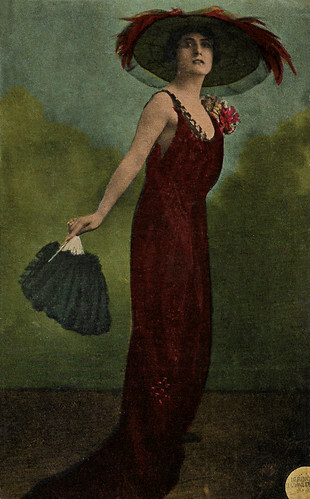
Spanish collectors card by Chocolat Imperiale, no. 1 of 10. Photo: Bertini Film / Caesar Film, Roma / Distr. J. Gurgui, Barcelona. Francesca Bertini in L'avarizia/ Greed (Gustavo Serena, 1918).
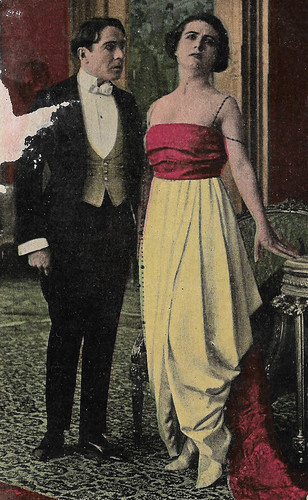
Spanish collectors card by Chocolat Imperiale, no. 2 of 10. Photo: Bertini Film / Caesar Film, Roma / Distr. J. Gurgui, Barcelona. Francesca Bertini in L'avarizia/Greed (Gustavo Serena, 1918). The man on this card may be Alfredo Bracci.
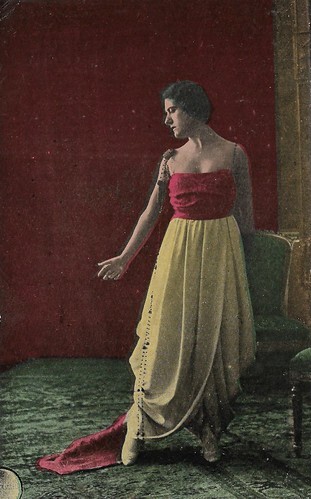
Spanish collectors card by Chocolat Imperiale, no. 3 of 10. Photo: Bertini Film / Caesar Film, Roma / Distr. J. Gurgui, Barcelona. Francesca Bertini in L'avarizia/Greed (Gustavo Serena, 1918).
Greed
L'avarizia/Greed (Gustavo Serena, 1918) was scripted by Giuseppe Paolo Pacchierotti, while the cinematography was by Luigi Filippa. The film was part of the series I sette peccati capitali/The Seven Deadly Sins (1918-1919), produced by Caesar Film and Bertini Film and distributed by U.C.I.
In L'avarizia, Maria ( Francesca Bertini ) and Luigi ( Gustavo Serena ) love each other in spite of their poverty, while she resists her many wealthy suitors. But their mutual enemies figure out a lie that will separate them.
Maria will become temporarily rich but she commits a crime and will divert into the slums. There Luigi will meet her again.
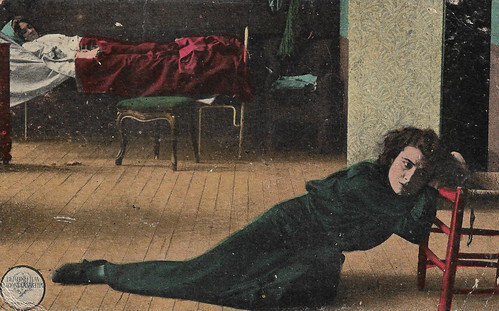
Spanish collectors card by Chocolat Imperiale, no. 4 of 10. Photo: Bertini Film / Caesar Film, Roma / Distr. J. Gurgui, Barcelona. Francesca Bertini in L'avarizia/Greed (Gustavo Serena, 1918).
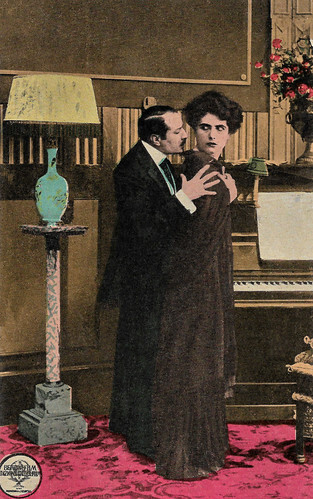
Spanish collectors card by Chocolat Imperiale, no. 5 of 10. Photo: Bertini Film / Caesar Film, Roma / Distr. J. Gurgui, Barcelona. Francesca Bertini in L'avarizia/Greed (Gustavo Serena, 1918).
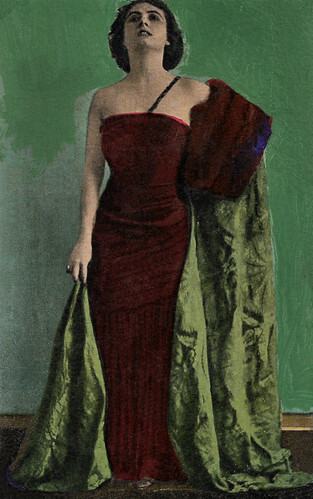
Spanish collectors card by Chocolat Imperiale, no. 6 of 10. Photo: Bertini Film / Caesar Film, Roma / Distr. J. Gurgui, Barcelona. Francesca Bertini in L'avarizia/Greed (Gustavo Serena, 1918).
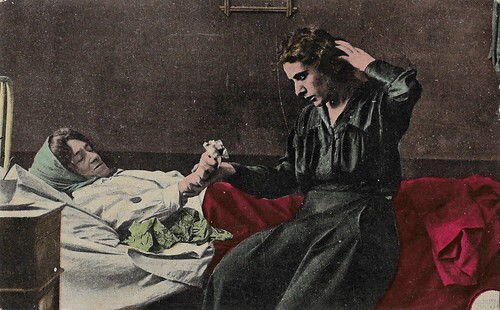
Spanish collectors card by Chocolat Imperiale, no. 9 of 10. Photo: Bertini Film / Caesar Film, Roma / Distr. J. Gurgui, Barcelona. Francesca Bertini in L'avarizia/Greed (Gustavo Serena, 1918).
L'ira (1918)
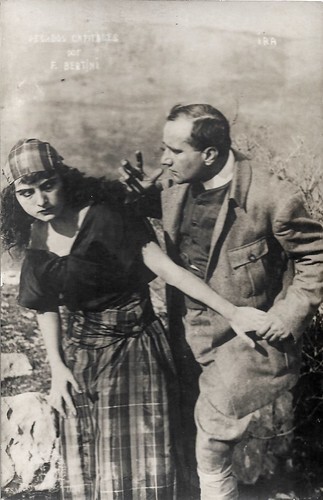
Spanish postcard. Francesca Bertini and Gustavo Serena in L'ira/Anger (Edoardo Bencivenga, 1918).
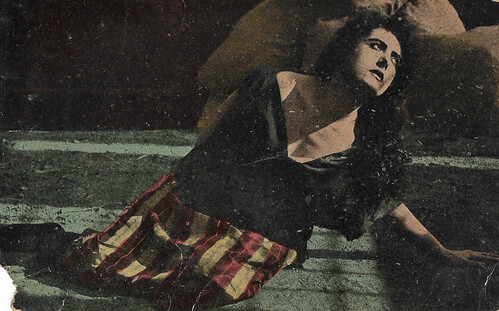
Spanish collectors card by Chocolat Imperiale, no. 4 of 10. Photo: Bertini Film / Caesar Film, Roma / Distr. J. Gurgui, Barcelona. Francesca Bertini in L'ira/Anger (Edoardo Bencivenga, 1918).
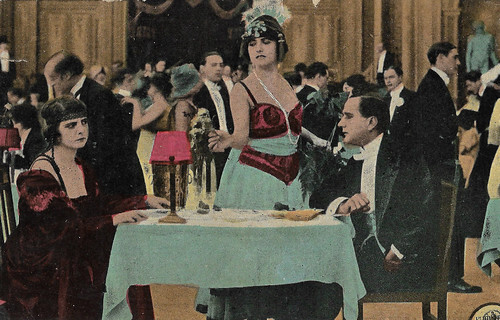
Spanish collectors card by Chocolat Imperiale, no. 5 of 10. Photo: Bertini Film / Caesar Film, Roma / Distr. J. Gurgui, Barcelona. Cia Fornaroli, Francesca Bertini and Gustavo Serena in L'ira/Anger (Edoardo Bencivenga, 1918)
Anger
In L'ira/Anger (Edoardo Bencivenga, 1918) the two gipsy brothers Zefor (Alberto Albertini) and Arturo (Guido Trento), their mother and the gipsy girl Elena ( Francesca Bertini ) live together near the border. They live on smuggling and Arturo is protective of Elena.
One day, Count Amedeo Montaperti ( Gustavo Serena ) has an accident and is taken care of by them. He feels attracted to Elena, but when he is rejected he menaces to denounce them.
The first flame of anger develops: Elena invites him to a rendezvous but instead Arturo shows up and throws him in a ravine. Once her anger is tempered, Elena searches for Amedeo, finds him and takes care of him. When she finds out that his previous sharp remarks were because of a previous wound in love, her anger completely disappears.
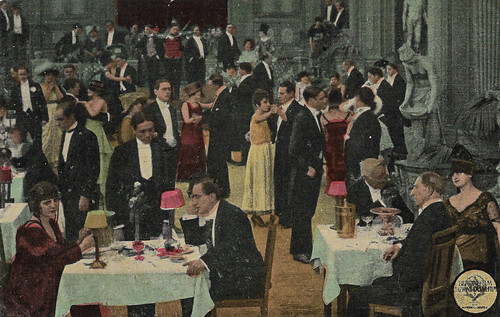
Spanish collectors card by Chocolat Imperiale, no. 6 of 10. Photo: Bertini Film / Caesar Film, Roma / Distr. J. Gurgui, Barcelona. Cia Fornaroli and Gustavo Serena in L'ira/Anger (Edoardo Bencivenga, 1918).
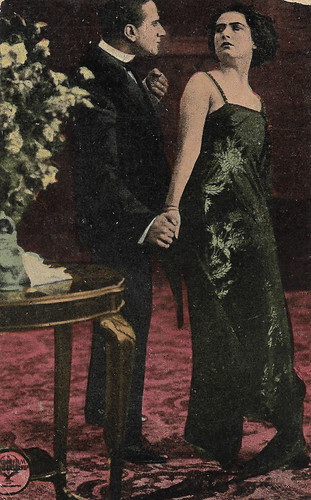
Spanish collectors card by Chocolat Imperiale, no. 8 of 10. Photo: Bertini Film / Caesar Film, Roma / Distr. J. Gurgui, Barcelona. Francesca Bertini and Gustavo Serena in L'ira/Anger (Edoardo Bencivenga, 1918)
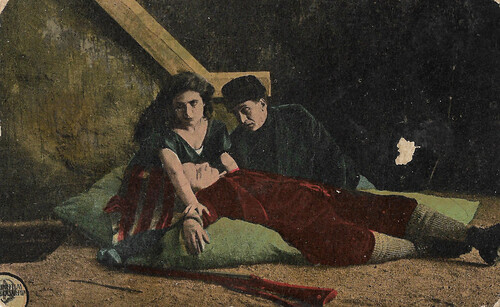
Spanish collectors card by Chocolat Imperiale, no. 9 of 10. Photo: Bertini Film / Caesar Film, Roma / Distr. J. Gurgui, Barcelona. Francesca Bertini and Gustavo Serena in L'ira/Anger (Edoardo Bencivenga, 1918)
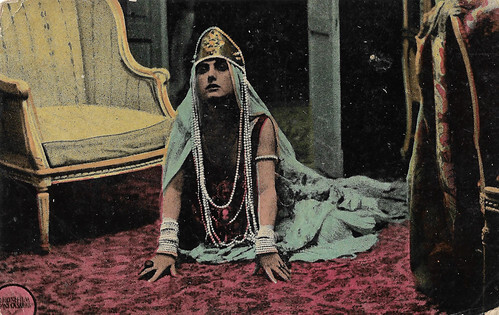
Spanish collectors card by Chocolat Imperiale, no. 10 of 10. Photo: Bertini Film / Caesar Film, Roma / Distr. J. Gurgui, Barcelona. Francesca Bertini in L'ira/Anger (Edoardo Bencivenga, 1918).
L'invidia (1919)
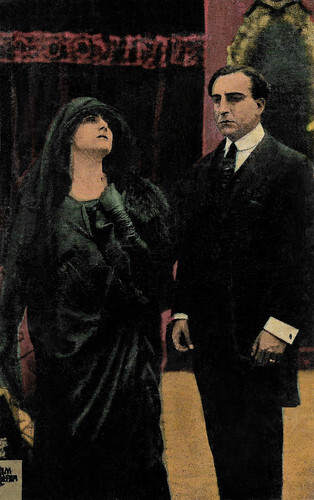
Spanish collectors card by Chocolat Imperiale, no. 4 of 10. Photo: Bertini Film / Caesar Film, Roma / Distr. J. Gurgui, Barcelona. Francesca Bertini in L'invidia/Envy (Edoardo Bencivenga, 1918).
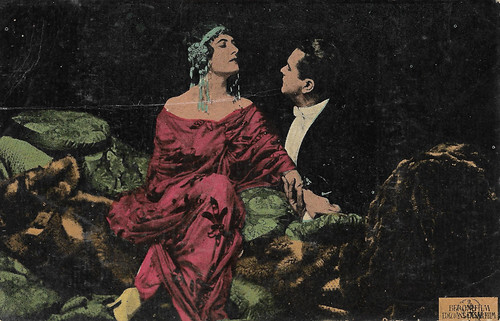
Spanish collectors card by Chocolat Imperiale, no. 5 of 10. Photo: Bertini Film / Caesar Film, Roma / Distr. J. Gurgui, Barcelona. Francesca Bertini and Livio Pavanelli in L'invidia/Envy (Edoardo Bencivenga, 1918).
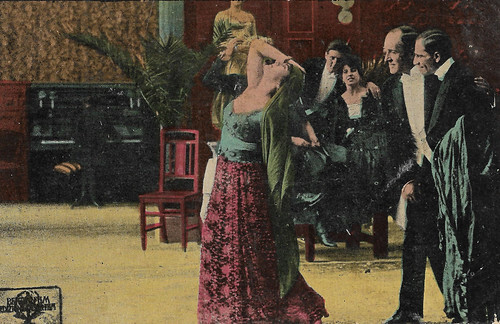
Spanish collectors card by Chocolat Imperiale, no. 6 of 10. Photo: Bertini Film / Caesar Film, Roma / Distr. J. Gurgui, Barcelona. Francesca Bertini in L'invidia/Envy (Edoardo Bencivenga, 1918).
Envy
In L'invidia/Envy (Edoardo Bencivenga, 1918), Francesca Bertini plays the ballet dancer Leila di Santa Cruz. She has an adventure with young Count Di Monfiore ( Livio Pavanelli ) and a child is born. Because of her conduct, the count abandons her and takes the child with him.
Years after, the mother returns and fights to have her daughter back, after being told out of pure envy that the baby had died in an accident. Instead, the count and his legitimate wife (Giulietta D'Arienzo) have raised the child as theirs.
The discovery of this secret favours those who envy the young and rich countess, but in the end to no avail.
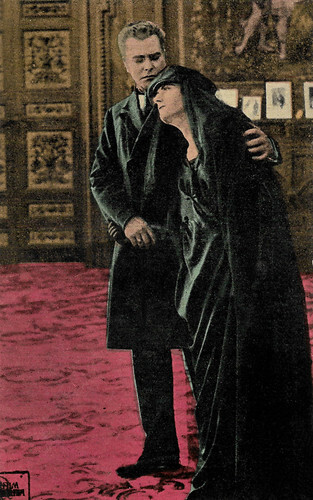
Spanish collectors card by Chocolat Imperiale, no. 7 of 10. Photo: Bertini Film / Caesar Film, Roma / Distr. J. Gurgui, Barcelona. Francesca Bertini and Livio Pavanelli in L'invidia/Envy (Edoardo Bencivenga, 1918).
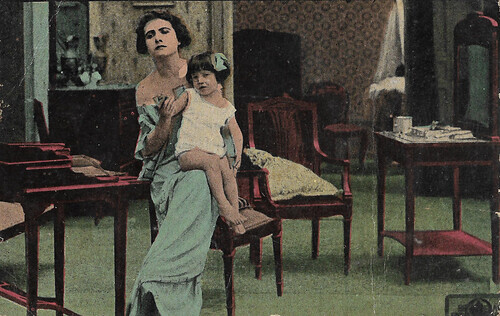
Spanish collectors card by Chocolat Imperiale, no. 8 of 10. Photo: Bertini Film / Caesar Film, Roma / Distr. J. Gurgui, Barcelona. Francesca Bertini in L'invidia/Envy (Edoardo Bencivenga, 1918).
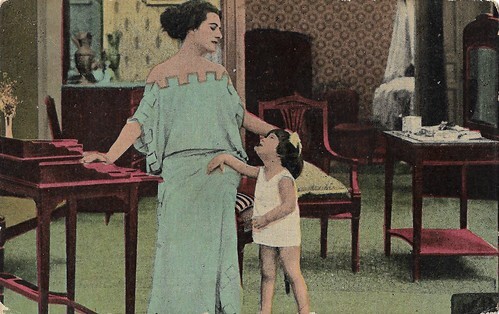
Spanish collectors card by Chocolat Imperiale, no. 10 of 10. Photo: Bertini Film / Caesar Film, Roma / Distr. J. Gurgui, Barcelona. Francesca Bertini in L'invidia/Envy (Edoardo Bencivenga, 1918).
La lussuria (1919)
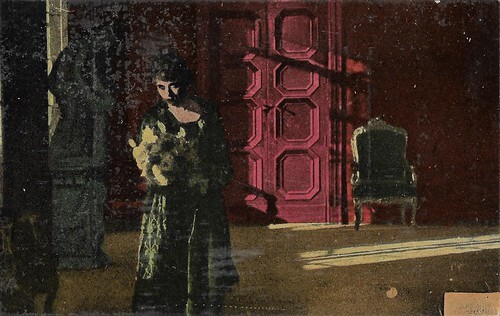
Spanish collectors card by Chocolat Imperiale, no. 1 of 10. Photo: Bertini Film / Caesar Film, Roma / Distr. J. Gurgui, Barcelona. Francesca Bertini in La lussuria/Lust (Edoardo Bencivenga, 1919).
Lust
According to IMDb the plot of La lussuria/Lust (Edoardo Bencivenga, 1919) is this: Leonard ( Livio Pavanelli ), a poor cashier, is arduously attracted to the beautiful but despising Magdalena Dutertre (Bertini). When time goes by and he becomes a powerful banker, her elusiveness turns to fire.
According to Vittorio Martinelli, based on Paiman's Filmliste, this is the plot: The daughter of an industrialist who has been ruined by a rival takes revenge on the latter by seducing whom with all of her forces. She first manages to ruin him financially, and finally forces him to commit suicide.
At the time, the Roman critic Zac (C. Zappia) wrote he was glad that, finally, the series was over, with its repetitive plots and performances. Yet, he had to admit that the audiences flocked to the bourgeois cinemas like the Quatro Fontane and Cinema Regina to see the film and their beloved star, and the film thus was a commercial success.
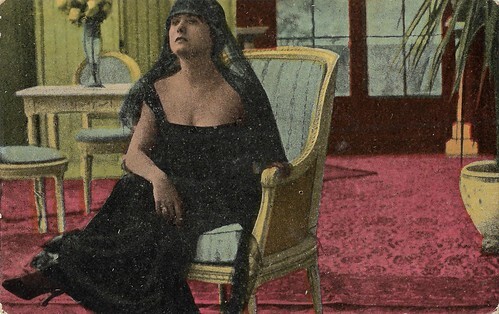
Spanish collectors card by Chocolat Imperiale, no. 7 of 10. Photo: Bertini Film / Caesar Film, Roma / Distr. J. Gurgui, Barcelona. Francesca Bertini in La lussuria/Lust (Edoardo Bencivenga, 1919).
For more than half a century, the integral version of I sette peccati capitali was believed to be lost. It was found at the Prague Film Institute (Ceskoslovensky Filmovy Archiv) and carefully restored including the tinting. In 1991, two series parts were shown at Il Cinema Ritrovato in Bologna. Finally, the complete series was presented in Bologna in 2003. It includes the features L'orgoglio/Pride, La gola/Gluttony, L'ira/Wrath, L'avarizia/Greed (all 1918), L'invidia/Envy, L'accidia/Sloth and La lussuria/Lust (all 1919).
In the past, EFSP already posted on L'orgoglio (Edoardo Bencivenga, 1918), L'accidia (Alfredo De Antoni, 1919) and La gola (Camillo De Riso, 1918). Today, we present the four other parts: L'avarizia/Greed (Gustavo Serena, 1918), L'ira/Anger (1918), L'invidia/Envy (1919) and La lussuria/Lust (1919), all starring Francesca Bertini.
L'avarizia (1918)

Spanish collectors card by Chocolat Imperiale, no. 1 of 10. Photo: Bertini Film / Caesar Film, Roma / Distr. J. Gurgui, Barcelona. Francesca Bertini in L'avarizia/ Greed (Gustavo Serena, 1918).

Spanish collectors card by Chocolat Imperiale, no. 2 of 10. Photo: Bertini Film / Caesar Film, Roma / Distr. J. Gurgui, Barcelona. Francesca Bertini in L'avarizia/Greed (Gustavo Serena, 1918). The man on this card may be Alfredo Bracci.

Spanish collectors card by Chocolat Imperiale, no. 3 of 10. Photo: Bertini Film / Caesar Film, Roma / Distr. J. Gurgui, Barcelona. Francesca Bertini in L'avarizia/Greed (Gustavo Serena, 1918).
Greed
L'avarizia/Greed (Gustavo Serena, 1918) was scripted by Giuseppe Paolo Pacchierotti, while the cinematography was by Luigi Filippa. The film was part of the series I sette peccati capitali/The Seven Deadly Sins (1918-1919), produced by Caesar Film and Bertini Film and distributed by U.C.I.
In L'avarizia, Maria ( Francesca Bertini ) and Luigi ( Gustavo Serena ) love each other in spite of their poverty, while she resists her many wealthy suitors. But their mutual enemies figure out a lie that will separate them.
Maria will become temporarily rich but she commits a crime and will divert into the slums. There Luigi will meet her again.

Spanish collectors card by Chocolat Imperiale, no. 4 of 10. Photo: Bertini Film / Caesar Film, Roma / Distr. J. Gurgui, Barcelona. Francesca Bertini in L'avarizia/Greed (Gustavo Serena, 1918).

Spanish collectors card by Chocolat Imperiale, no. 5 of 10. Photo: Bertini Film / Caesar Film, Roma / Distr. J. Gurgui, Barcelona. Francesca Bertini in L'avarizia/Greed (Gustavo Serena, 1918).

Spanish collectors card by Chocolat Imperiale, no. 6 of 10. Photo: Bertini Film / Caesar Film, Roma / Distr. J. Gurgui, Barcelona. Francesca Bertini in L'avarizia/Greed (Gustavo Serena, 1918).

Spanish collectors card by Chocolat Imperiale, no. 9 of 10. Photo: Bertini Film / Caesar Film, Roma / Distr. J. Gurgui, Barcelona. Francesca Bertini in L'avarizia/Greed (Gustavo Serena, 1918).
L'ira (1918)

Spanish postcard. Francesca Bertini and Gustavo Serena in L'ira/Anger (Edoardo Bencivenga, 1918).

Spanish collectors card by Chocolat Imperiale, no. 4 of 10. Photo: Bertini Film / Caesar Film, Roma / Distr. J. Gurgui, Barcelona. Francesca Bertini in L'ira/Anger (Edoardo Bencivenga, 1918).

Spanish collectors card by Chocolat Imperiale, no. 5 of 10. Photo: Bertini Film / Caesar Film, Roma / Distr. J. Gurgui, Barcelona. Cia Fornaroli, Francesca Bertini and Gustavo Serena in L'ira/Anger (Edoardo Bencivenga, 1918)
Anger
In L'ira/Anger (Edoardo Bencivenga, 1918) the two gipsy brothers Zefor (Alberto Albertini) and Arturo (Guido Trento), their mother and the gipsy girl Elena ( Francesca Bertini ) live together near the border. They live on smuggling and Arturo is protective of Elena.
One day, Count Amedeo Montaperti ( Gustavo Serena ) has an accident and is taken care of by them. He feels attracted to Elena, but when he is rejected he menaces to denounce them.
The first flame of anger develops: Elena invites him to a rendezvous but instead Arturo shows up and throws him in a ravine. Once her anger is tempered, Elena searches for Amedeo, finds him and takes care of him. When she finds out that his previous sharp remarks were because of a previous wound in love, her anger completely disappears.

Spanish collectors card by Chocolat Imperiale, no. 6 of 10. Photo: Bertini Film / Caesar Film, Roma / Distr. J. Gurgui, Barcelona. Cia Fornaroli and Gustavo Serena in L'ira/Anger (Edoardo Bencivenga, 1918).

Spanish collectors card by Chocolat Imperiale, no. 8 of 10. Photo: Bertini Film / Caesar Film, Roma / Distr. J. Gurgui, Barcelona. Francesca Bertini and Gustavo Serena in L'ira/Anger (Edoardo Bencivenga, 1918)

Spanish collectors card by Chocolat Imperiale, no. 9 of 10. Photo: Bertini Film / Caesar Film, Roma / Distr. J. Gurgui, Barcelona. Francesca Bertini and Gustavo Serena in L'ira/Anger (Edoardo Bencivenga, 1918)

Spanish collectors card by Chocolat Imperiale, no. 10 of 10. Photo: Bertini Film / Caesar Film, Roma / Distr. J. Gurgui, Barcelona. Francesca Bertini in L'ira/Anger (Edoardo Bencivenga, 1918).
L'invidia (1919)

Spanish collectors card by Chocolat Imperiale, no. 4 of 10. Photo: Bertini Film / Caesar Film, Roma / Distr. J. Gurgui, Barcelona. Francesca Bertini in L'invidia/Envy (Edoardo Bencivenga, 1918).

Spanish collectors card by Chocolat Imperiale, no. 5 of 10. Photo: Bertini Film / Caesar Film, Roma / Distr. J. Gurgui, Barcelona. Francesca Bertini and Livio Pavanelli in L'invidia/Envy (Edoardo Bencivenga, 1918).

Spanish collectors card by Chocolat Imperiale, no. 6 of 10. Photo: Bertini Film / Caesar Film, Roma / Distr. J. Gurgui, Barcelona. Francesca Bertini in L'invidia/Envy (Edoardo Bencivenga, 1918).
Envy
In L'invidia/Envy (Edoardo Bencivenga, 1918), Francesca Bertini plays the ballet dancer Leila di Santa Cruz. She has an adventure with young Count Di Monfiore ( Livio Pavanelli ) and a child is born. Because of her conduct, the count abandons her and takes the child with him.
Years after, the mother returns and fights to have her daughter back, after being told out of pure envy that the baby had died in an accident. Instead, the count and his legitimate wife (Giulietta D'Arienzo) have raised the child as theirs.
The discovery of this secret favours those who envy the young and rich countess, but in the end to no avail.

Spanish collectors card by Chocolat Imperiale, no. 7 of 10. Photo: Bertini Film / Caesar Film, Roma / Distr. J. Gurgui, Barcelona. Francesca Bertini and Livio Pavanelli in L'invidia/Envy (Edoardo Bencivenga, 1918).

Spanish collectors card by Chocolat Imperiale, no. 8 of 10. Photo: Bertini Film / Caesar Film, Roma / Distr. J. Gurgui, Barcelona. Francesca Bertini in L'invidia/Envy (Edoardo Bencivenga, 1918).

Spanish collectors card by Chocolat Imperiale, no. 10 of 10. Photo: Bertini Film / Caesar Film, Roma / Distr. J. Gurgui, Barcelona. Francesca Bertini in L'invidia/Envy (Edoardo Bencivenga, 1918).
La lussuria (1919)

Spanish collectors card by Chocolat Imperiale, no. 1 of 10. Photo: Bertini Film / Caesar Film, Roma / Distr. J. Gurgui, Barcelona. Francesca Bertini in La lussuria/Lust (Edoardo Bencivenga, 1919).
Lust
According to IMDb the plot of La lussuria/Lust (Edoardo Bencivenga, 1919) is this: Leonard ( Livio Pavanelli ), a poor cashier, is arduously attracted to the beautiful but despising Magdalena Dutertre (Bertini). When time goes by and he becomes a powerful banker, her elusiveness turns to fire.
According to Vittorio Martinelli, based on Paiman's Filmliste, this is the plot: The daughter of an industrialist who has been ruined by a rival takes revenge on the latter by seducing whom with all of her forces. She first manages to ruin him financially, and finally forces him to commit suicide.
At the time, the Roman critic Zac (C. Zappia) wrote he was glad that, finally, the series was over, with its repetitive plots and performances. Yet, he had to admit that the audiences flocked to the bourgeois cinemas like the Quatro Fontane and Cinema Regina to see the film and their beloved star, and the film thus was a commercial success.

Spanish collectors card by Chocolat Imperiale, no. 7 of 10. Photo: Bertini Film / Caesar Film, Roma / Distr. J. Gurgui, Barcelona. Francesca Bertini in La lussuria/Lust (Edoardo Bencivenga, 1919).
Published on February 14, 2023 22:00
February 13, 2023
La Collectionneuse: Valentine's Day 2023
Let’s celebrate Valentine’s day with 16 postcards featuring film couples. To introduce them and to put you in the mood, you will also find Deanna Durbin, posing in front of a gigantic heart.
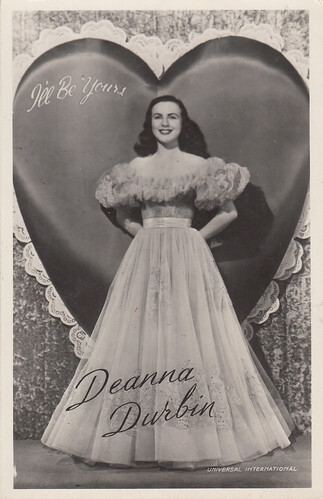
Dutch postcard, no. 3535. Photo: Universal International. Deanna Durbin in I’ll be Yours (William A. Seiter, 1947).
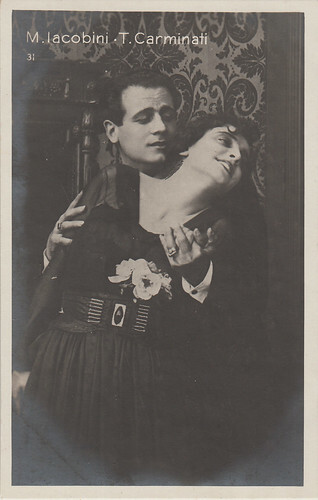
Italian postcard by G. Vettori, Bologna, no. 31. Maria Jacobini and Tullio Carminati in L’articolo IV/Article IV (Gennaro Righelli, 1918).
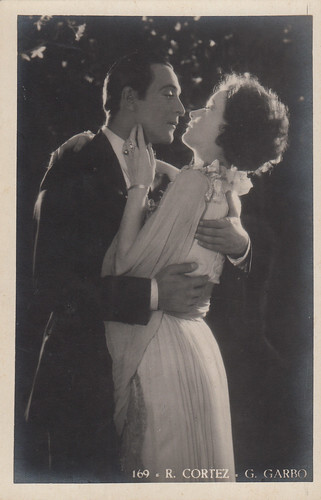
Italian postcard, no. 169. Greta Garbo and Ricardo Cortez in Torrent (Monta Bell, 1926).
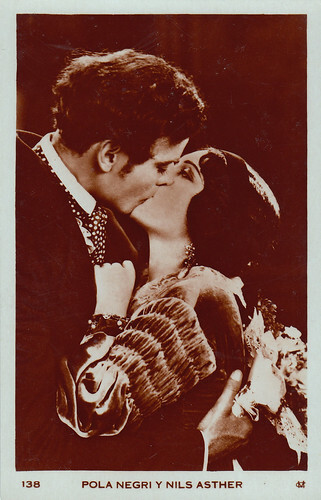
Spanish postcard by MC, Barcelona, no. 138. Pola Negri and Nils Asther in Loves of an Actress (Rowland V. Lee, 1928).
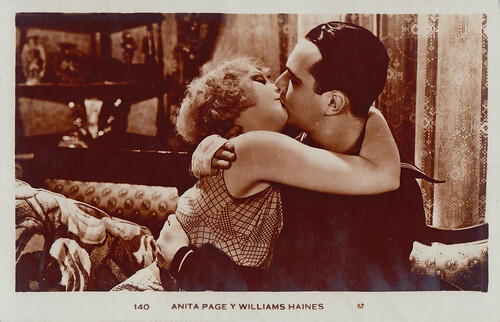
Spanish postcard by MC Barcelona, no. 140. Anita Page and William Haines in Navy Blues (Clarence Brown, 1929).
Anita Page and William Haines , who were both under contract to M.G.M., co-starred in four movies from 1928 to 1932.
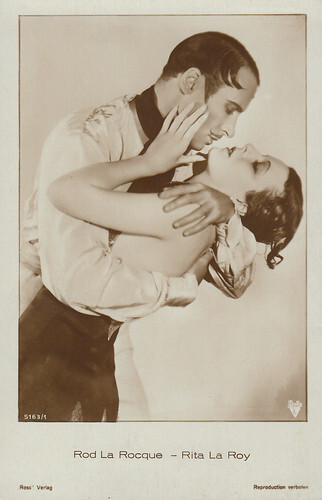
German postcard by Ross Verlag, no. 5163/1, 1930-1931. Photo: Radio. Rita La Roy and Rod La Rocque in The Delightful Rogue (Lynn Shores, 1929).
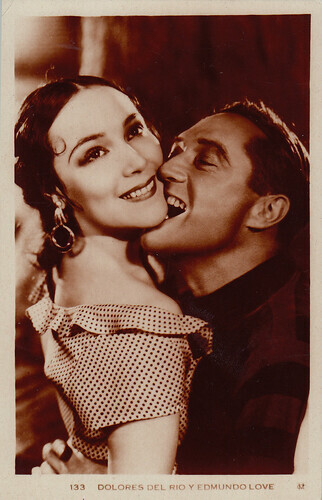
Spanish postcard by MC, Barcelona, no. 133. Dolores Del Rio and Edmund Lowe in The Bad One (George Fitzmaurice, 1930).
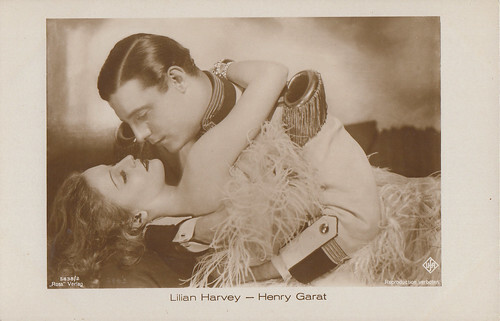
German postcard by Ross Verlag, no. 5838/2, 1930-1931. Photo: Ufa. Lilian Harvey and Henri Garat (as Henry Garat) in Princesse, à vos ordres!/Her Highness Coomands (Hanns Schwarz, Max de Baucorbeil, 1931).
Lilian Harvey and Henri Garat co-starred in seven movies from 1930 to 1936 and formed together a very popular cinematographic couple.
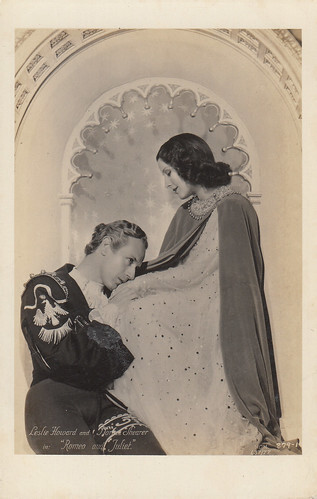
Postcard from the Dutch East Indies (now Indonesia), no. L37/77. Photo: MGM. Norma Shearer and Leslie Howard in Romeo and Juliet (George Cukor, 1936).
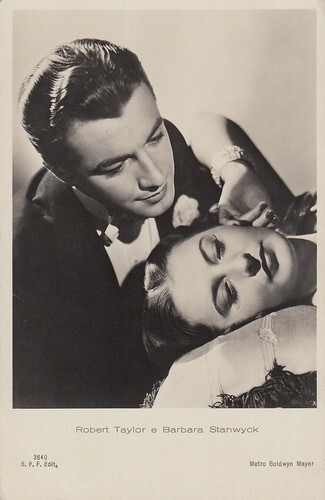
Italian postcard by Ballerini & Fratini, Firenze, no. 3640. Photo: Metro Goldwyn Mayer. Barbara Stanwyck and Robert Taylor in His Brother's Wife (W.S. Van Dyke, 1936).
Barbara Stanwyck and Robert Taylor were married from 1939 to 1952.
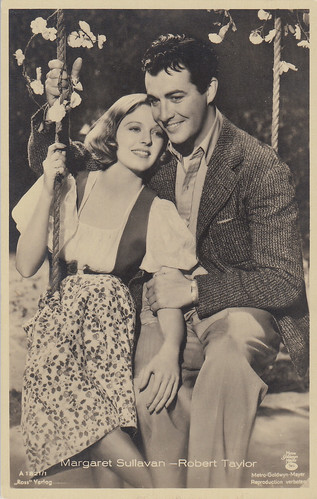
German postcard by Ross Verlag, no. A1821/1, 1937-1938. Photo: Metro Goldwyn Mayer. Margaret Sullavan and Robert Taylor in Three Comrades (Frank Borzage, 1938).
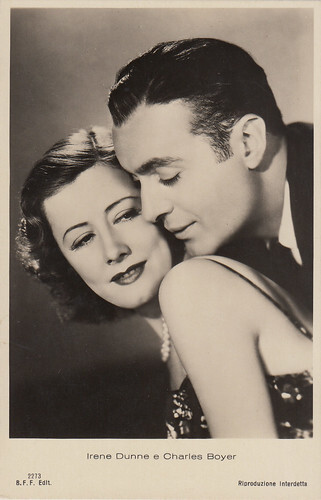
Italian postcard by Ballerini & Fratini, Firenze, no. 3640. Irene Dunne and Charles Boyer in When Tomorrow Comes (John M. Stahl, 1939).
Irene Dunne and Charles Boyer co-starred in Love Affair (1939), When Tomorrow Comes (1939) and Together Again (1944). They got along very well and had great screen chemistry together.
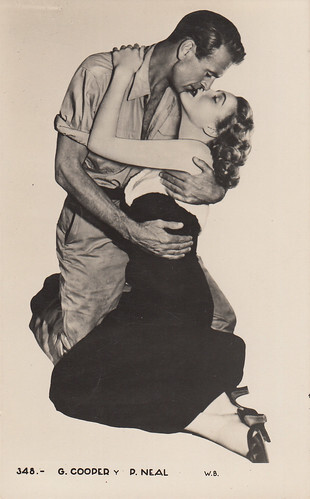
Spanish postcard, no. 348. Photo: Warner Bros. Patricia Neal and Gary Cooper in The Fountainhead (King Vidor, 1949).
Patricia Neal and Gary Cooper , who was married since 1933 to Veronica "Rocky" Balfe, fell in love in 1948 during the filming of The Fountainhead. According to Patricia Neal, she got pregnant and had an abortion in 1950. Their passionate affair ended in December 1951.
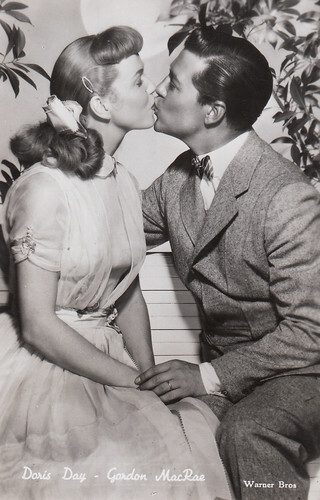
Belgian postcard. Photo: Warner Bros. Doris Day and Gordon MacRae in On Moonlight Bay (Roy Del Ruth, 1951).
Doris Day and Gordon MacRae co-starred in five Warner musicals from 1950 to 1953.
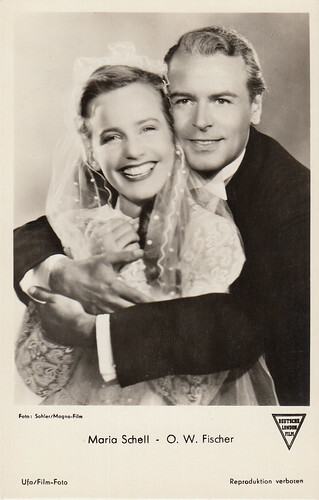
German postcard by Universum-Film A.G., Abt. Film-Foto, Berlin-Tempelhof, no. FK 351. Photo: Sohler / Magna Film / Deutsche London Film. Maria Schell and O.W. Fischer in Tagebuch einer Verliebten/Diary of a Married Woman (1953) (Josef von Báky, 1953).
Maria Schell and O.W. Fischer co-starred in four movies in 1952 and 1953 and were at the time one of the "dream couples of the German cinema". In 1961, they were reunited in Das Riesenrad.
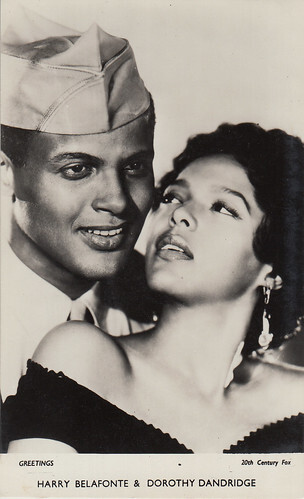
British postcard in the Greetings series. Photo: 20th Century Fox. Dorothy Dandridge and Harry Belafonte in Carmen Jones (Otto Preminger, 1954).
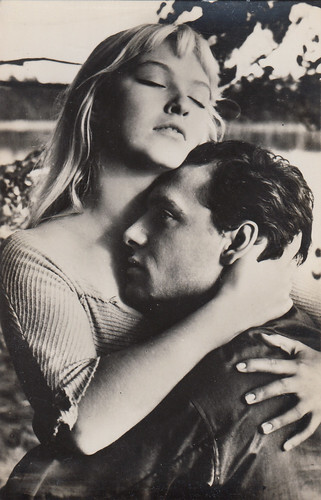
Spanish postcard, no. 12. Marina Vlady and Maurice Ronet in La sorcière/Häxan (André Michel, 1956).
Text and postcards: Marlene Pilaete. And, Happy Valentine's Day!

Dutch postcard, no. 3535. Photo: Universal International. Deanna Durbin in I’ll be Yours (William A. Seiter, 1947).

Italian postcard by G. Vettori, Bologna, no. 31. Maria Jacobini and Tullio Carminati in L’articolo IV/Article IV (Gennaro Righelli, 1918).

Italian postcard, no. 169. Greta Garbo and Ricardo Cortez in Torrent (Monta Bell, 1926).

Spanish postcard by MC, Barcelona, no. 138. Pola Negri and Nils Asther in Loves of an Actress (Rowland V. Lee, 1928).

Spanish postcard by MC Barcelona, no. 140. Anita Page and William Haines in Navy Blues (Clarence Brown, 1929).
Anita Page and William Haines , who were both under contract to M.G.M., co-starred in four movies from 1928 to 1932.

German postcard by Ross Verlag, no. 5163/1, 1930-1931. Photo: Radio. Rita La Roy and Rod La Rocque in The Delightful Rogue (Lynn Shores, 1929).

Spanish postcard by MC, Barcelona, no. 133. Dolores Del Rio and Edmund Lowe in The Bad One (George Fitzmaurice, 1930).

German postcard by Ross Verlag, no. 5838/2, 1930-1931. Photo: Ufa. Lilian Harvey and Henri Garat (as Henry Garat) in Princesse, à vos ordres!/Her Highness Coomands (Hanns Schwarz, Max de Baucorbeil, 1931).
Lilian Harvey and Henri Garat co-starred in seven movies from 1930 to 1936 and formed together a very popular cinematographic couple.

Postcard from the Dutch East Indies (now Indonesia), no. L37/77. Photo: MGM. Norma Shearer and Leslie Howard in Romeo and Juliet (George Cukor, 1936).

Italian postcard by Ballerini & Fratini, Firenze, no. 3640. Photo: Metro Goldwyn Mayer. Barbara Stanwyck and Robert Taylor in His Brother's Wife (W.S. Van Dyke, 1936).
Barbara Stanwyck and Robert Taylor were married from 1939 to 1952.

German postcard by Ross Verlag, no. A1821/1, 1937-1938. Photo: Metro Goldwyn Mayer. Margaret Sullavan and Robert Taylor in Three Comrades (Frank Borzage, 1938).

Italian postcard by Ballerini & Fratini, Firenze, no. 3640. Irene Dunne and Charles Boyer in When Tomorrow Comes (John M. Stahl, 1939).
Irene Dunne and Charles Boyer co-starred in Love Affair (1939), When Tomorrow Comes (1939) and Together Again (1944). They got along very well and had great screen chemistry together.

Spanish postcard, no. 348. Photo: Warner Bros. Patricia Neal and Gary Cooper in The Fountainhead (King Vidor, 1949).
Patricia Neal and Gary Cooper , who was married since 1933 to Veronica "Rocky" Balfe, fell in love in 1948 during the filming of The Fountainhead. According to Patricia Neal, she got pregnant and had an abortion in 1950. Their passionate affair ended in December 1951.

Belgian postcard. Photo: Warner Bros. Doris Day and Gordon MacRae in On Moonlight Bay (Roy Del Ruth, 1951).
Doris Day and Gordon MacRae co-starred in five Warner musicals from 1950 to 1953.

German postcard by Universum-Film A.G., Abt. Film-Foto, Berlin-Tempelhof, no. FK 351. Photo: Sohler / Magna Film / Deutsche London Film. Maria Schell and O.W. Fischer in Tagebuch einer Verliebten/Diary of a Married Woman (1953) (Josef von Báky, 1953).
Maria Schell and O.W. Fischer co-starred in four movies in 1952 and 1953 and were at the time one of the "dream couples of the German cinema". In 1961, they were reunited in Das Riesenrad.

British postcard in the Greetings series. Photo: 20th Century Fox. Dorothy Dandridge and Harry Belafonte in Carmen Jones (Otto Preminger, 1954).

Spanish postcard, no. 12. Marina Vlady and Maurice Ronet in La sorcière/Häxan (André Michel, 1956).
Text and postcards: Marlene Pilaete. And, Happy Valentine's Day!
Published on February 13, 2023 22:00
February 12, 2023
Directed by Richard Oswald
Richard Oswald (1880-1963) was a groundbreaking Austrian director, producer, and screenwriter of many German as well as a few American, British and French films plus a Dutch film. Oswald directed nearly 100 films and was a pioneer in genres like Horror films and Aufklärungsfilme (enlightenment films). After making many successful films and discovering several important performers, he fled his homeland after the Nazi takeover and eventually settled in the US. He was the father of German-American film director and producer Gerd Oswald.
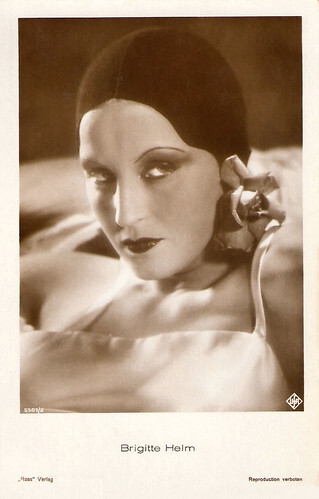
German postcard by Ross Verlag, no. 5501/2. Distributed in Italy by Ballerini & Frattini, Florence. Photo: Ufa. Brigitte Helm in Alraune (Richard Oswald, 1930).

German postcard by Rotophot in the Film Sterne series, no. 529/2. Photo: Richard Oswald-Film. Erna Morena in Das Tagebuch einer Verlorenen/The Diary of a Lost Woman (Richard Oswald, 1918).

German postcard by Ross Verlag, Berlin, no. 616/2. Photo: Richard-Oswald-Film. Reinhold Schünzel and Ilka Grüning in Die sich verkaufen, part 2 of the series Prostitution (Richard Oswald, 1919).
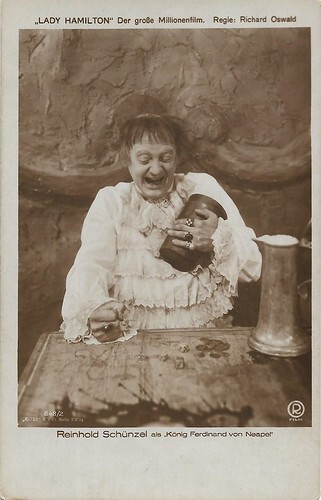
German postcard by Ross Verlag, Berlin, no. 648/2. Photo: Richard Oswald-Film. Reinhold Schünzel as King Ferdinand IV of Naples in Lady Hamilton (Richard Oswald, 1921). Caption: The big millions film.
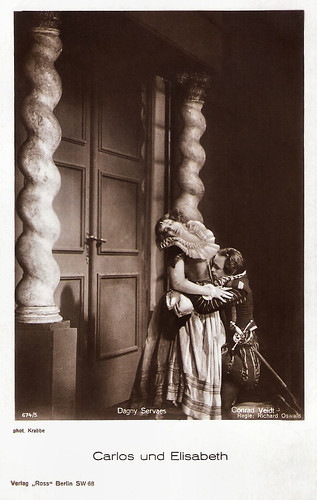
German postcard by Ross Verlag, Berlin, no. 674/5. Photo: Krabbe / Richard-Oswald-Film. Dagny Servaes and Conrad Veidt in Carlos und Elisabeth/Carlos and Elisabeth (Richard Oswald, 1924).
He tried his hand at almost every genre
Richard Oswald was born in Vienna, Austria-Hungary (now Austria), as Richard W. Ornstein in 1880. His father was Alois Ornstein, a wealthy merchant and devout Jew, and his mother was his wife Fanny, née Bruck. Oswald studied at the Wiener Dramatischen Hochschule (Vienna Dramatic Academy) from 1896. He took his stage name from a character in Henrik Ibsen's 'Ghosts'.
He began his career as a stage actor and stagehand at Süddeutschen Novitäten-Ensemble (South German Novelty Ensemble) in Berchtesgaden in 1899. He moved to Znaim (Znojmo) the following year. There, Oswald met his colleague Bernd Aldor , whom he was later to bring before the camera several times with leading roles during the First World War. Via Preßburg he moved to the Vienna Raimundtheater in 1907, and in 1909 to the Theater in der Josefstadt, where he also worked as a dramaturge and director. After anti-Semitic hostility, he went to work as an actor at the Düsseldorf Schauspielhaus in 1910. Here he met the actress Käte Waldeck and married her in Berlin in 1913. There their daughter Ruth was born as their first child. He had made his film debut as an actor in Halbwelt/Demimonde (Reinhard Bruck, 1911) and Zouza (Reinhard Bruck, 1911), but didn't really want to be an actor and didn't last very long at it.
His childhood friend Hermann Fellner hired him in 1914 as a dramaturge and advertising expert for the film company Deutsche Vitascope GmbH, which merged with the projection company "Union" (PAGU) shortly afterwards. With his third screenplay, an adaptation of Arthur Conan Doyle's 'The Hound of the Baskervilles', Der Hund von Baskerville (Rudolf Meinert, 1914), Oswald established himself as an author of crowd-pleasing material. From the outbreak of the First World War, Oswald, who was unfit for military service, was also given the chance to direct films himself. At age 34, Oswald's first film as a director was Ivan Koschula (Richard Oswald, 1914). He then made Das eiserne Kreuz/The Iron Cross (Richard Oswald, 1914) starring Friedrich Kühne, Hedda Vernon , and Hanni Weisse . (Some sources say this was his directorial debut). Despite its patriotic name, the film was seized by the German authorities and all its copies were destroyed due to the film's pacifist nature. The film was shot for Vitascope Film at the Tempelhof Studios in the German capital of Berlin.
Oswald worked a number of times for producers Jules Greenbaum and Paul Davidson at the PAGU. Their Lache Bajazzo/Laugh Bajazzo (Richard Oswald, 1915) is a silent drama film starring Rudolph Schildkraut, Alfred Abel and Hanni Weisse . It was shot at the Weissensee Studios in Berlin. In 1915 he joined the newly founded Greenbaum-Film GmbH as head director and writer, where he continued the Baskerville series. Oswald created the German detective Engelbert Fox for Lothar Stark and directed the film debut of Werner Krauß with Hoffmanns Erzählungen (Richard Oswald, 1916).
In 1916, Oswald founded his own production company in Berlin, Richard Oswald-Film GmbH, writing and directing most of his films himself. He tried his hand at almost every genre. Oswald worked together with Werner Krauß , Lupu Pick and Reinhold Schünzel and discovered Lya de Putti and Conrad Veidt for the film. His early productions included horror films such as Nächte des Grauens/A Night of Horror (Richard Oswald, Arthur Robison, 1916) starring Werner Krauss and Emil Jannings . It is the earliest known feature-length film to portray vampires, with vampire-like people appearing in the film.
Oswald is considered the founder of the so-called 'Aufklärungsfilme'(enlightenment films). With the participation of the sex researcher Magnus Hirschfeld, he devoted himself towards the end of the First World War to taboo subjects and punishable acts in Es werde Licht!/Let There Be Light, a four-part film cycle by Oswald shot from 1916 to 1918. The films were a protest against Germany's anti-abortion law, and also touched on the dangers of syphilis and other venereal diseases. Es werde Licht! is considered the forefather of all sex education films. The leading roles are played by Bernd Aldor (parts 1 and 2), Theodor Loos (parts 2 and 3), Werner Krauß (part 3), Conrad Veidt (part 4) and Reinhold Schünzel (part 4).
Filmed during this "censorship-free" period, the 'Aufklärungsfilme' sparked a fierce debate about the reintroduction of compulsory censorship. Among his other Aufklärungsfilme are Das Tagebuch einer Verlorenen/The Diary of a Lost Woman (Richard Oswald, 1918) with Erna Morena and the sadomasochistic case study Dida Ibsens Geschichte/Dida Ibsen's Story (Richard Oswald, 1918), starring Oswald's star Anita Berber . In 1919, he also made Anders als die Andern/Different from the Others (Richard Oswald, 1919) starring Conrad Veidt and Reinhold Schünzel . The film was intended as a polemic against the then-current laws under Germany's Paragraph 175, which made homosexuality a criminal offence. Anders als die Andern is one of the first sympathetic portrayals of homosexuals in cinema. Censorship laws were enacted in reaction to films like Anders als die Andern and by October 1920 only doctors and medical researchers could view it. Prints of the film were among the many "decadent" works burned by the Nazis after they came to power in 1933.
His other pre-1920 efforts include such literary adaptations as Das Bildnis des Dorian Gray/The Picture of Dorian Gray (Richard Oswald, 1917) starring Bernd Aldor , Ernst Pittschau, and Ernst Ludwig and based on the 1890 novel 'The Picture of Dorian Gray' by Oscar Wilde, Peer Gynt (Victor Barnowsky, Richard Oswald, 1919) starring Heinz Salfner and Ilka Grüning and based upon the play by Henrik Ibsen, and Die Reise um die Erde in 80 Tagen/Around the World in Eighty Days (Richard Oswald, 1919) starring Conrad Veidt as Phileas Fogg, Anita Berber , and Reinhold Schünzel and based on the Jules Verne novel 'Around the World in Eighty Days' (1873).
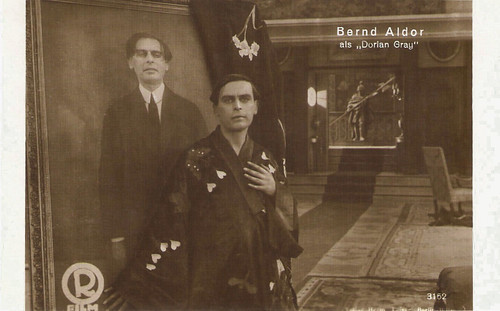
German postcard by Hermann Leiser Verlag, Berlin, no. 3152. Photo: Richard-Oswald-Produktion. Bernd Aldor in Das Bildnis des Dorian Gray/The Picture of Dorian Gray (Richard Oswald, 1917).
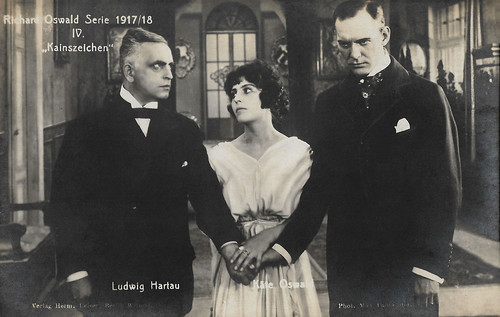
German postcard by Verlag Hermann Leiser, Berlin. Photo: Max Fassbender / Richard Oswald-Film. Käthe Oswald and Ludwig Hartau in Kainszeichen/The Mark of Cain (Richard Oswald, 1917). Caption: Richard Oswald series 1917-18, IV. The man on the right could be Alexander von Antalffy.
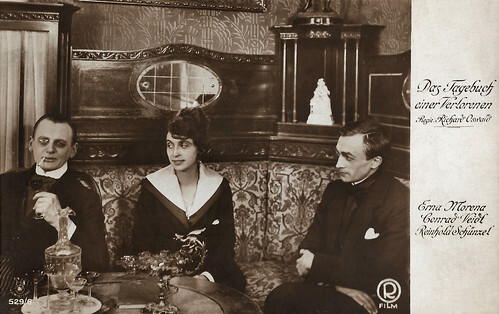
German postcard by Rotophot in the Film Sterne series, no. 529/6. Photo: Richard Oswald-Film. Erna Morena , Conrad Veidt (at right) and Reinhold Schünzel in Das Tagebuch einer Verlorenen/The Diary of a Lost Woman (Richard Oswald, 1918).
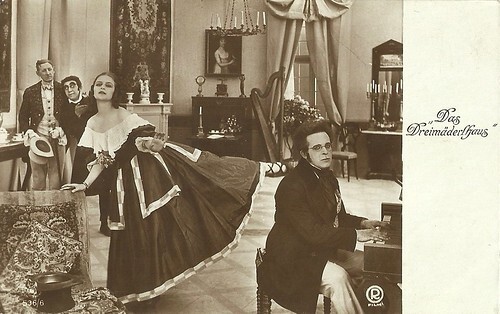
German postcard in the Film Sterne series by Rotophot, no. 563/6. Photo: Richard-Oswald-Film. Anita Berber and Julius Spielmann in Das Dreimäderlhaus/The House of Three Girls (Richard Oswald, 1918), considered a lost film and dealing with the life of composer Franz Schubert (Julius Spielmann, the man with spectacles at the right).
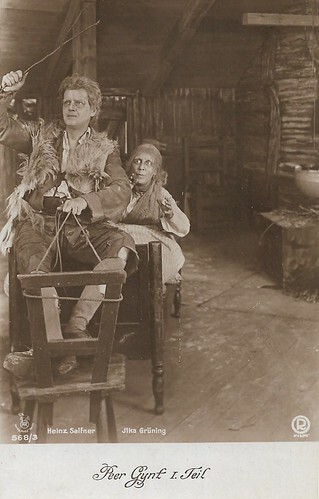
German postcard in the Film-Sterne series by Rotophot, no. 568/3. Photo: Richard Oswald-Film. Heinz Salfner as Peer Gynt and Ilka Grüning as his mother Aase in Peer Gynt (Victor Barnowsky, Richard Oswald, 1918-1919). This was a two-part film, shot and passing the German censor in 1918, but the first public release in Berlin was in April 1919. The film was an adaptation of Henrik Ibsen's dramatic poem (1867). It was the only film by theatre expert Barnowsky, who also scripted the film. The cinematography was by Max Fassbender.
A remarkable achievement
Immediately after the end of the First World War, Richard Oswald began to build up a film company. In January 1919 he founded the Richard Oswald Filmverleih and in July acquired the Prinzeß-Theater at Kantstraße 163 in Berlin, which he continued till 1926 to run as the Richard-Oswald-Lichtspiele. In 1921 he founded the Richard Oswald Film AG, of which he was a member of the board alongside Heinz Ullstein and the businessman Alexander Engel. Richard Oswald Film-AG had to file for bankruptcy in 1926. Oswald continued to work tirelessly under various new company names in the following years, including for Nero Film, which he founded together with Heinrich Nebenzahl.
During the 1920s, Richard Oswald directed a series of historical films. Lady Hamilton (Richard Oswald, 1921) starring Liane Haid and Conrad Veidt , depicts the love affair between the British Admiral Lord Nelson and Lady Emma Hamilton. It was based on two novels by Heinrich Vollrath Schumacher. It was successfully distributed abroad. Another hit was Lucrezia Borgia (Richard Oswald, 1922) again starring Conrad Veidt and Liane Haid, which portrayed the life of the Renaissance Italian aristocrat Lucrezia Borgia (1480–1519). Carlos und Elisabeth/Carlos and Elisabeth (Richard Oswald, 1924) starring Conrad Veidt , Eugen Klöpfer, and Dagny Servaes was based on the play 'Don Carlos' by Friedrich Schiller. Oswald modelled the film's visuals on Max Reinhardt's staging of the play at the Deutsches Theater.
When Carlos und Elisabeth (1924) was a failure at the box office, Oswald turned back to genre films, which were less costly financially. He directed such comedies as Lumpen und Seide/Rags and Silk (Richard Oswald, 1925) starring Reinhold Schünzel and Mary Parker and he made a significant number of Operetta films during his later career. A silent example is Im weißen Rößl/The White Horse Inn (Richard Oswald, 1926) starring Liane Haid and Max Hansen , and based on the play 'Im weißen Rößl by Oskar Blumenthal and Gustav Kadelburg. Oswald's first sound film was the Operetta Wien, du Stadt der Lieder/Vienna, City of Songs (Richard Oswald, 1930). Breaking with the then popular wine, women and song genre by filling most of the main roles with leading stars from Berlin's cabaret scene including Max Ehrlich, Siegfried Arno , Paul Morgan and Paul Graetz, the film immediately met with enormous public acclaim. Soon followed Viktoria und ihr Husar/Victoria and Her Hussar (Richard Oswald, 1931) and Gräfin Mariza/Countess Mariza (Richard Oswald, 1932) starring Dorothea Wieck .
Hal Erickson writes at All Movie: "Some critics have suggested that Oswald was more prolific than talented, but such films as his 1932 horror omnibus Unholy Tales would seem to refute this statement." Apart from Unheimliche Geschichten/Uncanny Stories (Richard Oswald, 1932), based on stories by Edgar Allan Poe and Robert Louis Stevenson and produced by Gabriel Pascal, Oswald also directed the historical drama Cagliostro (Richard Oswald, 1929) an international coproduction starring Hans Stüwe and Renée Héribel , which depicts the life of the eighteenth-century Italian occultist Alessandro Cagliostro, and the Science-Fiction Horror film Alraune/Mandrake (Richard Oswald, 1930) with Brigitte Helm in the role of Alraune. Oswald also took up politically explosive themes with Feme/Assassination (Richard Oswald, 1927), a film about the assassination of politician Walter Rathenau. Gabriel Pascal also produced the comedy Der Hauptmann von Köpenick/The Captain from Köpenick (Richard Oswald, 1931), one of several films based on the 1931 play of the same name by Carl Zuckmayer which centres on the Hauptmann von Köpenick affair in 1906.
After the Nazi takeover, Propaganda Minister Joseph Goebbels attended the premiere of Ein Lied geht um die Welt/My Song Goes Round the World (Richard Oswald, 1933) in May 1933, in which the popular (Jewish) tenor Joseph Schmidt played a leading role. However, Oswald's previously launched Ganovenehre/Crook's Honor (Richard Oswald, 1932) was among the first feature films to be banned by the Nazi censors. Ein Lied geht um Welt was Oswald's last film produced in Germany before he recognised the impending danger. Being Jewish, Oswald fled Nazi Germany in 1933 and returned to Austria with his wife and their two children, Ruth and Gerd. In the Netherlands, he made the successful film tragi-comedy Bleeke Bet/Bleak Beth (Alex Benno, Richard Oswald, 1934) starring Aaf Bouber , Fien de la Mar and Johannes Heesters . Oswald left Austria as it became an increasingly hostile working environment in the years leading up to the Anschluss. In France, he directed the drama Tempête sur l'Asie/Storm over Asia (Richard Oswald, 1938) starring Conrad Veidt , Sessue Hayakawa and Madeleine Robinson . It was Oswald's last film in Europe.
Richard Oswald then emigrated to the United States. He made three films in Hollywood, including an American version of 'Der Hauptmann von Köpenick', I Was a Criminal (Richard Oswald, 1945), also known as Passport to Heaven. In his biography of Oswald in'Das große Personenlexikon des Films', Kay Weniger recalled Oswald's problems with shooting good films in Hollywood: "Of all his films, only his barely screened I Was a Criminal, with an excellent performance by Albert Bassermann in the leading role, is of any relevance. As U.S. audiences had a hard time relating to themes of Prussian militarism, subservience and lack of democracy, the film went without a distributor for many years and only premiered at the beginning of 1945".
Jan Christopher Horak added in 'Exilfilm, 1933–1945': "Completely forgotten is the film version of Carl Zuckmayer's 'Der Captain of Köpenick', Passport to Heaven (1941) (...). Yet the film is a remarkable achievement of the director. The architecture of Berlin is composed of documentary shots and studio buildings, and the camera work uses light and shadow to bring the symbols of power into the picture again and again: In one shot, the ubiquitous image of the Kaiser is transformed by shadows into a portrait of the Führer. (...) Unlike Max Adalbert (1931) and Heinz Rühmann (1956), who played the cobbler as a "little man", Albert Bassermann , despite a strong linguistic accent, is rebellious, defiant and angry, always questioning state power with the consciousness of someone exiled by the Nazis: a ravishing portrayal that makes the film perhaps the most German of all exile films."
Richard Oswald's last production was The Lovable Cheat (Richard Oswald, 1949), an inexpensive but worthwhile adaptation of a Honoré de Balzac story which boasted an impressive cast including Charles Ruggles, Curt Bois, and Buster Keaton . With his company Richard Oswald TV Productions, he made one last attempt to realise films in 1951. However, the television series Destiny, planned for over a hundred episodes, was already stopped after the 30-minute pilot The Mayerling Story (Richard Oswald, 1951) with Dan O'Herlihy. In 1962 Oswald visited his relatives in Düsseldorf and went on to Rome to visit his son, director and producer Gerd Oswald, who was shooting a film there. In Rome, he fell seriously ill and returned to Düsseldorf with his wife. Richard Oswald died in Düsseldorf in 1963. He was 82. An excellent source for details on his life and work is the biography 'Richard Oswald' (1990), written by Hans-Michael Beck, Wolfgang Jacobsen, and Jorg Schoening.
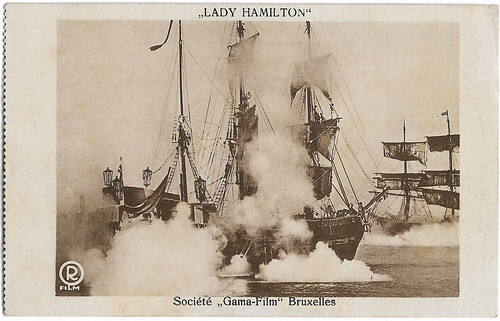
Belgian postcard by Société Gama-Film, Brussels. Photo: Richard Oswald Film. Publicity still for Lady Hamilton (Richard Oswald, 1921).
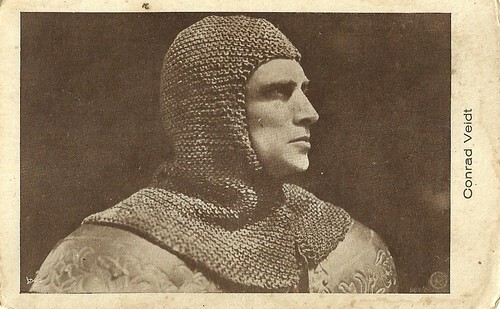
German postcard. Photo: Richard Oswald Film. Conrad Veidt in Lucrezia Borgia (Richard Oswald, 1922).

German postcard by Ross Verlag, Berlin, no. 674/1. Photo: Krabbe. Dagny Servaes as Elisabeth of Valois, wife of Philip II and Queen of Spain, in Carlos und Elisabeth/Carlos and Elisabeth (Richard Oswald, 1924).
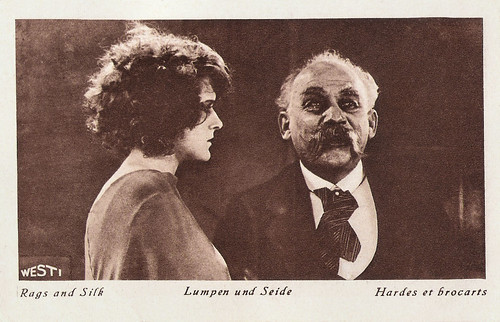
German postcard. Photo: Westi, Berlin. Mary Kid and Ferdinand Bonn in Lumpen und Seide/Rags and Silk (Richard Oswald, 1925).
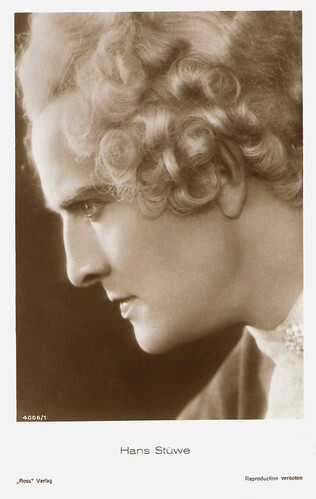
German postcard by Ross Verlag, no. 4006/1, 1929-1930. Hans Stüwe in Cagliostro (Richard Oswald, 1929).
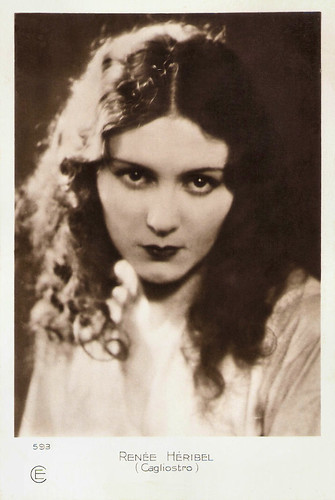
French postcard by Cinémagazine-Edition, no. 593. Renée Heribel as Lorenza in the Franco-German co-production Cagliostro (Richard Oswald, 1929).
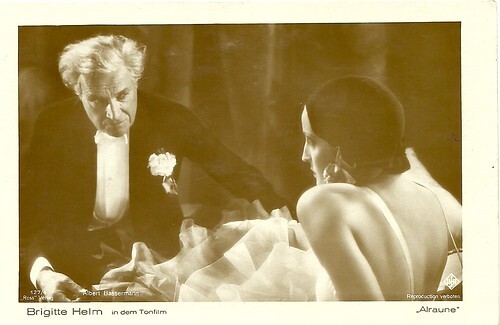
German postcard by Ross Verlag, no. 127/4, 1929-1930. Photo: Ufa. Brigitte Helm and Albert Bassermann in Alraune/Mandrake (Richard Oswald, 1930). Collection: Didier Hanson.
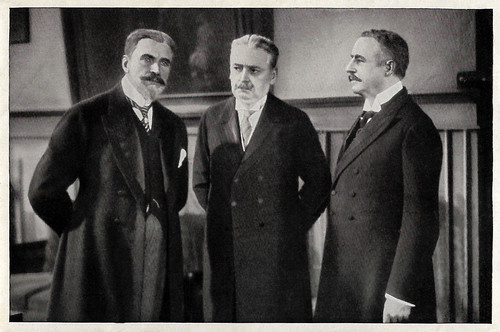
German collectors card in the series 'Vom Werden deutscher Filmkunst - Der Tonfilm', album no. 11, picture no. 118. Photo: Richard Oswald-Film / Ross Verlag. Albert Bassermann in 1914, die letzten Tage vor dem Weltbrand/1914: The Last Days Before the War (Richard Oswald, 1931). The film triggered a censorship scandal.

German postcard by Ross Verlag, no. 148/1. Photo: K. Ewald / Oswald-Film /SF (Sud Film AG). Paul Wegener as the murderer, Eugen Klöpfer as the principal physician and Maria Koppenhöfer as Her Highness in Unheimliche Geschichten/Uncanny Stories (Richard Oswald, 1932).
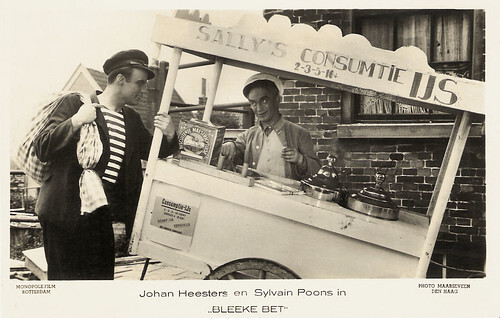
Dutch postcard by Monopole Film, Amsterdam. Photo: Maarseveen, Den Haag. Sylvain Poons and Johannes Heesters in the Dutch tragicomedy Bleeke Bet/Bleak Beth (Richard Oswald, Alex Benno, 1934). Collection: Geoffrey Donaldson Institute.
Sources: Jan Christopher Horak (Exilfilm, 1933–1945 - German), Hal Erickson (AllMovie), Wikipedia (English, German and French), and .

German postcard by Ross Verlag, no. 5501/2. Distributed in Italy by Ballerini & Frattini, Florence. Photo: Ufa. Brigitte Helm in Alraune (Richard Oswald, 1930).

German postcard by Rotophot in the Film Sterne series, no. 529/2. Photo: Richard Oswald-Film. Erna Morena in Das Tagebuch einer Verlorenen/The Diary of a Lost Woman (Richard Oswald, 1918).

German postcard by Ross Verlag, Berlin, no. 616/2. Photo: Richard-Oswald-Film. Reinhold Schünzel and Ilka Grüning in Die sich verkaufen, part 2 of the series Prostitution (Richard Oswald, 1919).

German postcard by Ross Verlag, Berlin, no. 648/2. Photo: Richard Oswald-Film. Reinhold Schünzel as King Ferdinand IV of Naples in Lady Hamilton (Richard Oswald, 1921). Caption: The big millions film.

German postcard by Ross Verlag, Berlin, no. 674/5. Photo: Krabbe / Richard-Oswald-Film. Dagny Servaes and Conrad Veidt in Carlos und Elisabeth/Carlos and Elisabeth (Richard Oswald, 1924).
He tried his hand at almost every genre
Richard Oswald was born in Vienna, Austria-Hungary (now Austria), as Richard W. Ornstein in 1880. His father was Alois Ornstein, a wealthy merchant and devout Jew, and his mother was his wife Fanny, née Bruck. Oswald studied at the Wiener Dramatischen Hochschule (Vienna Dramatic Academy) from 1896. He took his stage name from a character in Henrik Ibsen's 'Ghosts'.
He began his career as a stage actor and stagehand at Süddeutschen Novitäten-Ensemble (South German Novelty Ensemble) in Berchtesgaden in 1899. He moved to Znaim (Znojmo) the following year. There, Oswald met his colleague Bernd Aldor , whom he was later to bring before the camera several times with leading roles during the First World War. Via Preßburg he moved to the Vienna Raimundtheater in 1907, and in 1909 to the Theater in der Josefstadt, where he also worked as a dramaturge and director. After anti-Semitic hostility, he went to work as an actor at the Düsseldorf Schauspielhaus in 1910. Here he met the actress Käte Waldeck and married her in Berlin in 1913. There their daughter Ruth was born as their first child. He had made his film debut as an actor in Halbwelt/Demimonde (Reinhard Bruck, 1911) and Zouza (Reinhard Bruck, 1911), but didn't really want to be an actor and didn't last very long at it.
His childhood friend Hermann Fellner hired him in 1914 as a dramaturge and advertising expert for the film company Deutsche Vitascope GmbH, which merged with the projection company "Union" (PAGU) shortly afterwards. With his third screenplay, an adaptation of Arthur Conan Doyle's 'The Hound of the Baskervilles', Der Hund von Baskerville (Rudolf Meinert, 1914), Oswald established himself as an author of crowd-pleasing material. From the outbreak of the First World War, Oswald, who was unfit for military service, was also given the chance to direct films himself. At age 34, Oswald's first film as a director was Ivan Koschula (Richard Oswald, 1914). He then made Das eiserne Kreuz/The Iron Cross (Richard Oswald, 1914) starring Friedrich Kühne, Hedda Vernon , and Hanni Weisse . (Some sources say this was his directorial debut). Despite its patriotic name, the film was seized by the German authorities and all its copies were destroyed due to the film's pacifist nature. The film was shot for Vitascope Film at the Tempelhof Studios in the German capital of Berlin.
Oswald worked a number of times for producers Jules Greenbaum and Paul Davidson at the PAGU. Their Lache Bajazzo/Laugh Bajazzo (Richard Oswald, 1915) is a silent drama film starring Rudolph Schildkraut, Alfred Abel and Hanni Weisse . It was shot at the Weissensee Studios in Berlin. In 1915 he joined the newly founded Greenbaum-Film GmbH as head director and writer, where he continued the Baskerville series. Oswald created the German detective Engelbert Fox for Lothar Stark and directed the film debut of Werner Krauß with Hoffmanns Erzählungen (Richard Oswald, 1916).
In 1916, Oswald founded his own production company in Berlin, Richard Oswald-Film GmbH, writing and directing most of his films himself. He tried his hand at almost every genre. Oswald worked together with Werner Krauß , Lupu Pick and Reinhold Schünzel and discovered Lya de Putti and Conrad Veidt for the film. His early productions included horror films such as Nächte des Grauens/A Night of Horror (Richard Oswald, Arthur Robison, 1916) starring Werner Krauss and Emil Jannings . It is the earliest known feature-length film to portray vampires, with vampire-like people appearing in the film.
Oswald is considered the founder of the so-called 'Aufklärungsfilme'(enlightenment films). With the participation of the sex researcher Magnus Hirschfeld, he devoted himself towards the end of the First World War to taboo subjects and punishable acts in Es werde Licht!/Let There Be Light, a four-part film cycle by Oswald shot from 1916 to 1918. The films were a protest against Germany's anti-abortion law, and also touched on the dangers of syphilis and other venereal diseases. Es werde Licht! is considered the forefather of all sex education films. The leading roles are played by Bernd Aldor (parts 1 and 2), Theodor Loos (parts 2 and 3), Werner Krauß (part 3), Conrad Veidt (part 4) and Reinhold Schünzel (part 4).
Filmed during this "censorship-free" period, the 'Aufklärungsfilme' sparked a fierce debate about the reintroduction of compulsory censorship. Among his other Aufklärungsfilme are Das Tagebuch einer Verlorenen/The Diary of a Lost Woman (Richard Oswald, 1918) with Erna Morena and the sadomasochistic case study Dida Ibsens Geschichte/Dida Ibsen's Story (Richard Oswald, 1918), starring Oswald's star Anita Berber . In 1919, he also made Anders als die Andern/Different from the Others (Richard Oswald, 1919) starring Conrad Veidt and Reinhold Schünzel . The film was intended as a polemic against the then-current laws under Germany's Paragraph 175, which made homosexuality a criminal offence. Anders als die Andern is one of the first sympathetic portrayals of homosexuals in cinema. Censorship laws were enacted in reaction to films like Anders als die Andern and by October 1920 only doctors and medical researchers could view it. Prints of the film were among the many "decadent" works burned by the Nazis after they came to power in 1933.
His other pre-1920 efforts include such literary adaptations as Das Bildnis des Dorian Gray/The Picture of Dorian Gray (Richard Oswald, 1917) starring Bernd Aldor , Ernst Pittschau, and Ernst Ludwig and based on the 1890 novel 'The Picture of Dorian Gray' by Oscar Wilde, Peer Gynt (Victor Barnowsky, Richard Oswald, 1919) starring Heinz Salfner and Ilka Grüning and based upon the play by Henrik Ibsen, and Die Reise um die Erde in 80 Tagen/Around the World in Eighty Days (Richard Oswald, 1919) starring Conrad Veidt as Phileas Fogg, Anita Berber , and Reinhold Schünzel and based on the Jules Verne novel 'Around the World in Eighty Days' (1873).

German postcard by Hermann Leiser Verlag, Berlin, no. 3152. Photo: Richard-Oswald-Produktion. Bernd Aldor in Das Bildnis des Dorian Gray/The Picture of Dorian Gray (Richard Oswald, 1917).

German postcard by Verlag Hermann Leiser, Berlin. Photo: Max Fassbender / Richard Oswald-Film. Käthe Oswald and Ludwig Hartau in Kainszeichen/The Mark of Cain (Richard Oswald, 1917). Caption: Richard Oswald series 1917-18, IV. The man on the right could be Alexander von Antalffy.

German postcard by Rotophot in the Film Sterne series, no. 529/6. Photo: Richard Oswald-Film. Erna Morena , Conrad Veidt (at right) and Reinhold Schünzel in Das Tagebuch einer Verlorenen/The Diary of a Lost Woman (Richard Oswald, 1918).

German postcard in the Film Sterne series by Rotophot, no. 563/6. Photo: Richard-Oswald-Film. Anita Berber and Julius Spielmann in Das Dreimäderlhaus/The House of Three Girls (Richard Oswald, 1918), considered a lost film and dealing with the life of composer Franz Schubert (Julius Spielmann, the man with spectacles at the right).

German postcard in the Film-Sterne series by Rotophot, no. 568/3. Photo: Richard Oswald-Film. Heinz Salfner as Peer Gynt and Ilka Grüning as his mother Aase in Peer Gynt (Victor Barnowsky, Richard Oswald, 1918-1919). This was a two-part film, shot and passing the German censor in 1918, but the first public release in Berlin was in April 1919. The film was an adaptation of Henrik Ibsen's dramatic poem (1867). It was the only film by theatre expert Barnowsky, who also scripted the film. The cinematography was by Max Fassbender.
A remarkable achievement
Immediately after the end of the First World War, Richard Oswald began to build up a film company. In January 1919 he founded the Richard Oswald Filmverleih and in July acquired the Prinzeß-Theater at Kantstraße 163 in Berlin, which he continued till 1926 to run as the Richard-Oswald-Lichtspiele. In 1921 he founded the Richard Oswald Film AG, of which he was a member of the board alongside Heinz Ullstein and the businessman Alexander Engel. Richard Oswald Film-AG had to file for bankruptcy in 1926. Oswald continued to work tirelessly under various new company names in the following years, including for Nero Film, which he founded together with Heinrich Nebenzahl.
During the 1920s, Richard Oswald directed a series of historical films. Lady Hamilton (Richard Oswald, 1921) starring Liane Haid and Conrad Veidt , depicts the love affair between the British Admiral Lord Nelson and Lady Emma Hamilton. It was based on two novels by Heinrich Vollrath Schumacher. It was successfully distributed abroad. Another hit was Lucrezia Borgia (Richard Oswald, 1922) again starring Conrad Veidt and Liane Haid, which portrayed the life of the Renaissance Italian aristocrat Lucrezia Borgia (1480–1519). Carlos und Elisabeth/Carlos and Elisabeth (Richard Oswald, 1924) starring Conrad Veidt , Eugen Klöpfer, and Dagny Servaes was based on the play 'Don Carlos' by Friedrich Schiller. Oswald modelled the film's visuals on Max Reinhardt's staging of the play at the Deutsches Theater.
When Carlos und Elisabeth (1924) was a failure at the box office, Oswald turned back to genre films, which were less costly financially. He directed such comedies as Lumpen und Seide/Rags and Silk (Richard Oswald, 1925) starring Reinhold Schünzel and Mary Parker and he made a significant number of Operetta films during his later career. A silent example is Im weißen Rößl/The White Horse Inn (Richard Oswald, 1926) starring Liane Haid and Max Hansen , and based on the play 'Im weißen Rößl by Oskar Blumenthal and Gustav Kadelburg. Oswald's first sound film was the Operetta Wien, du Stadt der Lieder/Vienna, City of Songs (Richard Oswald, 1930). Breaking with the then popular wine, women and song genre by filling most of the main roles with leading stars from Berlin's cabaret scene including Max Ehrlich, Siegfried Arno , Paul Morgan and Paul Graetz, the film immediately met with enormous public acclaim. Soon followed Viktoria und ihr Husar/Victoria and Her Hussar (Richard Oswald, 1931) and Gräfin Mariza/Countess Mariza (Richard Oswald, 1932) starring Dorothea Wieck .
Hal Erickson writes at All Movie: "Some critics have suggested that Oswald was more prolific than talented, but such films as his 1932 horror omnibus Unholy Tales would seem to refute this statement." Apart from Unheimliche Geschichten/Uncanny Stories (Richard Oswald, 1932), based on stories by Edgar Allan Poe and Robert Louis Stevenson and produced by Gabriel Pascal, Oswald also directed the historical drama Cagliostro (Richard Oswald, 1929) an international coproduction starring Hans Stüwe and Renée Héribel , which depicts the life of the eighteenth-century Italian occultist Alessandro Cagliostro, and the Science-Fiction Horror film Alraune/Mandrake (Richard Oswald, 1930) with Brigitte Helm in the role of Alraune. Oswald also took up politically explosive themes with Feme/Assassination (Richard Oswald, 1927), a film about the assassination of politician Walter Rathenau. Gabriel Pascal also produced the comedy Der Hauptmann von Köpenick/The Captain from Köpenick (Richard Oswald, 1931), one of several films based on the 1931 play of the same name by Carl Zuckmayer which centres on the Hauptmann von Köpenick affair in 1906.
After the Nazi takeover, Propaganda Minister Joseph Goebbels attended the premiere of Ein Lied geht um die Welt/My Song Goes Round the World (Richard Oswald, 1933) in May 1933, in which the popular (Jewish) tenor Joseph Schmidt played a leading role. However, Oswald's previously launched Ganovenehre/Crook's Honor (Richard Oswald, 1932) was among the first feature films to be banned by the Nazi censors. Ein Lied geht um Welt was Oswald's last film produced in Germany before he recognised the impending danger. Being Jewish, Oswald fled Nazi Germany in 1933 and returned to Austria with his wife and their two children, Ruth and Gerd. In the Netherlands, he made the successful film tragi-comedy Bleeke Bet/Bleak Beth (Alex Benno, Richard Oswald, 1934) starring Aaf Bouber , Fien de la Mar and Johannes Heesters . Oswald left Austria as it became an increasingly hostile working environment in the years leading up to the Anschluss. In France, he directed the drama Tempête sur l'Asie/Storm over Asia (Richard Oswald, 1938) starring Conrad Veidt , Sessue Hayakawa and Madeleine Robinson . It was Oswald's last film in Europe.
Richard Oswald then emigrated to the United States. He made three films in Hollywood, including an American version of 'Der Hauptmann von Köpenick', I Was a Criminal (Richard Oswald, 1945), also known as Passport to Heaven. In his biography of Oswald in'Das große Personenlexikon des Films', Kay Weniger recalled Oswald's problems with shooting good films in Hollywood: "Of all his films, only his barely screened I Was a Criminal, with an excellent performance by Albert Bassermann in the leading role, is of any relevance. As U.S. audiences had a hard time relating to themes of Prussian militarism, subservience and lack of democracy, the film went without a distributor for many years and only premiered at the beginning of 1945".
Jan Christopher Horak added in 'Exilfilm, 1933–1945': "Completely forgotten is the film version of Carl Zuckmayer's 'Der Captain of Köpenick', Passport to Heaven (1941) (...). Yet the film is a remarkable achievement of the director. The architecture of Berlin is composed of documentary shots and studio buildings, and the camera work uses light and shadow to bring the symbols of power into the picture again and again: In one shot, the ubiquitous image of the Kaiser is transformed by shadows into a portrait of the Führer. (...) Unlike Max Adalbert (1931) and Heinz Rühmann (1956), who played the cobbler as a "little man", Albert Bassermann , despite a strong linguistic accent, is rebellious, defiant and angry, always questioning state power with the consciousness of someone exiled by the Nazis: a ravishing portrayal that makes the film perhaps the most German of all exile films."
Richard Oswald's last production was The Lovable Cheat (Richard Oswald, 1949), an inexpensive but worthwhile adaptation of a Honoré de Balzac story which boasted an impressive cast including Charles Ruggles, Curt Bois, and Buster Keaton . With his company Richard Oswald TV Productions, he made one last attempt to realise films in 1951. However, the television series Destiny, planned for over a hundred episodes, was already stopped after the 30-minute pilot The Mayerling Story (Richard Oswald, 1951) with Dan O'Herlihy. In 1962 Oswald visited his relatives in Düsseldorf and went on to Rome to visit his son, director and producer Gerd Oswald, who was shooting a film there. In Rome, he fell seriously ill and returned to Düsseldorf with his wife. Richard Oswald died in Düsseldorf in 1963. He was 82. An excellent source for details on his life and work is the biography 'Richard Oswald' (1990), written by Hans-Michael Beck, Wolfgang Jacobsen, and Jorg Schoening.

Belgian postcard by Société Gama-Film, Brussels. Photo: Richard Oswald Film. Publicity still for Lady Hamilton (Richard Oswald, 1921).

German postcard. Photo: Richard Oswald Film. Conrad Veidt in Lucrezia Borgia (Richard Oswald, 1922).

German postcard by Ross Verlag, Berlin, no. 674/1. Photo: Krabbe. Dagny Servaes as Elisabeth of Valois, wife of Philip II and Queen of Spain, in Carlos und Elisabeth/Carlos and Elisabeth (Richard Oswald, 1924).

German postcard. Photo: Westi, Berlin. Mary Kid and Ferdinand Bonn in Lumpen und Seide/Rags and Silk (Richard Oswald, 1925).

German postcard by Ross Verlag, no. 4006/1, 1929-1930. Hans Stüwe in Cagliostro (Richard Oswald, 1929).

French postcard by Cinémagazine-Edition, no. 593. Renée Heribel as Lorenza in the Franco-German co-production Cagliostro (Richard Oswald, 1929).

German postcard by Ross Verlag, no. 127/4, 1929-1930. Photo: Ufa. Brigitte Helm and Albert Bassermann in Alraune/Mandrake (Richard Oswald, 1930). Collection: Didier Hanson.

German collectors card in the series 'Vom Werden deutscher Filmkunst - Der Tonfilm', album no. 11, picture no. 118. Photo: Richard Oswald-Film / Ross Verlag. Albert Bassermann in 1914, die letzten Tage vor dem Weltbrand/1914: The Last Days Before the War (Richard Oswald, 1931). The film triggered a censorship scandal.

German postcard by Ross Verlag, no. 148/1. Photo: K. Ewald / Oswald-Film /SF (Sud Film AG). Paul Wegener as the murderer, Eugen Klöpfer as the principal physician and Maria Koppenhöfer as Her Highness in Unheimliche Geschichten/Uncanny Stories (Richard Oswald, 1932).

Dutch postcard by Monopole Film, Amsterdam. Photo: Maarseveen, Den Haag. Sylvain Poons and Johannes Heesters in the Dutch tragicomedy Bleeke Bet/Bleak Beth (Richard Oswald, Alex Benno, 1934). Collection: Geoffrey Donaldson Institute.
Sources: Jan Christopher Horak (Exilfilm, 1933–1945 - German), Hal Erickson (AllMovie), Wikipedia (English, German and French), and .
Published on February 12, 2023 22:00
February 11, 2023
Photo by Miklós Labori
Miklós Labori (1883-after 1944) was a Hungarian photographer and photojournalist. From the 1910s onward, he was well-known for his magazine covers and star portraits as well as for his articles for Hungarian theatre magazines.
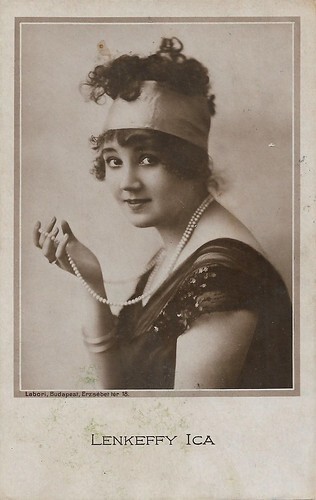
Hungarian postcard by Jozsef Reinitz, Budapest. Photo: Miklós Labori, Budapest. Ica Lenkeffy .
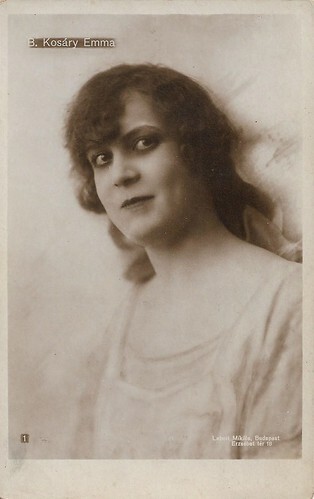
Hungarian postcard, no. 1. Photo: Miklos Labori, Budapest. Emmi Kosáry .
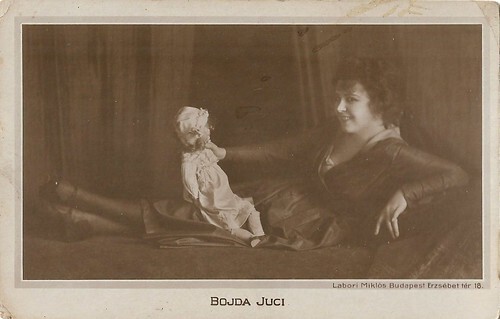
Hungarian postcard. Photo: Miklos Labori, Budapest. Juczi Bojda.
Warm recognition from the ministries
Miklós Labori was born in 1883 in Budapest as Manó Messinger. He was the son of József Messinger, a printer, and Karolina Szinayberger. In the summer of 1909, Manó registered his surname as Oszkár Messinger, together with his brothers Béla and László, and changed it to Mészöly. Béla and László became renowned artists. Mano would become a famous photographer under the stage name Miklós Labori.
The company name Labori was officially registered in the 1910 Central Bulletin and was used for a short time by the photographer Ignác Erdényi, but in 1915 it was registered in its entirety as the company name of Miklós Mészöly.
In May 1909, Labori's works were exhibited at the Archduke's Palace on Margaret Island, as part of the 1st National Photographic Exhibition, organised by Artur Kohlman, editor of the Amatőr newspaper. It featured portrait photographs on "Hungarian photographic plates, the first products of the Hungarian photographic industry".
In September 1909, Labori held a large-scale press vernissage in his studio in Elisabeth Square - by then he had already been present with his photographs in Hungary and abroad for ten years, having been awarded prizes in Budapest, London, Paris, Liège, Brussels. In August 1910, while he was on a study trip abroad, he had his studio remodelled and enlarged.
Also in December 1911, Budapest newspapers reported that Labori had "received a warm recognition from the ministries." In 1926, he extended his services to amateur photographers. In addition to developing the images he also gave them professional advice.
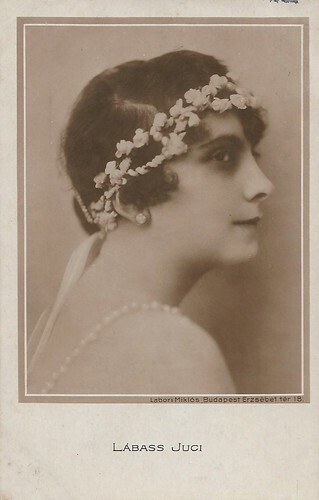
Hungarian postcard. Photo: Miklos Labori, Budapest. Juci Lábass.
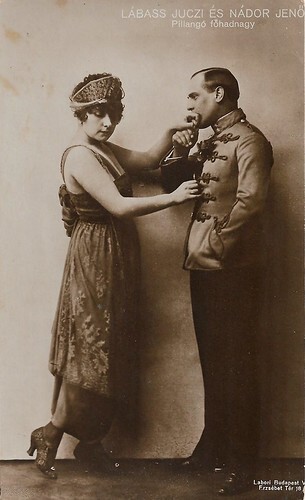
Hungarian postcard. Photo: Miklos Labori, Budapest. Juci Lábass and Jenö Nádor in the operetta 'Pillangó főhadnagy' (Lieutenant Butterfly by Imre Harmath, first performed in 1918.
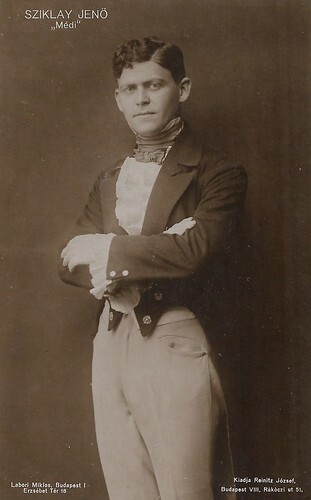
Hungarian postcard by Jozsef Kiadja Reinitz. Photo: Miklos Labori, Budapest. Jenö Sziklay in 'Médi'.
Popular on the French Riviera
From the 1910s onward, Miklós Labori was also a well-known magazine cover and star photographer as well as a photojournalist for a number of mainly Hungarian theatre magazines such as Színházi Élet, Színházi Hétét, Figáró, Színházi Világ, Pesti Hírlap, and Ország-Világ, while he also did some photos for Vasárnapi Ujság. His portraits also appeared on many postcards.
In 1920, Labori became a board member of the then-established Theater World Publishing Company, a joint-stock company. In 1927, he made an album about the Institute for the Blind, showing the everyday life of the blind, school education, skill development and vocational training. These photos were the subject of a temporary exhibition of his images in 2005.
In 1907 Labori had a studio at 15 Váci körút in Budapest which also belonged to Ignác Erdényi. Between 1908 and 1943, he had his own studio at 18 Erzsébet tér (later gr. Tisza István, then József Atilla utca) in Budapest's 5th district. In 1919 and 1930, photographer Károly Demeter also worked in his studio. From 1920, Labori was an elected member of the Budapest Photographic Industrial Association.
His photographs were famous on the French Riviera, thanks in part to his studio in Nice. Labori was part of the many Hungarian photographers active in France, who came to Paris with a fresh spirit, either as trained photographers - like Egry Landau, Ilka Révai or Miklós Mészöly/Labori - or they became photographers there, like Brassai or Alexander Trauner who eventually became a famous film set designer in France. In 1935, Labori was elected a member of the French College of Merchants and Craftsmen.
From 1928 to the 1940s, Labori's studio in Budapest was owned by the Trükk Film Company. According to a disclosure sheet, he was abroad in 1944, residing at his address in Nice. Nothing is known of his whereabouts after 1944, but as he was Jewish, he may have died during the Holocaust.
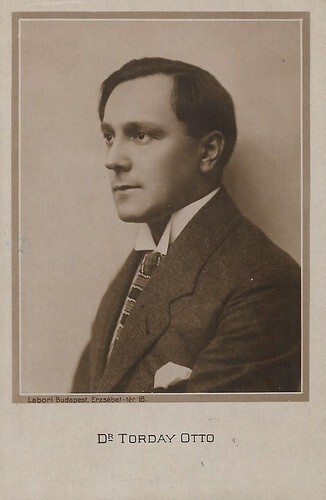
Hungarian postcard by Jozsef Kiadja Reinitz, Budapest. Photo: Miklos Labori, Budapest. Otto Torday.
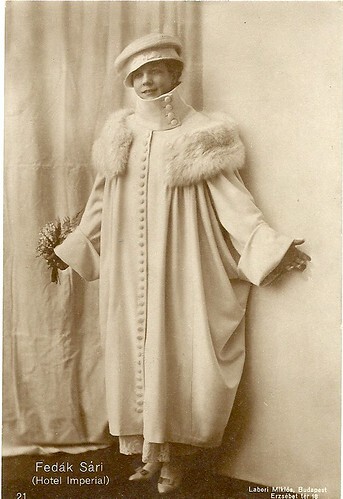
Hungarian postcard, no. 21. Photo: Miklós Labori, Budapest. Collection: Didier Hanson. Sári Fedák as Anna in the play 'Hotel Imperial' (1917), written by Lajos Bíró. Performed at the Magyar Shinhaz (Hungarian Theatre).
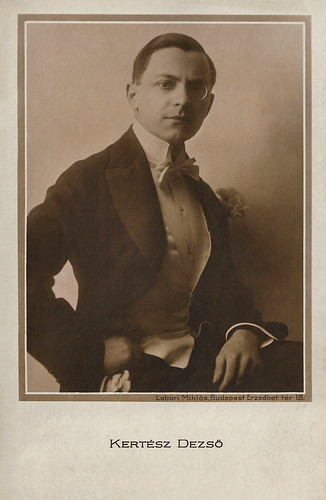
Hungarian postcard by József Reinitz, Budapest. Photo: Miklós Labori, Budapest. Dezsõ Kertész .
Sources: Wikipedia (Hungarian), Criticailapok, and ushmm.

Hungarian postcard by Jozsef Reinitz, Budapest. Photo: Miklós Labori, Budapest. Ica Lenkeffy .

Hungarian postcard, no. 1. Photo: Miklos Labori, Budapest. Emmi Kosáry .

Hungarian postcard. Photo: Miklos Labori, Budapest. Juczi Bojda.
Warm recognition from the ministries
Miklós Labori was born in 1883 in Budapest as Manó Messinger. He was the son of József Messinger, a printer, and Karolina Szinayberger. In the summer of 1909, Manó registered his surname as Oszkár Messinger, together with his brothers Béla and László, and changed it to Mészöly. Béla and László became renowned artists. Mano would become a famous photographer under the stage name Miklós Labori.
The company name Labori was officially registered in the 1910 Central Bulletin and was used for a short time by the photographer Ignác Erdényi, but in 1915 it was registered in its entirety as the company name of Miklós Mészöly.
In May 1909, Labori's works were exhibited at the Archduke's Palace on Margaret Island, as part of the 1st National Photographic Exhibition, organised by Artur Kohlman, editor of the Amatőr newspaper. It featured portrait photographs on "Hungarian photographic plates, the first products of the Hungarian photographic industry".
In September 1909, Labori held a large-scale press vernissage in his studio in Elisabeth Square - by then he had already been present with his photographs in Hungary and abroad for ten years, having been awarded prizes in Budapest, London, Paris, Liège, Brussels. In August 1910, while he was on a study trip abroad, he had his studio remodelled and enlarged.
Also in December 1911, Budapest newspapers reported that Labori had "received a warm recognition from the ministries." In 1926, he extended his services to amateur photographers. In addition to developing the images he also gave them professional advice.

Hungarian postcard. Photo: Miklos Labori, Budapest. Juci Lábass.

Hungarian postcard. Photo: Miklos Labori, Budapest. Juci Lábass and Jenö Nádor in the operetta 'Pillangó főhadnagy' (Lieutenant Butterfly by Imre Harmath, first performed in 1918.

Hungarian postcard by Jozsef Kiadja Reinitz. Photo: Miklos Labori, Budapest. Jenö Sziklay in 'Médi'.
Popular on the French Riviera
From the 1910s onward, Miklós Labori was also a well-known magazine cover and star photographer as well as a photojournalist for a number of mainly Hungarian theatre magazines such as Színházi Élet, Színházi Hétét, Figáró, Színházi Világ, Pesti Hírlap, and Ország-Világ, while he also did some photos for Vasárnapi Ujság. His portraits also appeared on many postcards.
In 1920, Labori became a board member of the then-established Theater World Publishing Company, a joint-stock company. In 1927, he made an album about the Institute for the Blind, showing the everyday life of the blind, school education, skill development and vocational training. These photos were the subject of a temporary exhibition of his images in 2005.
In 1907 Labori had a studio at 15 Váci körút in Budapest which also belonged to Ignác Erdényi. Between 1908 and 1943, he had his own studio at 18 Erzsébet tér (later gr. Tisza István, then József Atilla utca) in Budapest's 5th district. In 1919 and 1930, photographer Károly Demeter also worked in his studio. From 1920, Labori was an elected member of the Budapest Photographic Industrial Association.
His photographs were famous on the French Riviera, thanks in part to his studio in Nice. Labori was part of the many Hungarian photographers active in France, who came to Paris with a fresh spirit, either as trained photographers - like Egry Landau, Ilka Révai or Miklós Mészöly/Labori - or they became photographers there, like Brassai or Alexander Trauner who eventually became a famous film set designer in France. In 1935, Labori was elected a member of the French College of Merchants and Craftsmen.
From 1928 to the 1940s, Labori's studio in Budapest was owned by the Trükk Film Company. According to a disclosure sheet, he was abroad in 1944, residing at his address in Nice. Nothing is known of his whereabouts after 1944, but as he was Jewish, he may have died during the Holocaust.

Hungarian postcard by Jozsef Kiadja Reinitz, Budapest. Photo: Miklos Labori, Budapest. Otto Torday.

Hungarian postcard, no. 21. Photo: Miklós Labori, Budapest. Collection: Didier Hanson. Sári Fedák as Anna in the play 'Hotel Imperial' (1917), written by Lajos Bíró. Performed at the Magyar Shinhaz (Hungarian Theatre).

Hungarian postcard by József Reinitz, Budapest. Photo: Miklós Labori, Budapest. Dezsõ Kertész .
Sources: Wikipedia (Hungarian), Criticailapok, and ushmm.
Published on February 11, 2023 22:00
February 10, 2023
Glenn Close
American film, television and stage actress Glenn Close (1947) is considered one of the best actresses of her generation due to her wide variety of roles. Throughout her career spanning over four decades, she won three Emmy Awards and three Tony Awards in her career. She was also nominated eight times for an Academy Award for best actress, without winning it.
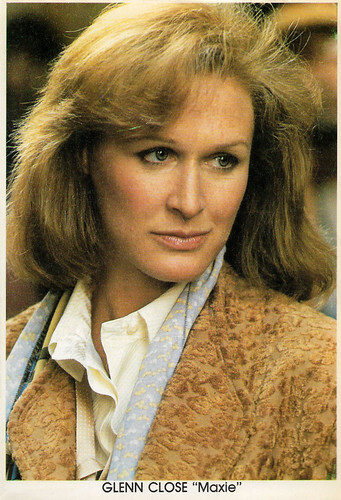
Spanish postcard in the Yo amo al cine series by Rovensa SA. Photo: Lauren Films. Glenn Close in Maxie (Paul Aaron, 1985).
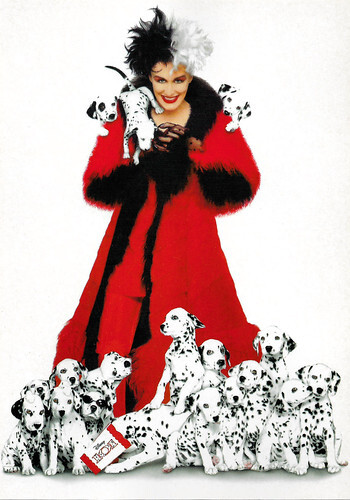
British postcard by Boomerang Media. Photo: Disney. Glenn Close in 101 Dalmatians (Stephen Herek, 1996).
Fatal Attraction
Glenn Close was born in Greenwich, Connecticut, in 1947. She was the daughter of socialite Bettine Moore Close and William Taliaferro Close. Her father was a doctor who ran a clinic in the Belgian Congo and was a private physician to President Mobutu Sese Seko. She has two sisters, Tina and Jessie, and two brothers, Alexander (nicknamed Sandy) and Tambu Misoki, whom Close's parents adopted while living in the Congo. During most of that time, the Close children lived alternately in Africa and at boarding schools in Switzerland.
In her youth, Close also lived with her parents in a cottage on her grandfather's estate in Greenwich. When she was seven, her parents joined a sect called the Moral Re-Armament (MRA) and remained members of it for 15 years. She has described MRA as a "cult" that dictated every aspect of her life, from the clothes that had to be worn to what she was allowed to say. Close studied at St George's School in Switzerland and travelled around with an MRA singing group called Up With People in the late 1960s. She also studied at Rosemary Hall, where she graduated in 1965.
At 22, Close broke with the MRA and left for the College of William & Mary to study theatre and anthropology. It was here that she first began working seriously on an acting career under the tutelage of Howard Scammon. At age 27, Close made her Broadway debut in The Phoenix Theatre's production of William Congreve's 'Love for Love' (1974). She appeared in productions of 'Barnum' (1980) and Tom Stoppard's 'The Real Thing' (1983), winning the Tony Award for Best Actress in a Play for the latter. Close received another Tony Award for 'Death and the Maiden' (1992).
Her best-known theatrical role was that of Norma Desmond in 'Sunset Boulevard' (1995) for which she won an additional Tony. She was chosen by Andrew Lloyd Webber to replace Patti LuPone in 'Sunset Boulevard' before its arrival on Broadway in 1994. More than a decade earlier, film director George Roy Hill discovered her at the New Phoenix Repertory Company and picked her for his film The World According to Garp (George Roy Hill, 1982). She played the mother of Robin Williams , despite being just four years older. For her film debut, she was immediately nominated for an Oscar. It was followed by supporting roles in the films The Big Chill (Lawrence Kasdan, 1983) and Robert Redford 's baseball drama The Natural (Barry Levinson, 1984); both films earned her nominations for the Academy Award for Best Supporting Actress.
In 1984, Close starred in her TV debut, the drama film Something About Amelia (William Hanely, 1984) about a family going down because of sexual abuse. The film won a Golden Globe. She subsequently went on to establish herself as a leading lady with roles in the legal thriller Jagged Edge (Richard Marquand, 1985), opposite Jeff Bridges, the psychological thriller Fatal Attraction (Adrian Lyne, 1987) and the period romantic drama Dangerous Liaisons (Stephen Frears, 1988) with John Malkovich and Michelle Pfeiffer . Fatal Attraction became a huge box-office success, the highest-grossing film worldwide of that year. The film propelled Close to international stardom and the character of Alex Forrest is considered one of her most iconic roles.
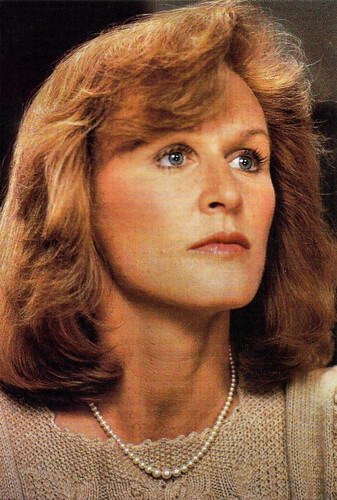
Dutch collectors card. Glenn Close in Maxie (Paul Aaron, 1985).
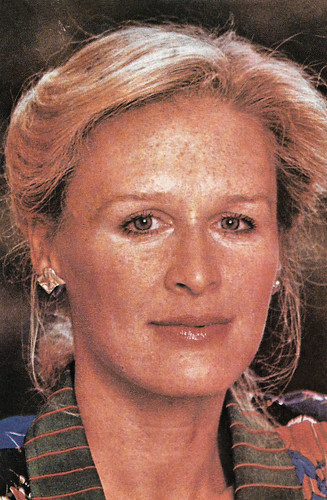
Romanian postcard in the Starurile si moda series by Inter Contemp Press.
Cruella De Vil
During the 1990s, Glenn Close starred in films like the drama Reversal of Fortune (Barbet Schroeder, 1990) with Jeremy Irons , the TV movie Sarah, Plain and Tall (Glenn Jordan, 1991) and its two sequels, and the period drama The House of the Spirits (Bille August, 1993), based on the novel by Isabel Allende. She also starred in The Paper (Ron Howard, 1994), Steven Spielberg's Hook (1991), the satirical Sci-Fi film Mars Attacks! (Tim Burton, 1996) and the Disney film 101 Dalmatians (Stephen Herek, 1996). In the latter, she played the role of the infamous villain Cruella De Vil, which she repeated in the sequel, 102 Dalmatians (Kevin Lima, 2000). Glenn Close received three additional Academy Award nominations.
She was nominated for Best Actress for her title role in Albert Nobbs (Rodrigo García, 2011) and for her lead role as Joan Castleman in The Wife (Björn L. Runge, 2017), winning her third Golden Globe Award for the latter. In 2020, she starred in the drama Hillbilly Elegy (Ron Howard, 2020), for which she received an additional Academy Award nomination for Best Supporting Actress, her eighth nomination overall.
More than 15 film awards were actually given to her, including Emmy Awards for the television film Serving in Silence: The Margarethe Cammermeyer Story (Jeff Bleckner, 1995) and the drama series Damages (2007-2012) as Golden Globes for her portrayal of Eleanor of Aquitaine in the television film The Lion in Winter (Andrey Konchalovskiy, 2003) and for her role as Patty Hewes in Damages (2007-2012).
In 2009, Close received a star on the Hollywood Walk of Fame. From 1969 to 1971, Close was married to Cabot Wade, a guitarist and songwriter she knew from her time with Up with People. From 1979 to 1983, she was in a relationship with Len Cariou. From 1984 to 1987, she was married to businessman James Marlas. Shortly after this marriage, she began a relationship with producer John H. Starke, whom she had met on the set of The World According to Garp. Together they had a daughter named Annie Starke in 1988. In 1995, Close was engaged to Steve Beers, but the marriage did not happen and they broke up in 1999.
In February 2006, Close married David Shaw. This marriage ended in 2015. Close is a dog lover and writes blogs for Fetchdog.com, in which she interviews celebrities about their relationship with their pets. On the political front, she has financially supported the election campaigns of Hillary Clinton, Howard Dean, John Edwards and Barack Obama, among others. Close is the founder and chairwoman of BringChange2Mind, an organisation that aims to break the stigma and discrimination surrounding mental illness. Through this, she supports her sister Jessie, who suffers from bipolar disorder.
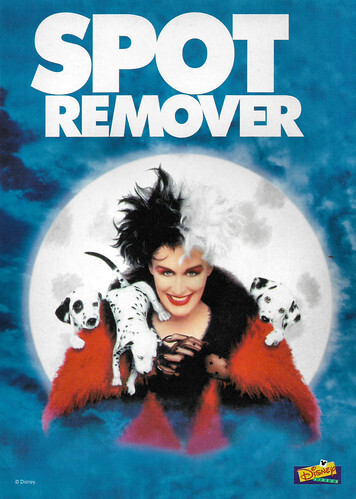
British postcard by Boomerang Media for the video release. Photo: Walt Disney Pictures. Glenn Close in 102 Dalmatians (Kevin Lima, 2000).
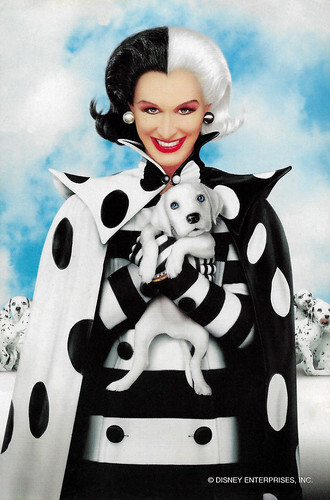
Spanish postcard by Disney for the DVD release. Photo: Disney Enterprises Inc. Glenn Close in 102 Dalmatians (Kevin Lima, 2000).
Sources: Wikipedia (Dutch and English) and .

Spanish postcard in the Yo amo al cine series by Rovensa SA. Photo: Lauren Films. Glenn Close in Maxie (Paul Aaron, 1985).

British postcard by Boomerang Media. Photo: Disney. Glenn Close in 101 Dalmatians (Stephen Herek, 1996).
Fatal Attraction
Glenn Close was born in Greenwich, Connecticut, in 1947. She was the daughter of socialite Bettine Moore Close and William Taliaferro Close. Her father was a doctor who ran a clinic in the Belgian Congo and was a private physician to President Mobutu Sese Seko. She has two sisters, Tina and Jessie, and two brothers, Alexander (nicknamed Sandy) and Tambu Misoki, whom Close's parents adopted while living in the Congo. During most of that time, the Close children lived alternately in Africa and at boarding schools in Switzerland.
In her youth, Close also lived with her parents in a cottage on her grandfather's estate in Greenwich. When she was seven, her parents joined a sect called the Moral Re-Armament (MRA) and remained members of it for 15 years. She has described MRA as a "cult" that dictated every aspect of her life, from the clothes that had to be worn to what she was allowed to say. Close studied at St George's School in Switzerland and travelled around with an MRA singing group called Up With People in the late 1960s. She also studied at Rosemary Hall, where she graduated in 1965.
At 22, Close broke with the MRA and left for the College of William & Mary to study theatre and anthropology. It was here that she first began working seriously on an acting career under the tutelage of Howard Scammon. At age 27, Close made her Broadway debut in The Phoenix Theatre's production of William Congreve's 'Love for Love' (1974). She appeared in productions of 'Barnum' (1980) and Tom Stoppard's 'The Real Thing' (1983), winning the Tony Award for Best Actress in a Play for the latter. Close received another Tony Award for 'Death and the Maiden' (1992).
Her best-known theatrical role was that of Norma Desmond in 'Sunset Boulevard' (1995) for which she won an additional Tony. She was chosen by Andrew Lloyd Webber to replace Patti LuPone in 'Sunset Boulevard' before its arrival on Broadway in 1994. More than a decade earlier, film director George Roy Hill discovered her at the New Phoenix Repertory Company and picked her for his film The World According to Garp (George Roy Hill, 1982). She played the mother of Robin Williams , despite being just four years older. For her film debut, she was immediately nominated for an Oscar. It was followed by supporting roles in the films The Big Chill (Lawrence Kasdan, 1983) and Robert Redford 's baseball drama The Natural (Barry Levinson, 1984); both films earned her nominations for the Academy Award for Best Supporting Actress.
In 1984, Close starred in her TV debut, the drama film Something About Amelia (William Hanely, 1984) about a family going down because of sexual abuse. The film won a Golden Globe. She subsequently went on to establish herself as a leading lady with roles in the legal thriller Jagged Edge (Richard Marquand, 1985), opposite Jeff Bridges, the psychological thriller Fatal Attraction (Adrian Lyne, 1987) and the period romantic drama Dangerous Liaisons (Stephen Frears, 1988) with John Malkovich and Michelle Pfeiffer . Fatal Attraction became a huge box-office success, the highest-grossing film worldwide of that year. The film propelled Close to international stardom and the character of Alex Forrest is considered one of her most iconic roles.

Dutch collectors card. Glenn Close in Maxie (Paul Aaron, 1985).

Romanian postcard in the Starurile si moda series by Inter Contemp Press.
Cruella De Vil
During the 1990s, Glenn Close starred in films like the drama Reversal of Fortune (Barbet Schroeder, 1990) with Jeremy Irons , the TV movie Sarah, Plain and Tall (Glenn Jordan, 1991) and its two sequels, and the period drama The House of the Spirits (Bille August, 1993), based on the novel by Isabel Allende. She also starred in The Paper (Ron Howard, 1994), Steven Spielberg's Hook (1991), the satirical Sci-Fi film Mars Attacks! (Tim Burton, 1996) and the Disney film 101 Dalmatians (Stephen Herek, 1996). In the latter, she played the role of the infamous villain Cruella De Vil, which she repeated in the sequel, 102 Dalmatians (Kevin Lima, 2000). Glenn Close received three additional Academy Award nominations.
She was nominated for Best Actress for her title role in Albert Nobbs (Rodrigo García, 2011) and for her lead role as Joan Castleman in The Wife (Björn L. Runge, 2017), winning her third Golden Globe Award for the latter. In 2020, she starred in the drama Hillbilly Elegy (Ron Howard, 2020), for which she received an additional Academy Award nomination for Best Supporting Actress, her eighth nomination overall.
More than 15 film awards were actually given to her, including Emmy Awards for the television film Serving in Silence: The Margarethe Cammermeyer Story (Jeff Bleckner, 1995) and the drama series Damages (2007-2012) as Golden Globes for her portrayal of Eleanor of Aquitaine in the television film The Lion in Winter (Andrey Konchalovskiy, 2003) and for her role as Patty Hewes in Damages (2007-2012).
In 2009, Close received a star on the Hollywood Walk of Fame. From 1969 to 1971, Close was married to Cabot Wade, a guitarist and songwriter she knew from her time with Up with People. From 1979 to 1983, she was in a relationship with Len Cariou. From 1984 to 1987, she was married to businessman James Marlas. Shortly after this marriage, she began a relationship with producer John H. Starke, whom she had met on the set of The World According to Garp. Together they had a daughter named Annie Starke in 1988. In 1995, Close was engaged to Steve Beers, but the marriage did not happen and they broke up in 1999.
In February 2006, Close married David Shaw. This marriage ended in 2015. Close is a dog lover and writes blogs for Fetchdog.com, in which she interviews celebrities about their relationship with their pets. On the political front, she has financially supported the election campaigns of Hillary Clinton, Howard Dean, John Edwards and Barack Obama, among others. Close is the founder and chairwoman of BringChange2Mind, an organisation that aims to break the stigma and discrimination surrounding mental illness. Through this, she supports her sister Jessie, who suffers from bipolar disorder.

British postcard by Boomerang Media for the video release. Photo: Walt Disney Pictures. Glenn Close in 102 Dalmatians (Kevin Lima, 2000).

Spanish postcard by Disney for the DVD release. Photo: Disney Enterprises Inc. Glenn Close in 102 Dalmatians (Kevin Lima, 2000).
Sources: Wikipedia (Dutch and English) and .
Published on February 10, 2023 22:00
February 9, 2023
Richard Cromwell
With his smooth, boyish good looks, American actor Richard Cromwell (1910-1960) had the makings of a Hollywood star in the early 1930s. The handsome actor became well known with The Lives of a Bengal Lancer (1935), sharing top billing with Gary Cooper and Franchot Tone. His film career reached its pinnacle with Jezebel (1938) with Bette Davis and Henry Fonda and John Ford's Young Mr. Lincoln (1939) also with Fonda. But soon after that, his meteoric career crashed and burned.
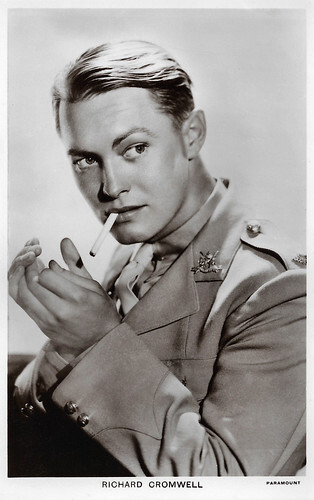
British postcard in the Picturegoer Series, London, no. 955. Photo: Paramount. Richard Cromwell in The Lives of a Bengal Lancer (Henry Hathaway, 1935).
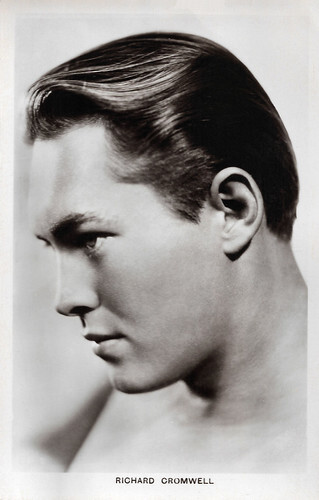
British postcard in the Picturegoer Series, London, no. 656.
Terrific debut performance in a very difficult role
Richard Cromwell was born LeRoy Melvin Radabaugh in Long Beach, California, in 1910. He was the second of five children of Fay B. (née Stocking) and Ralph R. Radabaugh, who was an inventor. In 1918, when Radabaugh was still in grade school, his father died of the Spanish flu. Roy earnestly delivered morning newspapers to help out with the family's budget crisis.
On a scholarship, he attended the Chouinard Art Institute in Los Angeles, a precursor to the California Institute of the Arts. He continued to work part-time as a maintenance man, custodian and soda jerk. He set up a small art shop in Hollywood in the late 1920s and made masks and oil paintings there. He sold pictures, made lampshades, and designed colour schemes for houses. The handsome Cromwell made contacts with film stars of the time such as Anna Q. Nilsson , Colleen Moore , Beatrice Lillie, Greta Garbo , Joan Crawford and Tallulah Bankhead, some of whom he also immortalised in his paintings and masks.
He painted scenery for community theatre productions and eventually took on acting roles. His first film appearance was an extra role in King of Jazz (John Murray Anderson, Walter Lantz, 1930), along with the film's star, Paul Whiteman and his orchestra. On a whim, his friends encouraged him to audition for the lead role in a Columbia remake of D.W. Griffith 's silent classic Tol'able David (1921) starring Richard Barthelmess . Radabaugh won the role over thousands of hopefuls. In storybook fashion, studio mogul Harry Cohn gave him his screen name Richard Cromwell and launched his career.
Cromwell earned $75 per week for his work on Tol'able David (John G. Blystone, 1930), which co-starred Noah Beery Sr. and John Carradine. Gary Brumburgh at IMDb : "the studio publicity machines worked overtime to promote both the film and their new leading man. Richard lived up to all the hype once the reviews came out, giving a terrific debut performance in a very difficult role. As the rather weak-willed young boy who finds the strength and courage to right the injustice done to him, he hit overnight stardom".
Amid the flurry of publicity, Cromwell toured the country and was even invited to the White House to meet President Herbert Hoover. Cohn signed Cromwell to a multi-year contract based on the strength of his performance and the success at the box office of his debut. In the following years, Richard played several leading roles in smaller films, often in youthful, somewhat sensitive roles. Leslie Halliwell later described him in his Filmgoer's Companion as the "friendly hero of the early talkies".
Cromwell maintained a deep friendship with Marie Dressler, which continued until her death from cancer in 1934. Dressler personally insisted that her studio bosses cast Cromwell on a loan-out in the lead opposite her in Emma (Clarence Brown, 1932), also with Myrna Loy . Dressler was nominated for a second Best Actress award for her portrayal of the title role in Emma. This was another break that helped sustain Cromwell's rising status in Hollywood. He was now much in demand and his next roles were in The Age of Consent (Gregory La Cava, 1932) co-starring Arline Judge and Eric Linden, Tom Brown of Culver (William Wyler, 1932), and Hoopla (Frank Lloyd, 1933), where he is seduced by Clara Bow , in her final film.
He made an early standout performance as the leader of the youth gang in Cecil B. DeMille 's unusual cult-favourite, This Day and Age (1933). To ensure that Cromwell's character used the right slang, DeMille asked high school student Horace Hahn to read the script and comment. Cromwell then starred with Jean Arthur in Most Precious Thing in Life (Lambert Hillyer, 1934). He had his definitive breakthrough when he co-starred with Gary Cooper and Franchot Tone in the adventure film The Lives of a Bengal Lancer (Henry Hathaway, 1935), which was nominated for seven Oscars. Cromwell played the son of a senior officer who is tortured by insurgents. His father refuses to rescue him in order to demonstrate his impartiality. After this promising start, Cromwell's career received a bump when he wanted more artistic independence.
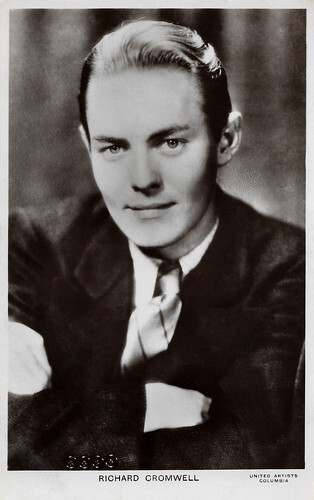
British postcard in the Picturegoer Series, London, no. 656a. Photo: United Artists, Columbia.
Running the gamut of emotions
Richard Cromwell's next pictures at Columbia Pictures and elsewhere were mostly inconsequential. Cromwell starred with Will Rogers in Life Begins at 40 (George Marshall, 1935) and appeared in Poppy (A. Edward Sutherland, 1936) as the suitor of W.C. Fields ' daughter, Rochelle Hudson . In 1937, he portrayed the young bank robber in love with Helen Mack and on the lam from Lionel Atwill in The Wrong Road.
A challenge was his lead role in The Road Back (James Whale, 1937), a sequel to the classic All Quiet on the Western Front (Lewis Milestone, 1930). The film chronicled the story of young German soldiers readjusting to civilian life after WWI. Fearful that this film would not do well in Germany, the new regime at Universal Pictures severely edited the film before release, removing much of the strongly anti-Nazi slant that author Erich Maria Remarque included in the original novel, and which director James Whale had intended to retain in the film version. The resulting film was not well-received.
Richard Cromwell took a detour in his career to Broadway for the chance to star as an evil cadet in an original play by Joseph Viertel, 'So Proudly We Hail!'. The military drama was directed by future film director Charles Walters, co-starred Edward Andrews and Eddie Bracken, and opened to much fanfare. The New York Herald Tribune called Cromwell's acting "a striking portrayal" and The New York Times said that he "ran the gamut of emotions" in the play. Cromwell had shed his restrictive Columbia contract and pursued acting work as a freelancer in other media.
Cromwell guest-starred on the radio in 'The Royal Gelatin Hour' (1937) hosted by Rudy Vallee, in a dramatic skit opposite Fay Wray . Enjoying the experience, Cromwell acted in the role of Kit Marshall on the radio soap opera 'Those We Love', which ran from 1938 until 1942. On-screen, Cromwell appeared in Storm Over Bengal (Sidney Salkow, 1938), for Republic Pictures, in order to capitalise on his success in The Lives of a Bengal Lancer. He stood out in supporting roles as Henry Fonda 's brother, who kills a man in a duel of honour, in the romantic drama Jezebel (William Wyler, 1938) starring Bette Davis and as defendant Matt Clay to Henry Fonda 's title performance in Young Mr. Lincoln (John Ford, 1939).
In 1939, Cromwell again tried his luck on stage in a regional production of Sutton Vane's play 'Outward Bound', co-starring Dorothy Jordan. Cromwell drifted into secondary features. He enjoyed an active social Hollywood life with friends including Barbara Stanwyck , Joan Crawford , Franchot Tone, George Cukor, Cole Porter and William Haines . For Universal Pictures, Cromwell starred as a draftsman who thwarts the Nazis in Enemy Agent (Lew Landers, 1940). He went on to appear in marginal but still watchable fare such as Baby Face Morgan (Arthur Dreifuss, 1942), with Mary Carlisle. Cromwell enjoyed a career boost with Cosmo Jones, Crime Smasher (James Tinling, 1943), the film adaptation of the hit radio serial. However, he was next up at Monogram Pictures, where he was cast as a doctor working covertly for a police department to catch mobsters in the forgettable though endearing Riot Squad (Edward Finney, 1941).
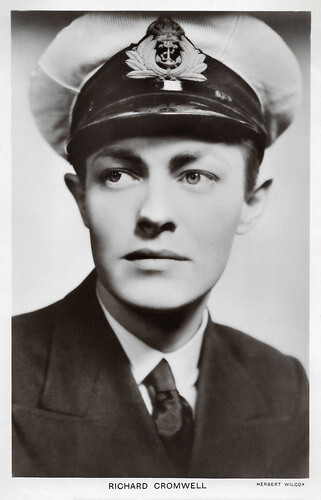
British postcard in the Picturegoer Series, London, no. 955a. Photo: Herbert Wilcox. Richard Cromwell in Our Fighting Navy (Norman Walker, 1937).
Charming with a good knowledge of jazz music
During the last two years of World War II, Richard Cromwell served with the United States Coast Guard. Upon returning to California following the war's end, he acted in local theatre productions. He also signed on for live performances in summer stock in the East during this period. Cromwell's break from films due to his stint in the Service meant that he was not much in demand after the War's end. He failed to make a comeback as a film actor with a role in the Film Noir Bungalow 13 (Edward L. Cahn, 1948) and he retired from the film industry.
All told, Cromwell's film career spanned 39 films. In the 1950s, he returned to his artistic roots and studied ceramics. He built a pottery studio on his property, becoming especially known and admired for his creative tile designs. Returning to the name Roy Radabaugh, Cromwell also wrote extensively, producing several published stories and an unfinished novel in the 1950s.
Cromwell was married once, briefly (1945–1946), to actress Angela Lansbury , when she was 19 and Cromwell was 35. They were married in a small civil ceremony in Independence, California. Lansbury later stated in a 1966 interview that her first marriage was a mistake because Cromwell was gay. His homosexuality had been kept secret from the public and Lansbury had not known about it before the marriage. However, Cromwell and Lansbury remained friends until his death in 1960.
She later described him as "charming with a good knowledge of jazz music". In 1960 he tried a second comeback in the film business. In July 1960, Cromwell signed with producer Maury Dexter for 20th Century Fox's planned production of The Little Shepherd of Kingdom Come (Andrew V. McLaglen, 1961), starring singer Jimmie Rogers. Diagnosed with liver cancer shortly thereafter, he was forced to withdraw and Chill Wills replaced Cromwell in the film. Richard Cromwell was a heavy smoker for many years and at times advertised Lucky Strike.
He died on 11 October 1960 in Hollywood, at the age of 50. He is interred at Fairhaven Memorial Park in Santa Ana, California. For his services to the film industry, Cromwell has a star on the Hollywood Walk of Fame (1627 Vine Street). Cromwell's legacy is preserved today by his nephew Dan Putnam and his cousin Bill Keane IV. In 2005, Keane donated materials relating to Cromwell's radio performances to the Thousand Oaks Library's Special Collection, "The American Radio Archive". In 2007, Keane donated memorabilia relating to Cromwell's film career and ceramics work to the AMPAS Margaret Herrick Library in Beverly Hills.
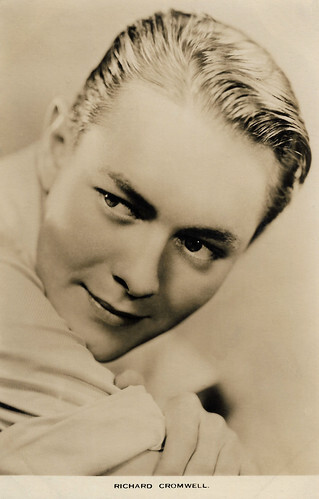
British postcard by Film Weekly, London.
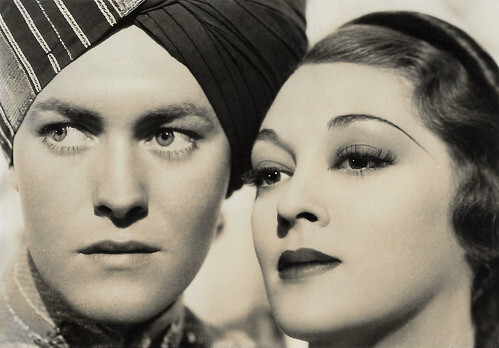
Vintage card. Richard Cromwell and Kathleen Burke in The Lives of a Bengal Lancer (Henry Hathaway, 1935).
Sources: (IMDb), Leslie Halliwell (Filmgoer's Companion), Wikipedia (English and German) and .

British postcard in the Picturegoer Series, London, no. 955. Photo: Paramount. Richard Cromwell in The Lives of a Bengal Lancer (Henry Hathaway, 1935).

British postcard in the Picturegoer Series, London, no. 656.
Terrific debut performance in a very difficult role
Richard Cromwell was born LeRoy Melvin Radabaugh in Long Beach, California, in 1910. He was the second of five children of Fay B. (née Stocking) and Ralph R. Radabaugh, who was an inventor. In 1918, when Radabaugh was still in grade school, his father died of the Spanish flu. Roy earnestly delivered morning newspapers to help out with the family's budget crisis.
On a scholarship, he attended the Chouinard Art Institute in Los Angeles, a precursor to the California Institute of the Arts. He continued to work part-time as a maintenance man, custodian and soda jerk. He set up a small art shop in Hollywood in the late 1920s and made masks and oil paintings there. He sold pictures, made lampshades, and designed colour schemes for houses. The handsome Cromwell made contacts with film stars of the time such as Anna Q. Nilsson , Colleen Moore , Beatrice Lillie, Greta Garbo , Joan Crawford and Tallulah Bankhead, some of whom he also immortalised in his paintings and masks.
He painted scenery for community theatre productions and eventually took on acting roles. His first film appearance was an extra role in King of Jazz (John Murray Anderson, Walter Lantz, 1930), along with the film's star, Paul Whiteman and his orchestra. On a whim, his friends encouraged him to audition for the lead role in a Columbia remake of D.W. Griffith 's silent classic Tol'able David (1921) starring Richard Barthelmess . Radabaugh won the role over thousands of hopefuls. In storybook fashion, studio mogul Harry Cohn gave him his screen name Richard Cromwell and launched his career.
Cromwell earned $75 per week for his work on Tol'able David (John G. Blystone, 1930), which co-starred Noah Beery Sr. and John Carradine. Gary Brumburgh at IMDb : "the studio publicity machines worked overtime to promote both the film and their new leading man. Richard lived up to all the hype once the reviews came out, giving a terrific debut performance in a very difficult role. As the rather weak-willed young boy who finds the strength and courage to right the injustice done to him, he hit overnight stardom".
Amid the flurry of publicity, Cromwell toured the country and was even invited to the White House to meet President Herbert Hoover. Cohn signed Cromwell to a multi-year contract based on the strength of his performance and the success at the box office of his debut. In the following years, Richard played several leading roles in smaller films, often in youthful, somewhat sensitive roles. Leslie Halliwell later described him in his Filmgoer's Companion as the "friendly hero of the early talkies".
Cromwell maintained a deep friendship with Marie Dressler, which continued until her death from cancer in 1934. Dressler personally insisted that her studio bosses cast Cromwell on a loan-out in the lead opposite her in Emma (Clarence Brown, 1932), also with Myrna Loy . Dressler was nominated for a second Best Actress award for her portrayal of the title role in Emma. This was another break that helped sustain Cromwell's rising status in Hollywood. He was now much in demand and his next roles were in The Age of Consent (Gregory La Cava, 1932) co-starring Arline Judge and Eric Linden, Tom Brown of Culver (William Wyler, 1932), and Hoopla (Frank Lloyd, 1933), where he is seduced by Clara Bow , in her final film.
He made an early standout performance as the leader of the youth gang in Cecil B. DeMille 's unusual cult-favourite, This Day and Age (1933). To ensure that Cromwell's character used the right slang, DeMille asked high school student Horace Hahn to read the script and comment. Cromwell then starred with Jean Arthur in Most Precious Thing in Life (Lambert Hillyer, 1934). He had his definitive breakthrough when he co-starred with Gary Cooper and Franchot Tone in the adventure film The Lives of a Bengal Lancer (Henry Hathaway, 1935), which was nominated for seven Oscars. Cromwell played the son of a senior officer who is tortured by insurgents. His father refuses to rescue him in order to demonstrate his impartiality. After this promising start, Cromwell's career received a bump when he wanted more artistic independence.

British postcard in the Picturegoer Series, London, no. 656a. Photo: United Artists, Columbia.
Running the gamut of emotions
Richard Cromwell's next pictures at Columbia Pictures and elsewhere were mostly inconsequential. Cromwell starred with Will Rogers in Life Begins at 40 (George Marshall, 1935) and appeared in Poppy (A. Edward Sutherland, 1936) as the suitor of W.C. Fields ' daughter, Rochelle Hudson . In 1937, he portrayed the young bank robber in love with Helen Mack and on the lam from Lionel Atwill in The Wrong Road.
A challenge was his lead role in The Road Back (James Whale, 1937), a sequel to the classic All Quiet on the Western Front (Lewis Milestone, 1930). The film chronicled the story of young German soldiers readjusting to civilian life after WWI. Fearful that this film would not do well in Germany, the new regime at Universal Pictures severely edited the film before release, removing much of the strongly anti-Nazi slant that author Erich Maria Remarque included in the original novel, and which director James Whale had intended to retain in the film version. The resulting film was not well-received.
Richard Cromwell took a detour in his career to Broadway for the chance to star as an evil cadet in an original play by Joseph Viertel, 'So Proudly We Hail!'. The military drama was directed by future film director Charles Walters, co-starred Edward Andrews and Eddie Bracken, and opened to much fanfare. The New York Herald Tribune called Cromwell's acting "a striking portrayal" and The New York Times said that he "ran the gamut of emotions" in the play. Cromwell had shed his restrictive Columbia contract and pursued acting work as a freelancer in other media.
Cromwell guest-starred on the radio in 'The Royal Gelatin Hour' (1937) hosted by Rudy Vallee, in a dramatic skit opposite Fay Wray . Enjoying the experience, Cromwell acted in the role of Kit Marshall on the radio soap opera 'Those We Love', which ran from 1938 until 1942. On-screen, Cromwell appeared in Storm Over Bengal (Sidney Salkow, 1938), for Republic Pictures, in order to capitalise on his success in The Lives of a Bengal Lancer. He stood out in supporting roles as Henry Fonda 's brother, who kills a man in a duel of honour, in the romantic drama Jezebel (William Wyler, 1938) starring Bette Davis and as defendant Matt Clay to Henry Fonda 's title performance in Young Mr. Lincoln (John Ford, 1939).
In 1939, Cromwell again tried his luck on stage in a regional production of Sutton Vane's play 'Outward Bound', co-starring Dorothy Jordan. Cromwell drifted into secondary features. He enjoyed an active social Hollywood life with friends including Barbara Stanwyck , Joan Crawford , Franchot Tone, George Cukor, Cole Porter and William Haines . For Universal Pictures, Cromwell starred as a draftsman who thwarts the Nazis in Enemy Agent (Lew Landers, 1940). He went on to appear in marginal but still watchable fare such as Baby Face Morgan (Arthur Dreifuss, 1942), with Mary Carlisle. Cromwell enjoyed a career boost with Cosmo Jones, Crime Smasher (James Tinling, 1943), the film adaptation of the hit radio serial. However, he was next up at Monogram Pictures, where he was cast as a doctor working covertly for a police department to catch mobsters in the forgettable though endearing Riot Squad (Edward Finney, 1941).

British postcard in the Picturegoer Series, London, no. 955a. Photo: Herbert Wilcox. Richard Cromwell in Our Fighting Navy (Norman Walker, 1937).
Charming with a good knowledge of jazz music
During the last two years of World War II, Richard Cromwell served with the United States Coast Guard. Upon returning to California following the war's end, he acted in local theatre productions. He also signed on for live performances in summer stock in the East during this period. Cromwell's break from films due to his stint in the Service meant that he was not much in demand after the War's end. He failed to make a comeback as a film actor with a role in the Film Noir Bungalow 13 (Edward L. Cahn, 1948) and he retired from the film industry.
All told, Cromwell's film career spanned 39 films. In the 1950s, he returned to his artistic roots and studied ceramics. He built a pottery studio on his property, becoming especially known and admired for his creative tile designs. Returning to the name Roy Radabaugh, Cromwell also wrote extensively, producing several published stories and an unfinished novel in the 1950s.
Cromwell was married once, briefly (1945–1946), to actress Angela Lansbury , when she was 19 and Cromwell was 35. They were married in a small civil ceremony in Independence, California. Lansbury later stated in a 1966 interview that her first marriage was a mistake because Cromwell was gay. His homosexuality had been kept secret from the public and Lansbury had not known about it before the marriage. However, Cromwell and Lansbury remained friends until his death in 1960.
She later described him as "charming with a good knowledge of jazz music". In 1960 he tried a second comeback in the film business. In July 1960, Cromwell signed with producer Maury Dexter for 20th Century Fox's planned production of The Little Shepherd of Kingdom Come (Andrew V. McLaglen, 1961), starring singer Jimmie Rogers. Diagnosed with liver cancer shortly thereafter, he was forced to withdraw and Chill Wills replaced Cromwell in the film. Richard Cromwell was a heavy smoker for many years and at times advertised Lucky Strike.
He died on 11 October 1960 in Hollywood, at the age of 50. He is interred at Fairhaven Memorial Park in Santa Ana, California. For his services to the film industry, Cromwell has a star on the Hollywood Walk of Fame (1627 Vine Street). Cromwell's legacy is preserved today by his nephew Dan Putnam and his cousin Bill Keane IV. In 2005, Keane donated materials relating to Cromwell's radio performances to the Thousand Oaks Library's Special Collection, "The American Radio Archive". In 2007, Keane donated memorabilia relating to Cromwell's film career and ceramics work to the AMPAS Margaret Herrick Library in Beverly Hills.

British postcard by Film Weekly, London.

Vintage card. Richard Cromwell and Kathleen Burke in The Lives of a Bengal Lancer (Henry Hathaway, 1935).
Sources: (IMDb), Leslie Halliwell (Filmgoer's Companion), Wikipedia (English and German) and .
Published on February 09, 2023 22:00
February 8, 2023
Five Pina Menichelli films: La trilogia di Dorina (1918), La passeggera (1918), Gemma di Sant'Eremo (1918), Una sventatella (1918) and Il giardino incantato (1918)
Pina Menichelli (1890-1984) was the most bizarre Italian diva of the silent era. With her contorted postures and disdainful expression, she impersonated the striking femme fatale. Today, EFSP presents five films with the fascinating and enigmatic diva: La trilogia di Dorina/The Dorina Trilogy, La passeggera/The Passenger, Gemma di Sant'Eremo/The Gem of St. Hermitage, Una sventatella/A guttersnipe and Il giardino incantato/The Stronger Sex. All five were presented in 1918.
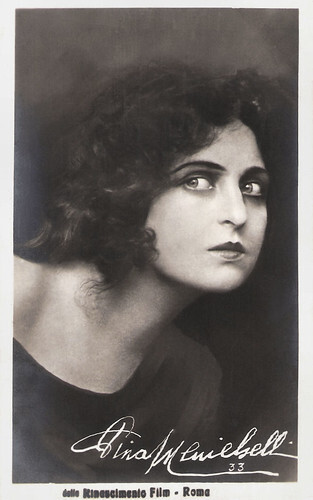
Italian postcard by La Rotofotografia, no. 33. Photo: Rinoscimento Film.
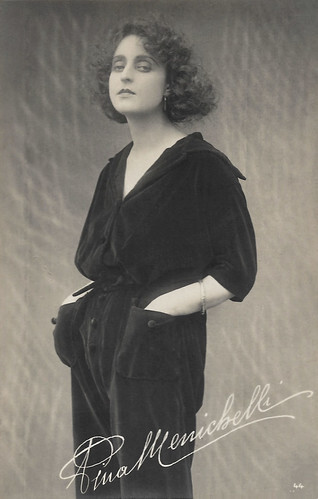
Italian postcard by Fotocelere, Torino, no. 44.
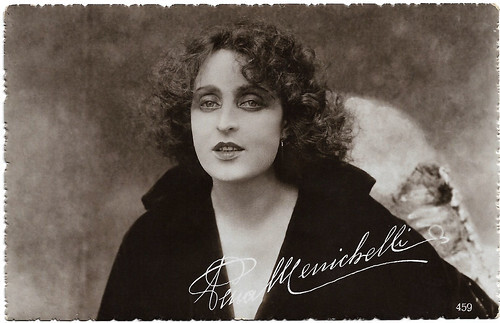
Italian postcard by Ed. A. Traldi, Milano, no. 459.
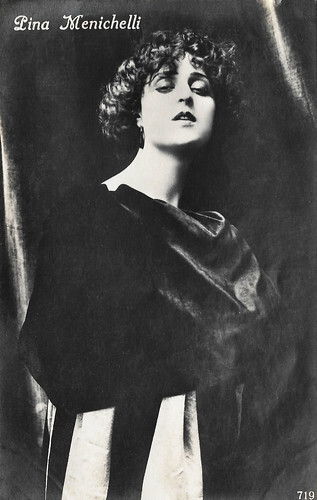
Italian postcard by Ed. A. Traldi, Milano, no. 719.
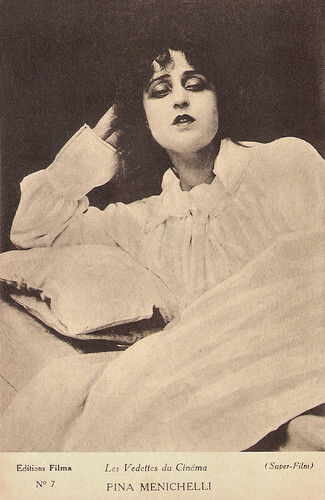
French postcard in the Les Vedettes du Cinéma series by Editions Filma, no. 7. Photo: Super-Film.
La trilogia di Dorina (1918)
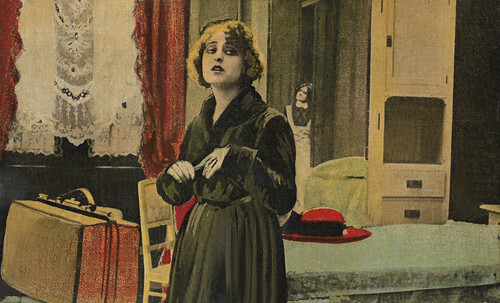
Spanish collectors card by Chocolate Imperiale, no. 1 of 9. Photo: Itala Film / Distr. J. Verdaguer, Barcelona. Pina Menichelli in La trilogia di Dorina Gero Zambuto, 1918), based on the eponymous play by Gerolamo Rovetta.
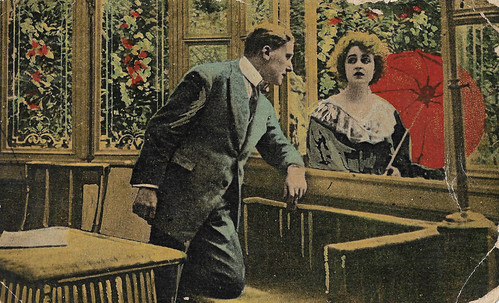
Spanish collectors card by Chocolate Imperiale, no. 2 of 9. Photo: Itala Film / Distr. J. Verdaguer, Barcelona. Alberto Nepoti and Pina Menichelli in La trilogia di Dorina Gero Zambuto, 1918), based on the eponymous play by Gerolamo Rovetta.
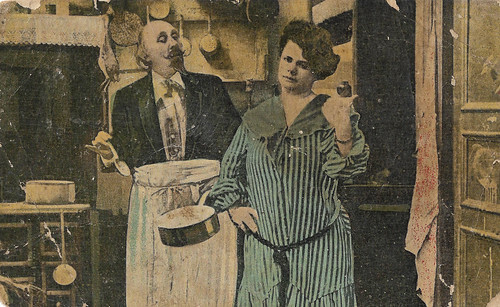
Spanish collectors card by Chocolate Imperiale, no. 3 of 9. Photo: Itala Film / Distr. J. Verdaguer, Barcelona. Scene from La trilogia di Dorina Gero Zambuto, 1918), based on the eponymous play by Gerolamo Rovetta. Probably this card depicts Dorina's parents, a once bourgeois couple that hit poverty. Unknown is who the actors are. It could also represent the moment Dorina is kicked out of the house of the marchioness. The woman depicted is not Mary-Cléo Tarlarini, who plays the marchioness.
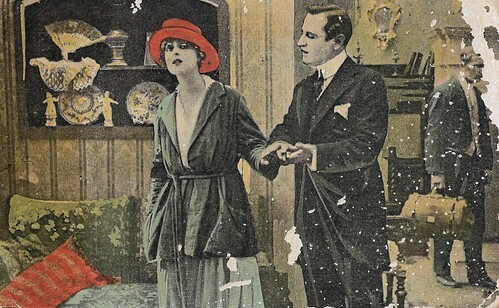
Spanish collectors card by Chocolate Imperiale, no. 4 of 9. Photo: Itala Film / Distr. J. Verdaguer, Barcelona. Pina Menichelli in La trilogia di Dorina (Gero Zambuto, 1918). The man could be the musician/choir leader (Gabriel Moreau) who helps her and discovers she is a talented singer.
Because of the sad economical conditions of her parents, the well-bred Dorina (Pina Menichelli) is forced to work as a private teacher with an austere marchioness (Mary-Cléo Tarlarini). She falls in love with the marchioness' son Niccolò (Alberto Nepoti), but the mother, afraid of marriage below her status, chases the girl. Welcomed by a musician (Gabriel Moreau) who discovers she has a beautiful voice, she receives an offer from an impresario (Antonio Monti), on condition she becomes his mistress. Offended, she refuses.
Accompanied by an older friend, don Luigi D'Albano (Vittorio Rossi-Pianelli), Niccolò, who has become rich, offers her money if she comes and lives with him. Even if still in love with him, she refuses the offer. D'Albano, profiting from the young man's loss, offers her his protection, becomes her friend, and launches her as an artist. Once she has become famous, Dorina enjoys the applause of the theatre audiences and the homages of all her admirers. Among them is Niccolò, now really in love with her. And Dorina, for whom success has not gone to her head, is now happy to accept the true love that Niccolò offers.
La trilogia di Dorina/The Dorina Trilogy (Gero Zambuto, 1918) was scripted by Giovanni Pastrone, who previously had launched Menichelli as the star in Il fuoco/The Fire (Giovanni Pastrone, 1915) and Tigre reale/The Royal Tigress (Giovanni Pastrone, 1916). In the latter film, Alberto Nepoti had already been her co-actor. Giovanni Tomatis and Segundo De Chomon were hired to care of the cinematography. The film had its premiere in Rome on 13 April 1918.
While Il fuoco had been a milestone, the press was disappointed about La trilogia di Dorina, hoping for more, but also expecting something closer to the original play. The role of Dorina, one critic wrote, was unfit for Menichelli, whose exuberance was so different from the part. While the male actors expressed elegance, their performance was considered rather on the heavy side.
Also, the mise-en-scene looked as if the film was made in too great haste, hoping for a fast reprise of the success of the previous two films with Menichelli. Perhaps the hand of Pastrone as director was missed. Still, this was what the press wrote at the time. Once this now-lost film will show up again, we may judge with our own eyes. Until then, we only have these images.
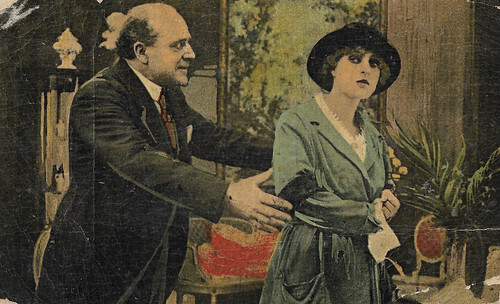
Spanish collectors card by Chocolate Imperiale, no. 5 of 9. Photo: Itala Film / Distr. J. Verdaguer, Barcelona. Pina Menichelli in La trilogia di Dorina (Gero Zambuto, 1918). The man may be Antonio Monti, who plays the impresario.
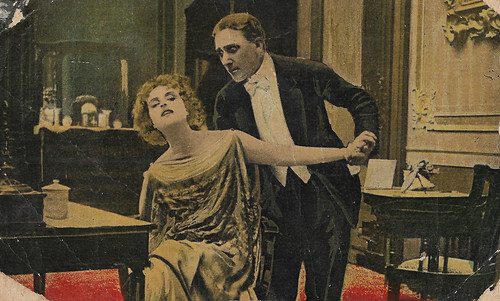
Spanish collectors card by Chocolate Imperiale, no. 8 of 9. Photo: Itala Film / Distr. J. Verdaguer, Barcelona. Pina Menichelli in La trilogia di Dorina Gero Zambuto, 1918).
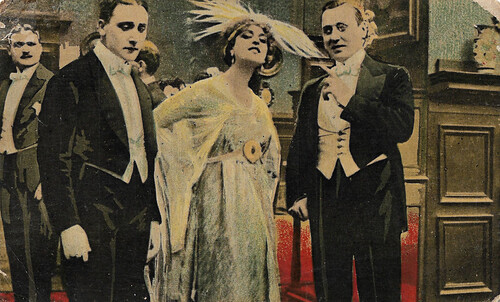
Spanish collectors card by Chocolate Imperiale, no. 9 of 9. Photo: Itala Film / Distr. J. Verdaguer, Barcelona. Pina Menichelli , Alberto Nepoti and Vittorio Rossi-Pianelli in La trilogia di Dorina (Gero Zambuto, 1918).
La passeggera (1918)
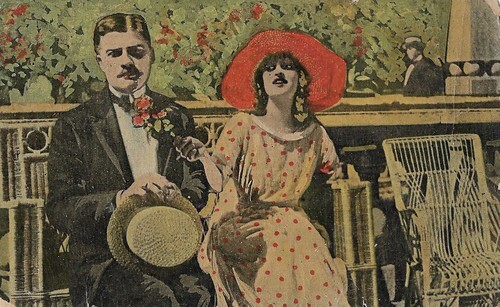
Spanish collectors card by Chocolate Imperiale, no. 2 of 9. Photo: Itala Film / Distr. J. Verdaguer, Barcelona. Pina Menichelli in La passeggera/The Passenger (Gero Zambuto, 1918), released in Spain as La pasajera, and based on a story 'La passagère' by Mme Guy de Chantepleure.
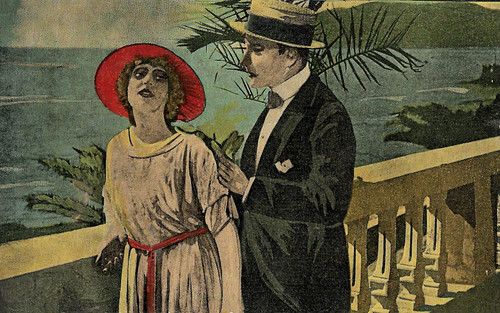
Spanish collectors card by Chocolate Pi, no. 3 of 9. Photo: Itala Film / Distr. J. Verdaguer, Barcelona. Pina Menichelli in La passeggera/The Passenger (Gero Zambuto, 1918), released in Spain as La pasajera, and based on a story 'La passagère' by Mme Guy de Chantepleure.
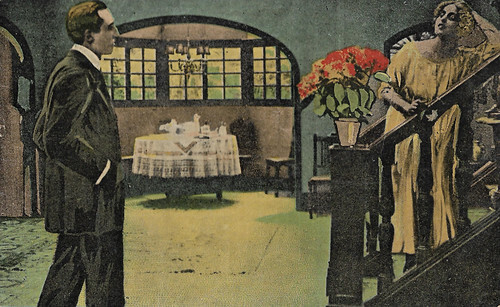
Spanish collectors card by Chocolate Imperiale, no. 4 of 9. Photo: Itala Film / Distr. J. Verdaguer, Barcelona. Pina Menichelli in La passeggiera aka La passagera (Gero Zambuto, 1918), released in Spain as La pasajera, and based on a story 'La passagère' by Mme Guy de Chantepleure.
The beautiful, sheltered, and somewhat naïve Lucía/Lucie Boijoli/Boisjoli ( Pina Menichelli ) has been adopted by the millionaire Davrancai, a woman (a man, according to other sources) who spares no expense on her behalf and treats her like a princess. But Davrancai is attacked and dies. It was her stated desire to make Lucía her heir, and she was preparing to legalise this, but the paperwork was not yet in place.
Her fortune, therefore, passes to a distant cousin, Laura Arguin — a bitter but devout woman — who is unwilling to take Lucía in. Primary among Lucía’s court of admirers is the cynical fortune-hunter Fabricio de Mauve (Luciano Molinari), who drops her in order to marry the daughter of a millionaire industrialist. Desperate, Lucía eventually turns to Guillermo Kerjean (Alberto Nepoti), a friend who is a mechanical engineer in charge of the Petain aviation company. As he is only thirty years old, she cannot live with him without arousing suspicion and gossip, but she hits upon a solution: they will enter a marriage of convenience.
Kerjean has spoken of how he does not wish to marry because it will interrupt his life of engineering productivity, Lucía will never love another man after the disappointment of Fabricio de Mauve: they can kill two birds with one stone and live together as affectionate companions. At first unconvinced, Kerjean comes around to the idea, and soon the strange marriage is formalised. Humour ensues as they have to prove their fake marriage, but eventually, real love grows between the pair.
Kerjean’s engineering work has gone very well, and proud of his accomplishments, he decides that he will fly the machine himself, accompanied by a passenger, “to demonstrate the stability and capacity of the device for long voyages”. When the launch is imminent, the mechanic who was to be the passenger does not come to the airfield because of a sudden illness, and so Lucía, even knowing the risk, decides to accompany her husband and become … la passeggiera. She will “participate in his Victory or die with him”. Their love acknowledged, Lucía and Kerjean will soar together on the wings of the powerful biplane.
While the story of La passagera/The Passenger (Gero Zambuto, 1918) was not very original, audiences and the press loved the performance of the two main actors. Only a short fragment of the film survives, alas, preserved by the Filmoteca de Catalunya.
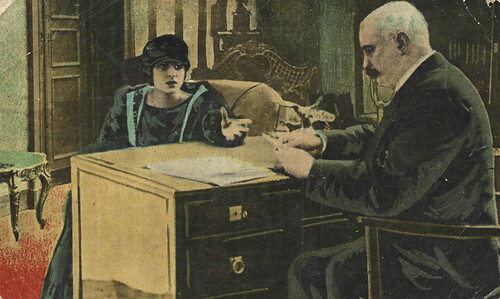
Spanish collectors card by Chocolate Pi, no. 5 of 9. Photo: Itala Film / Distr. J. Verdaguer, Barcelona. Pina Menichelli in La passeggera/The Passenger (Gero Zambuto, 1918), released in Spain as La pasajera.
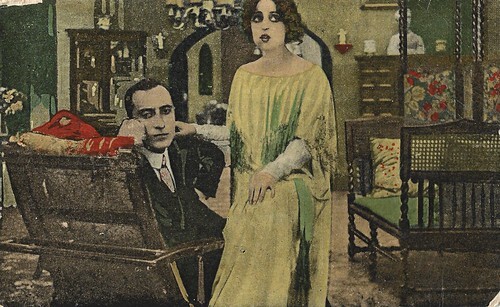
Spanish collectors card by Chocolate Pi, no. 6 of 9. Photo: Itala Film / Distr. J. Verdaguer, Barcelona. Pina Menichelli and possibly Luciano Molinari in La passeggera/The Passenger (Gero Zambuto, 1918), released in Spain as La pasajera.
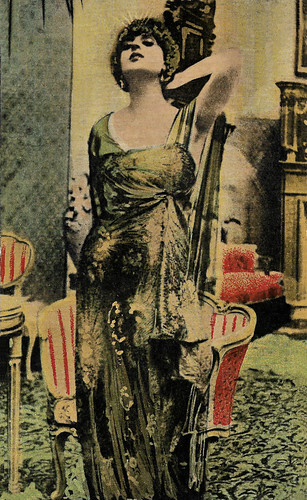
Spanish collectors card by Chocolate Pi, no. 9 of 9. Photo: Itala Film / Distr. J. Verdaguer, Barcelona. Pina Menichelli in La passeggera/The Passenger (Gero Zambuto, 1918), released in Spain as La pasajera.
Gemma di Sant'Eremo (1918)
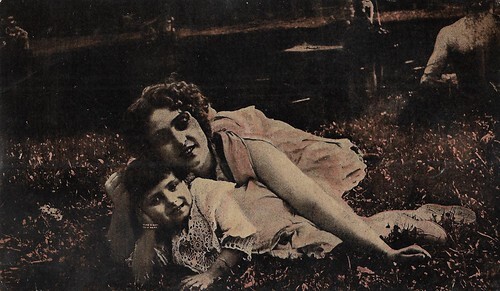
Spanish collectors card by Chocolate Salas-Sabadell, Barcelona, no. 1 of 6. Photo: Itala Film. Pina Menichelli in Gemma di Sant'Eremo (Alfredo Robert, 1918), released in Spain as La culpa (The Guilt).
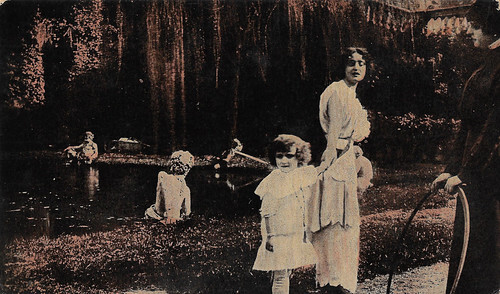
Spanish collectors card by Chocolate Salas-Sabadell, Barcelona, no. 3 of 6. Photo: Itala Film. Pina Menichelli in Gemma di Sant'Eremo (Alfredo Robert, 1918), released in Spain as La culpa (The Guilt).
Countess Gemma di Sant'Eremo ( Pina Menichelli ) is married to a frivolous and womanizing husband (Gabriel Moreau) and sees her marriage crumbling on the day she understands the cheating and lies of her man. A truly honest woman, Gemma does not want to avenge herself with the same arms, but destiny surprises her in a compromising conversation with marquis De Renzis (Alberto Nepoti).
To avoid a scandal, marquis De Renzis lets himself be accused of an attempt at robbery. Gemma is locked up by her husband in a castle but manages to escape. A tragic end to the husband makes an end to Gemma's suffering and opens up a reunion with her lover.
Gemma di Sant'Eremo/The Gem of St. Hermitage (Alfredo Robert, 1918) was praised in the Italian press and drew bourgeois crowds to the cinema, while also abroad, in Spain, France and Latin America. The film premiered in Rome on 4 February 1918. Only a fragment of the film has resurfaced and has been preserved by the Museo Nazionale del Cinema.
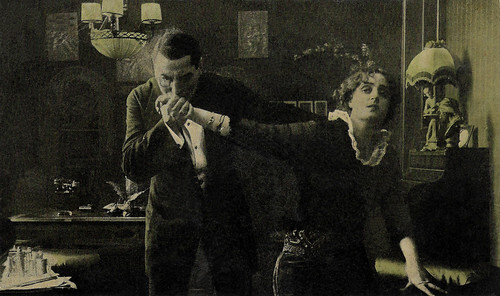
Spanish collectors card by Chocolate Salas-Sabadell, Barcelona, no. 4 of 6. Photo: Itala Film. Pina Menichelli in Gemma di Sant'Eremo (Alfredo Robert, 1918), released in Spain as La culpa (The Guilt). The man may be Gabriel Moreau, who plays Pina's husband, according to Vittorio Martinelli. Other sources say the husband is played by Edouard Davesnes.
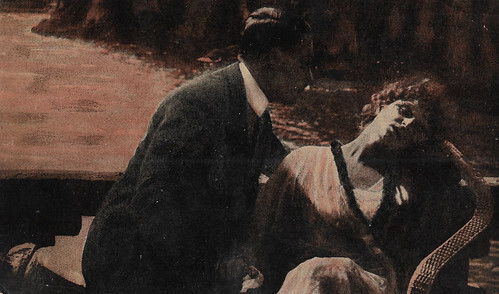
Spanish collectors card by Chocolate Salas-Sabadell, Barcelona, no. 6 of 6. Photo: Itala Film. Pina Menichelli and Alberto Nepoti in Gemma di Sant'Eremo (Alfredo Robert, 1918), released in Spain as La culpa (The Guilt).
Una sventatella (1918)
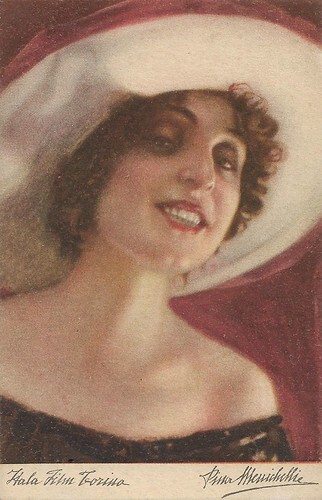
Italian postcard by Officina C. Ricordi, Milano"/ Uff. Rev. Stampa, Milano, 27-6-[19]17, no. 1325. Photo: Itala Film, Torino. Caption: "Da lunedi'7 Gennaio al Salone Ghersi, Pina Menichelli interprete di Una Sventatella." (From Monday, January 7th at the cinema Ghersi Pina Menicheli in Una Sventatella/A guttersnipe).
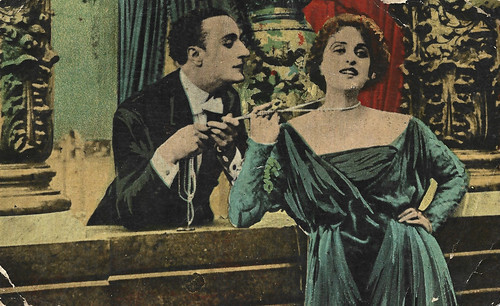
Spanish collectors card by Chocolate Imperiale, no. 3 of 6. Photo: Itala Film / Distr. J. Verdaguer, Barcelona. Pina Menichelli in Una sventatella (Gero Zambuto, 1918). The Spanish title was La pequeña atolondrada.
The cinema Ghersi was a cinema in Turin, Via Roma 40, inaugurated on 7 December 1915. The architect was Carlo Angelo Ceresa. The cinema could hold 2000 people. In 1935 the cinema was torn down to make room for the 'straightening' of the street.
Una sventatella/A guttersnipe (Gero Zambuto, 1918) was one of Pina Menichelli 's last films for Itala Film in Turin, after which she started to act at Rinascimento Film in Rome, her own company.
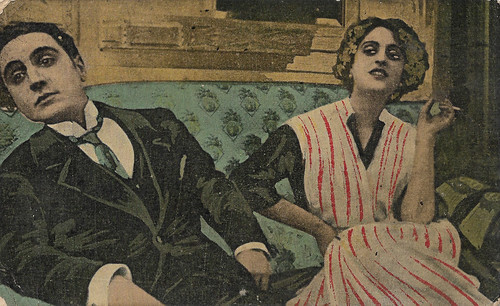
Spanish collectors card by Chocolate Imperiale, no. 4 of 6. Photo: Itala Film / Distr. J. Verdaguer, Barcelona. Pina Menichelli in Una sventatella (Gero Zambuto, 1918).
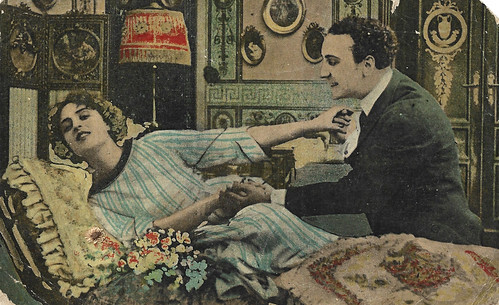
Spanish collectors card by Chocolate Imperiale, no. 5 of 6. Photo: Itala Film / Distr. J. Verdaguer, Barcelona. Pina Menichelli in Una sventatella (Gero Zambuto, 1918).
Il giardino incantato (1918)
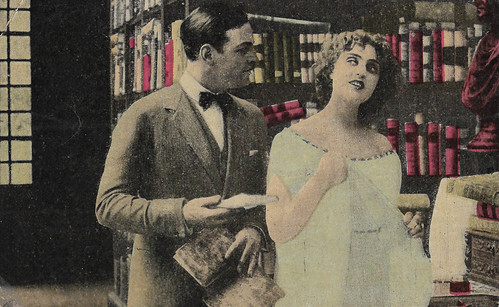
Spanish collectors card by Chocolate Imperiale, no. 1 of 6. Phot: Rinascimento Film / Distr. J. Verdaguer, Barcelona. Pina Menichelli and Luigi Serventi in Il giardino incantato (Eugenio Perego, 1918). The film was originally entitled Il giardino della voluttà, a title which the Spanish cards on the film kept, but which became forbidden by the Italian censor.
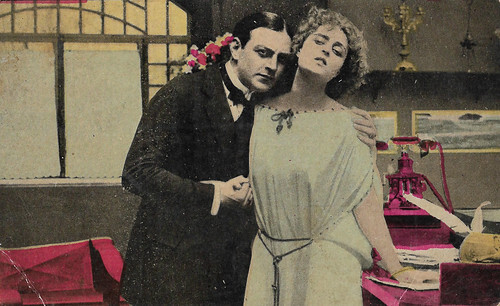
Spanish collectors card by Chocolate Imperiale, no. 4 of 6. Phot: Rinascimento Film / Distr. J. Verdaguer, Barcelona. Pina Menichelli in Il giardino incantato (Eugenio Perego, 1918).
Despite the opposition of her rich aunt Malvina (Elvira Pasquali), young Lilian Deruta ( Pina Menichelli ) marries the writer Giuliano Morris ( Luigi Serventi ), a detached and rather superficial man. Their life seems apparently happy, but fractures start to appear, as the aunt has cut her niece's allowance.
Used to a life of luxury, Giuliano commits a misstep by forgery. Liana by all means tries to help him. She goes to one of her former lovers, Lorenzo (Enrico Scatizzi), who promises to help provided she'll come to him. The sacrifice of the poor woman proves to have been in vain, as Giuliano, out of remorse, already has taken his own life.
The press praised Menichelli's restrained acting, after her exaggerated performances in previous films. Probably this was her first film at her own company Rinascimento Film, after her films at Itala Film. Critics only complained about the overload of the presence of the star.
Il giardino incantato//The Stronger Sex (Eugenio Perego, 1918) had its Roman premiere on 1 October 1918. The sets were by Charles Doudelet, and the cinematography was by Antonio Cufaro. A fragment of the film was saved by the Cineteca di Milano.
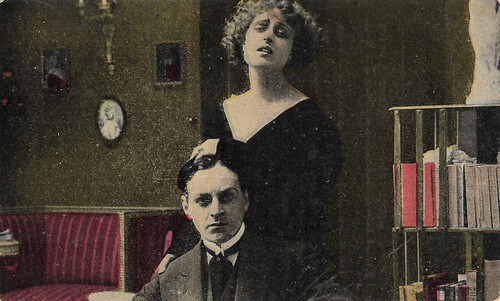
Spanish collectors card by Chocolate Imperiale, no. 5 of 6. Phot: Rinascimento Film / Distr. J. Verdaguer, Barcelona. Pina Menichelli and Luigi Serventi in Il giardino incantato/The Stronger Sex (Eugenio Perego, 1918).
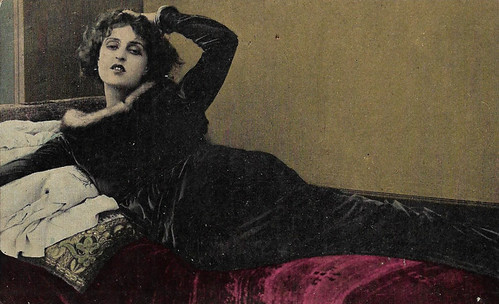
Spanish collectors card by Chocolate Imperiale, no. 6 of 6. Phot: Rinascimento Film / Distr. J. Verdaguer, Barcelona. Pina Menichelli in Il giardino incantato/The Stronger Sex (Eugenio Perego, 1918).
Source: Vittorio Martinelli (Il cinema muto italiano, Vol. 1918), and Sempre in penombra.

Italian postcard by La Rotofotografia, no. 33. Photo: Rinoscimento Film.

Italian postcard by Fotocelere, Torino, no. 44.

Italian postcard by Ed. A. Traldi, Milano, no. 459.

Italian postcard by Ed. A. Traldi, Milano, no. 719.

French postcard in the Les Vedettes du Cinéma series by Editions Filma, no. 7. Photo: Super-Film.
La trilogia di Dorina (1918)

Spanish collectors card by Chocolate Imperiale, no. 1 of 9. Photo: Itala Film / Distr. J. Verdaguer, Barcelona. Pina Menichelli in La trilogia di Dorina Gero Zambuto, 1918), based on the eponymous play by Gerolamo Rovetta.

Spanish collectors card by Chocolate Imperiale, no. 2 of 9. Photo: Itala Film / Distr. J. Verdaguer, Barcelona. Alberto Nepoti and Pina Menichelli in La trilogia di Dorina Gero Zambuto, 1918), based on the eponymous play by Gerolamo Rovetta.

Spanish collectors card by Chocolate Imperiale, no. 3 of 9. Photo: Itala Film / Distr. J. Verdaguer, Barcelona. Scene from La trilogia di Dorina Gero Zambuto, 1918), based on the eponymous play by Gerolamo Rovetta. Probably this card depicts Dorina's parents, a once bourgeois couple that hit poverty. Unknown is who the actors are. It could also represent the moment Dorina is kicked out of the house of the marchioness. The woman depicted is not Mary-Cléo Tarlarini, who plays the marchioness.

Spanish collectors card by Chocolate Imperiale, no. 4 of 9. Photo: Itala Film / Distr. J. Verdaguer, Barcelona. Pina Menichelli in La trilogia di Dorina (Gero Zambuto, 1918). The man could be the musician/choir leader (Gabriel Moreau) who helps her and discovers she is a talented singer.
Because of the sad economical conditions of her parents, the well-bred Dorina (Pina Menichelli) is forced to work as a private teacher with an austere marchioness (Mary-Cléo Tarlarini). She falls in love with the marchioness' son Niccolò (Alberto Nepoti), but the mother, afraid of marriage below her status, chases the girl. Welcomed by a musician (Gabriel Moreau) who discovers she has a beautiful voice, she receives an offer from an impresario (Antonio Monti), on condition she becomes his mistress. Offended, she refuses.
Accompanied by an older friend, don Luigi D'Albano (Vittorio Rossi-Pianelli), Niccolò, who has become rich, offers her money if she comes and lives with him. Even if still in love with him, she refuses the offer. D'Albano, profiting from the young man's loss, offers her his protection, becomes her friend, and launches her as an artist. Once she has become famous, Dorina enjoys the applause of the theatre audiences and the homages of all her admirers. Among them is Niccolò, now really in love with her. And Dorina, for whom success has not gone to her head, is now happy to accept the true love that Niccolò offers.
La trilogia di Dorina/The Dorina Trilogy (Gero Zambuto, 1918) was scripted by Giovanni Pastrone, who previously had launched Menichelli as the star in Il fuoco/The Fire (Giovanni Pastrone, 1915) and Tigre reale/The Royal Tigress (Giovanni Pastrone, 1916). In the latter film, Alberto Nepoti had already been her co-actor. Giovanni Tomatis and Segundo De Chomon were hired to care of the cinematography. The film had its premiere in Rome on 13 April 1918.
While Il fuoco had been a milestone, the press was disappointed about La trilogia di Dorina, hoping for more, but also expecting something closer to the original play. The role of Dorina, one critic wrote, was unfit for Menichelli, whose exuberance was so different from the part. While the male actors expressed elegance, their performance was considered rather on the heavy side.
Also, the mise-en-scene looked as if the film was made in too great haste, hoping for a fast reprise of the success of the previous two films with Menichelli. Perhaps the hand of Pastrone as director was missed. Still, this was what the press wrote at the time. Once this now-lost film will show up again, we may judge with our own eyes. Until then, we only have these images.

Spanish collectors card by Chocolate Imperiale, no. 5 of 9. Photo: Itala Film / Distr. J. Verdaguer, Barcelona. Pina Menichelli in La trilogia di Dorina (Gero Zambuto, 1918). The man may be Antonio Monti, who plays the impresario.

Spanish collectors card by Chocolate Imperiale, no. 8 of 9. Photo: Itala Film / Distr. J. Verdaguer, Barcelona. Pina Menichelli in La trilogia di Dorina Gero Zambuto, 1918).

Spanish collectors card by Chocolate Imperiale, no. 9 of 9. Photo: Itala Film / Distr. J. Verdaguer, Barcelona. Pina Menichelli , Alberto Nepoti and Vittorio Rossi-Pianelli in La trilogia di Dorina (Gero Zambuto, 1918).
La passeggera (1918)

Spanish collectors card by Chocolate Imperiale, no. 2 of 9. Photo: Itala Film / Distr. J. Verdaguer, Barcelona. Pina Menichelli in La passeggera/The Passenger (Gero Zambuto, 1918), released in Spain as La pasajera, and based on a story 'La passagère' by Mme Guy de Chantepleure.

Spanish collectors card by Chocolate Pi, no. 3 of 9. Photo: Itala Film / Distr. J. Verdaguer, Barcelona. Pina Menichelli in La passeggera/The Passenger (Gero Zambuto, 1918), released in Spain as La pasajera, and based on a story 'La passagère' by Mme Guy de Chantepleure.

Spanish collectors card by Chocolate Imperiale, no. 4 of 9. Photo: Itala Film / Distr. J. Verdaguer, Barcelona. Pina Menichelli in La passeggiera aka La passagera (Gero Zambuto, 1918), released in Spain as La pasajera, and based on a story 'La passagère' by Mme Guy de Chantepleure.
The beautiful, sheltered, and somewhat naïve Lucía/Lucie Boijoli/Boisjoli ( Pina Menichelli ) has been adopted by the millionaire Davrancai, a woman (a man, according to other sources) who spares no expense on her behalf and treats her like a princess. But Davrancai is attacked and dies. It was her stated desire to make Lucía her heir, and she was preparing to legalise this, but the paperwork was not yet in place.
Her fortune, therefore, passes to a distant cousin, Laura Arguin — a bitter but devout woman — who is unwilling to take Lucía in. Primary among Lucía’s court of admirers is the cynical fortune-hunter Fabricio de Mauve (Luciano Molinari), who drops her in order to marry the daughter of a millionaire industrialist. Desperate, Lucía eventually turns to Guillermo Kerjean (Alberto Nepoti), a friend who is a mechanical engineer in charge of the Petain aviation company. As he is only thirty years old, she cannot live with him without arousing suspicion and gossip, but she hits upon a solution: they will enter a marriage of convenience.
Kerjean has spoken of how he does not wish to marry because it will interrupt his life of engineering productivity, Lucía will never love another man after the disappointment of Fabricio de Mauve: they can kill two birds with one stone and live together as affectionate companions. At first unconvinced, Kerjean comes around to the idea, and soon the strange marriage is formalised. Humour ensues as they have to prove their fake marriage, but eventually, real love grows between the pair.
Kerjean’s engineering work has gone very well, and proud of his accomplishments, he decides that he will fly the machine himself, accompanied by a passenger, “to demonstrate the stability and capacity of the device for long voyages”. When the launch is imminent, the mechanic who was to be the passenger does not come to the airfield because of a sudden illness, and so Lucía, even knowing the risk, decides to accompany her husband and become … la passeggiera. She will “participate in his Victory or die with him”. Their love acknowledged, Lucía and Kerjean will soar together on the wings of the powerful biplane.
While the story of La passagera/The Passenger (Gero Zambuto, 1918) was not very original, audiences and the press loved the performance of the two main actors. Only a short fragment of the film survives, alas, preserved by the Filmoteca de Catalunya.

Spanish collectors card by Chocolate Pi, no. 5 of 9. Photo: Itala Film / Distr. J. Verdaguer, Barcelona. Pina Menichelli in La passeggera/The Passenger (Gero Zambuto, 1918), released in Spain as La pasajera.

Spanish collectors card by Chocolate Pi, no. 6 of 9. Photo: Itala Film / Distr. J. Verdaguer, Barcelona. Pina Menichelli and possibly Luciano Molinari in La passeggera/The Passenger (Gero Zambuto, 1918), released in Spain as La pasajera.

Spanish collectors card by Chocolate Pi, no. 9 of 9. Photo: Itala Film / Distr. J. Verdaguer, Barcelona. Pina Menichelli in La passeggera/The Passenger (Gero Zambuto, 1918), released in Spain as La pasajera.
Gemma di Sant'Eremo (1918)

Spanish collectors card by Chocolate Salas-Sabadell, Barcelona, no. 1 of 6. Photo: Itala Film. Pina Menichelli in Gemma di Sant'Eremo (Alfredo Robert, 1918), released in Spain as La culpa (The Guilt).

Spanish collectors card by Chocolate Salas-Sabadell, Barcelona, no. 3 of 6. Photo: Itala Film. Pina Menichelli in Gemma di Sant'Eremo (Alfredo Robert, 1918), released in Spain as La culpa (The Guilt).
Countess Gemma di Sant'Eremo ( Pina Menichelli ) is married to a frivolous and womanizing husband (Gabriel Moreau) and sees her marriage crumbling on the day she understands the cheating and lies of her man. A truly honest woman, Gemma does not want to avenge herself with the same arms, but destiny surprises her in a compromising conversation with marquis De Renzis (Alberto Nepoti).
To avoid a scandal, marquis De Renzis lets himself be accused of an attempt at robbery. Gemma is locked up by her husband in a castle but manages to escape. A tragic end to the husband makes an end to Gemma's suffering and opens up a reunion with her lover.
Gemma di Sant'Eremo/The Gem of St. Hermitage (Alfredo Robert, 1918) was praised in the Italian press and drew bourgeois crowds to the cinema, while also abroad, in Spain, France and Latin America. The film premiered in Rome on 4 February 1918. Only a fragment of the film has resurfaced and has been preserved by the Museo Nazionale del Cinema.

Spanish collectors card by Chocolate Salas-Sabadell, Barcelona, no. 4 of 6. Photo: Itala Film. Pina Menichelli in Gemma di Sant'Eremo (Alfredo Robert, 1918), released in Spain as La culpa (The Guilt). The man may be Gabriel Moreau, who plays Pina's husband, according to Vittorio Martinelli. Other sources say the husband is played by Edouard Davesnes.

Spanish collectors card by Chocolate Salas-Sabadell, Barcelona, no. 6 of 6. Photo: Itala Film. Pina Menichelli and Alberto Nepoti in Gemma di Sant'Eremo (Alfredo Robert, 1918), released in Spain as La culpa (The Guilt).
Una sventatella (1918)

Italian postcard by Officina C. Ricordi, Milano"/ Uff. Rev. Stampa, Milano, 27-6-[19]17, no. 1325. Photo: Itala Film, Torino. Caption: "Da lunedi'7 Gennaio al Salone Ghersi, Pina Menichelli interprete di Una Sventatella." (From Monday, January 7th at the cinema Ghersi Pina Menicheli in Una Sventatella/A guttersnipe).

Spanish collectors card by Chocolate Imperiale, no. 3 of 6. Photo: Itala Film / Distr. J. Verdaguer, Barcelona. Pina Menichelli in Una sventatella (Gero Zambuto, 1918). The Spanish title was La pequeña atolondrada.
The cinema Ghersi was a cinema in Turin, Via Roma 40, inaugurated on 7 December 1915. The architect was Carlo Angelo Ceresa. The cinema could hold 2000 people. In 1935 the cinema was torn down to make room for the 'straightening' of the street.
Una sventatella/A guttersnipe (Gero Zambuto, 1918) was one of Pina Menichelli 's last films for Itala Film in Turin, after which she started to act at Rinascimento Film in Rome, her own company.

Spanish collectors card by Chocolate Imperiale, no. 4 of 6. Photo: Itala Film / Distr. J. Verdaguer, Barcelona. Pina Menichelli in Una sventatella (Gero Zambuto, 1918).

Spanish collectors card by Chocolate Imperiale, no. 5 of 6. Photo: Itala Film / Distr. J. Verdaguer, Barcelona. Pina Menichelli in Una sventatella (Gero Zambuto, 1918).
Il giardino incantato (1918)

Spanish collectors card by Chocolate Imperiale, no. 1 of 6. Phot: Rinascimento Film / Distr. J. Verdaguer, Barcelona. Pina Menichelli and Luigi Serventi in Il giardino incantato (Eugenio Perego, 1918). The film was originally entitled Il giardino della voluttà, a title which the Spanish cards on the film kept, but which became forbidden by the Italian censor.

Spanish collectors card by Chocolate Imperiale, no. 4 of 6. Phot: Rinascimento Film / Distr. J. Verdaguer, Barcelona. Pina Menichelli in Il giardino incantato (Eugenio Perego, 1918).
Despite the opposition of her rich aunt Malvina (Elvira Pasquali), young Lilian Deruta ( Pina Menichelli ) marries the writer Giuliano Morris ( Luigi Serventi ), a detached and rather superficial man. Their life seems apparently happy, but fractures start to appear, as the aunt has cut her niece's allowance.
Used to a life of luxury, Giuliano commits a misstep by forgery. Liana by all means tries to help him. She goes to one of her former lovers, Lorenzo (Enrico Scatizzi), who promises to help provided she'll come to him. The sacrifice of the poor woman proves to have been in vain, as Giuliano, out of remorse, already has taken his own life.
The press praised Menichelli's restrained acting, after her exaggerated performances in previous films. Probably this was her first film at her own company Rinascimento Film, after her films at Itala Film. Critics only complained about the overload of the presence of the star.
Il giardino incantato//The Stronger Sex (Eugenio Perego, 1918) had its Roman premiere on 1 October 1918. The sets were by Charles Doudelet, and the cinematography was by Antonio Cufaro. A fragment of the film was saved by the Cineteca di Milano.

Spanish collectors card by Chocolate Imperiale, no. 5 of 6. Phot: Rinascimento Film / Distr. J. Verdaguer, Barcelona. Pina Menichelli and Luigi Serventi in Il giardino incantato/The Stronger Sex (Eugenio Perego, 1918).

Spanish collectors card by Chocolate Imperiale, no. 6 of 6. Phot: Rinascimento Film / Distr. J. Verdaguer, Barcelona. Pina Menichelli in Il giardino incantato/The Stronger Sex (Eugenio Perego, 1918).
Source: Vittorio Martinelli (Il cinema muto italiano, Vol. 1918), and Sempre in penombra.
Published on February 08, 2023 22:00
Five Pina Menichelli films : La trilogia di Dorina (1918), La passeggera (1918), Gemma di Sant'Eremo (1918), Una sventatella (1918) and Il giardino incantato (1918)
Pina Menichelli (1890-1984) was the most bizarre Italian diva of the silent era. With her contorted postures and disdainful expression, she impersonated the striking femme fatale. Today, EFSP presents five films with the fascinating and enigmatic diva: La trilogia di Dorina/The Dorina Trilogy, La passeggera/The Passenger, Gemma di Sant'Eremo/The Gem of St. Hermitage, Una sventatella/A guttersnipe and Il giardino incantato/The Stronger Sex. All five were presented in 1918.

Italian postcard by La Rotofotografia, no. 33. Photo: Rinoscimento Film.

Italian postcard by Fotocelere, Torino, no. 44.

Italian postcard by Ed. A. Traldi, Milano, no. 459.

Italian postcard by Ed. A. Traldi, Milano, no. 719.

French postcard in the Les Vedettes du Cinéma series by Editions Filma, no. 7. Photo: Super-Film.
La trilogia di Dorina (1918)

Spanish collectors card by Chocolate Imperiale, no. 1 of 9. Photo: Itala Film / Distr. J. Verdaguer, Barcelona. Pina Menichelli in La trilogia di Dorina Gero Zambuto, 1918), based on the eponymous play by Gerolamo Rovetta.

Spanish collectors card by Chocolate Imperiale, no. 2 of 9. Photo: Itala Film / Distr. J. Verdaguer, Barcelona. Alberto Nepoti and Pina Menichelli in La trilogia di Dorina Gero Zambuto, 1918), based on the eponymous play by Gerolamo Rovetta.

Spanish collectors card by Chocolate Imperiale, no. 3 of 9. Photo: Itala Film / Distr. J. Verdaguer, Barcelona. Scene from La trilogia di Dorina Gero Zambuto, 1918), based on the eponymous play by Gerolamo Rovetta. Probably this card depicts Dorina's parents, a once bourgeois couple that hit poverty. Unknown is who the actors are. It could also represent the moment Dorina is kicked out of the house of the marchioness. The woman depicted is not Mary-Cléo Tarlarini, who plays the marchioness.

Spanish collectors card by Chocolate Imperiale, no. 4 of 9. Photo: Itala Film / Distr. J. Verdaguer, Barcelona. Pina Menichelli in La trilogia di Dorina (Gero Zambuto, 1918). The man could be the musician/choir leader (Gabriel Moreau) who helps her and discovers she is a talented singer.
Because of the sad economical conditions of her parents, the well-bred Dorina (Pina Menichelli) is forced to work as a private teacher with an austere marchioness (Mary-Cléo Tarlarini). She falls in love with the marchioness' son Niccolò (Alberto Nepoti), but the mother, afraid of marriage below her status, chases the girl. Welcomed by a musician (Gabriel Moreau) who discovers she has a beautiful voice, she receives an offer from an impresario (Antonio Monti), on condition she becomes his mistress. Offended, she refuses.
Accompanied by an older friend, don Luigi D'Albano (Vittorio Rossi-Pianelli), Niccolò, who has become rich, offers her money if she comes and lives with him. Even if still in love with him, she refuses the offer. D'Albano, profiting from the young man's loss, offers her his protection, becomes her friend, and launches her as an artist. Once she has become famous, Dorina enjoys the applause of the theatre audiences and the homages of all her admirers. Among them is Niccolò, now really in love with her. And Dorina, for whom success has not gone to her head, is now happy to accept the true love that Niccolò offers.
La trilogia di Dorina/The Dorina Trilogy (Gero Zambuto, 1918) was scripted by Giovanni Pastrone, who previously had launched Menichelli as the star in Il fuoco/The Fire (Giovanni Pastrone, 1915) and Tigre reale/The Royal Tigress (Giovanni Pastrone, 1916). In the latter film, Alberto Nepoti had already been her co-actor. Giovanni Tomatis and Segundo De Chomon were hired to care of the cinematography. The film had its premiere in Rome on 13 April 1918.
While Il fuoco had been a milestone, the press was disappointed about La trilogia di Dorina, hoping for more, but also expecting something closer to the original play. The role of Dorina, one critic wrote, was unfit for Menichelli, whose exuberance was so different from the part. While the male actors expressed elegance, their performance was considered rather on the heavy side.
Also, the mise-en-scene looked as if the film was made in too great haste, hoping for a fast reprise of the success of the previous two films with Menichelli. Perhaps the hand of Pastrone as director was missed. Still, this was what the press wrote at the time. Once this now-lost film will show up again, we may judge with our own eyes. Until then, we only have these images.

Spanish collectors card by Chocolate Imperiale, no. 5 of 9. Photo: Itala Film / Distr. J. Verdaguer, Barcelona. Pina Menichelli in La trilogia di Dorina (Gero Zambuto, 1918). The man may be Antonio Monti, who plays the impresario.

Spanish collectors card by Chocolate Imperiale, no. 8 of 9. Photo: Itala Film / Distr. J. Verdaguer, Barcelona. Pina Menichelli in La trilogia di Dorina Gero Zambuto, 1918).

Spanish collectors card by Chocolate Imperiale, no. 9 of 9. Photo: Itala Film / Distr. J. Verdaguer, Barcelona. Pina Menichelli , Alberto Nepoti and Vittorio Rossi-Pianelli in La trilogia di Dorina (Gero Zambuto, 1918).
La passeggera (1918)

Spanish collectors card by Chocolate Imperiale, no. 2 of 9. Photo: Itala Film / Distr. J. Verdaguer, Barcelona. Pina Menichelli in La passeggera/The Passenger (Gero Zambuto, 1918), released in Spain as La pasajera, and based on a story 'La passagère' by Mme Guy de Chantepleure.

Spanish collectors card by Chocolate Pi, no. 3 of 9. Photo: Itala Film / Distr. J. Verdaguer, Barcelona. Pina Menichelli in La passeggera/The Passenger (Gero Zambuto, 1918), released in Spain as La pasajera, and based on a story 'La passagère' by Mme Guy de Chantepleure.

Spanish collectors card by Chocolate Imperiale, no. 4 of 9. Photo: Itala Film / Distr. J. Verdaguer, Barcelona. Pina Menichelli in La passeggiera aka La passagera (Gero Zambuto, 1918), released in Spain as La pasajera, and based on a story 'La passagère' by Mme Guy de Chantepleure.
The beautiful, sheltered, and somewhat naïve Lucía/Lucie Boijoli/Boisjoli ( Pina Menichelli ) has been adopted by the millionaire Davrancai, a woman (a man, according to other sources) who spares no expense on her behalf and treats her like a princess. But Davrancai is attacked and dies. It was her stated desire to make Lucía her heir, and she was preparing to legalise this, but the paperwork was not yet in place.
Her fortune, therefore, passes to a distant cousin, Laura Arguin — a bitter but devout woman — who is unwilling to take Lucía in. Primary among Lucía’s court of admirers is the cynical fortune-hunter Fabricio de Mauve (Luciano Molinari), who drops her in order to marry the daughter of a millionaire industrialist. Desperate, Lucía eventually turns to Guillermo Kerjean (Alberto Nepoti), a friend who is a mechanical engineer in charge of the Petain aviation company. As he is only thirty years old, she cannot live with him without arousing suspicion and gossip, but she hits upon a solution: they will enter a marriage of convenience.
Kerjean has spoken of how he does not wish to marry because it will interrupt his life of engineering productivity, Lucía will never love another man after the disappointment of Fabricio de Mauve: they can kill two birds with one stone and live together as affectionate companions. At first unconvinced, Kerjean comes around to the idea, and soon the strange marriage is formalised. Humour ensues as they have to prove their fake marriage, but eventually, real love grows between the pair.
Kerjean’s engineering work has gone very well, and proud of his accomplishments, he decides that he will fly the machine himself, accompanied by a passenger, “to demonstrate the stability and capacity of the device for long voyages”. When the launch is imminent, the mechanic who was to be the passenger does not come to the airfield because of a sudden illness, and so Lucía, even knowing the risk, decides to accompany her husband and become … la passeggiera. She will “participate in his Victory or die with him”. Their love acknowledged, Lucía and Kerjean will soar together on the wings of the powerful biplane.
While the story of La passagera/The Passenger (Gero Zambuto, 1918) was not very original, audiences and the press loved the performance of the two main actors. Only a short fragment of the film survives, alas, preserved by the Filmoteca de Catalunya.

Spanish collectors card by Chocolate Pi, no. 5 of 9. Photo: Itala Film / Distr. J. Verdaguer, Barcelona. Pina Menichelli in La passeggera/The Passenger (Gero Zambuto, 1918), released in Spain as La pasajera.

Spanish collectors card by Chocolate Pi, no. 6 of 9. Photo: Itala Film / Distr. J. Verdaguer, Barcelona. Pina Menichelli and possibly Luciano Molinari in La passeggera/The Passenger (Gero Zambuto, 1918), released in Spain as La pasajera.

Spanish collectors card by Chocolate Pi, no. 9 of 9. Photo: Itala Film / Distr. J. Verdaguer, Barcelona. Pina Menichelli in La passeggera/The Passenger (Gero Zambuto, 1918), released in Spain as La pasajera.
Gemma di Sant'Eremo (1918)

Spanish collectors card by Chocolate Salas-Sabadell, Barcelona, no. 1 of 6. Photo: Itala Film. Pina Menichelli in Gemma di Sant'Eremo (Alfredo Robert, 1918), released in Spain as La culpa (The Guilt).

Spanish collectors card by Chocolate Salas-Sabadell, Barcelona, no. 3 of 6. Photo: Itala Film. Pina Menichelli in Gemma di Sant'Eremo (Alfredo Robert, 1918), released in Spain as La culpa (The Guilt).
Countess Gemma di Sant'Eremo ( Pina Menichelli ) is married to a frivolous and womanizing husband (Gabriel Moreau) and sees her marriage crumbling on the day she understands the cheating and lies of her man. A truly honest woman, Gemma does not want to avenge herself with the same arms, but destiny surprises her in a compromising conversation with marquis De Renzis (Alberto Nepoti).
To avoid a scandal, marquis De Renzis lets himself be accused of an attempt at robbery. Gemma is locked up by her husband in a castle but manages to escape. A tragic end to the husband makes an end to Gemma's suffering and opens up a reunion with her lover.
Gemma di Sant'Eremo/The Gem of St. Hermitage (Alfredo Robert, 1918) was praised in the Italian press and drew bourgeois crowds to the cinema, while also abroad, in Spain, France and Latin America. The film premiered in Rome on 4 February 1918. Only a fragment of the film has resurfaced and has been preserved by the Museo Nazionale del Cinema.

Spanish collectors card by Chocolate Salas-Sabadell, Barcelona, no. 4 of 6. Photo: Itala Film. Pina Menichelli in Gemma di Sant'Eremo (Alfredo Robert, 1918), released in Spain as La culpa (The Guilt). The man may be Gabriel Moreau, who plays Pina's husband, according to Vittorio Martinelli. Other sources say the husband is played by Edouard Davesnes.

Spanish collectors card by Chocolate Salas-Sabadell, Barcelona, no. 6 of 6. Photo: Itala Film. Pina Menichelli and Alberto Nepoti in Gemma di Sant'Eremo (Alfredo Robert, 1918), released in Spain as La culpa (The Guilt).
Una sventatella (1918)

Italian postcard by Officina C. Ricordi, Milano"/ Uff. Rev. Stampa, Milano, 27-6-[19]17, no. 1325. Photo: Itala Film, Torino. Caption: "Da lunedi'7 Gennaio al Salone Ghersi, Pina Menichelli interprete di Una Sventatella." (From Monday, January 7th at the cinema Ghersi Pina Menicheli in Una Sventatella/A guttersnipe).

Spanish collectors card by Chocolate Imperiale, no. 3 of 6. Photo: Itala Film / Distr. J. Verdaguer, Barcelona. Pina Menichelli in Una sventatella (Gero Zambuto, 1918). The Spanish title was La pequeña atolondrada.
The cinema Ghersi was a cinema in Turin, Via Roma 40, inaugurated on 7 December 1915. The architect was Carlo Angelo Ceresa. The cinema could hold 2000 people. In 1935 the cinema was torn down to make room for the 'straightening' of the street.
Una sventatella/A guttersnipe (Gero Zambuto, 1918) was one of Pina Menichelli 's last films for Itala Film in Turin, after which she started to act at Rinascimento Film in Rome, her own company.

Spanish collectors card by Chocolate Imperiale, no. 4 of 6. Photo: Itala Film / Distr. J. Verdaguer, Barcelona. Pina Menichelli in Una sventatella (Gero Zambuto, 1918).

Spanish collectors card by Chocolate Imperiale, no. 5 of 6. Photo: Itala Film / Distr. J. Verdaguer, Barcelona. Pina Menichelli in Una sventatella (Gero Zambuto, 1918).
Il giardino incantato (1918)

Spanish collectors card by Chocolate Imperiale, no. 1 of 6. Phot: Rinascimento Film / Distr. J. Verdaguer, Barcelona. Pina Menichelli and Luigi Serventi in Il giardino incantato (Eugenio Perego, 1918). The film was originally entitled Il giardino della voluttà, a title which the Spanish cards on the film kept, but which became forbidden by the Italian censor.

Spanish collectors card by Chocolate Imperiale, no. 4 of 6. Phot: Rinascimento Film / Distr. J. Verdaguer, Barcelona. Pina Menichelli in Il giardino incantato (Eugenio Perego, 1918).
Despite the opposition of her rich aunt Malvina (Elvira Pasquali), young Lilian Deruta ( Pina Menichelli ) marries the writer Giuliano Morris ( Luigi Serventi ), a detached and rather superficial man. Their life seems apparently happy, but fractures start to appear, as the aunt has cut her niece's allowance.
Used to a life of luxury, Giuliano commits a misstep by forgery. Liana by all means tries to help him. She goes to one of her former lovers, Lorenzo (Enrico Scatizzi), who promises to help provided she'll come to him. The sacrifice of the poor woman proves to have been in vain, as Giuliano, out of remorse, already has taken his own life.
The press praised Menichelli's restrained acting, after her exaggerated performances in previous films. Probably this was her first film at her own company Rinascimento Film, after her films at Itala Film. Critics only complained about the overload of the presence of the star.
Il giardino incantato//The Stronger Sex (Eugenio Perego, 1918) had its Roman premiere on 1 October 1918. The sets were by Charles Doudelet, and the cinematography was by Antonio Cufaro. A fragment of the film was saved by the Cineteca di Milano.

Spanish collectors card by Chocolate Imperiale, no. 5 of 6. Phot: Rinascimento Film / Distr. J. Verdaguer, Barcelona. Pina Menichelli and Luigi Serventi in Il giardino incantato/The Stronger Sex (Eugenio Perego, 1918).

Spanish collectors card by Chocolate Imperiale, no. 6 of 6. Phot: Rinascimento Film / Distr. J. Verdaguer, Barcelona. Pina Menichelli in Il giardino incantato/The Stronger Sex (Eugenio Perego, 1918).
Source: Vittorio Martinelli (Il cinema muto italiano, Vol. 1918), and Sempre in penombra.

Italian postcard by La Rotofotografia, no. 33. Photo: Rinoscimento Film.

Italian postcard by Fotocelere, Torino, no. 44.

Italian postcard by Ed. A. Traldi, Milano, no. 459.

Italian postcard by Ed. A. Traldi, Milano, no. 719.

French postcard in the Les Vedettes du Cinéma series by Editions Filma, no. 7. Photo: Super-Film.
La trilogia di Dorina (1918)

Spanish collectors card by Chocolate Imperiale, no. 1 of 9. Photo: Itala Film / Distr. J. Verdaguer, Barcelona. Pina Menichelli in La trilogia di Dorina Gero Zambuto, 1918), based on the eponymous play by Gerolamo Rovetta.

Spanish collectors card by Chocolate Imperiale, no. 2 of 9. Photo: Itala Film / Distr. J. Verdaguer, Barcelona. Alberto Nepoti and Pina Menichelli in La trilogia di Dorina Gero Zambuto, 1918), based on the eponymous play by Gerolamo Rovetta.

Spanish collectors card by Chocolate Imperiale, no. 3 of 9. Photo: Itala Film / Distr. J. Verdaguer, Barcelona. Scene from La trilogia di Dorina Gero Zambuto, 1918), based on the eponymous play by Gerolamo Rovetta. Probably this card depicts Dorina's parents, a once bourgeois couple that hit poverty. Unknown is who the actors are. It could also represent the moment Dorina is kicked out of the house of the marchioness. The woman depicted is not Mary-Cléo Tarlarini, who plays the marchioness.

Spanish collectors card by Chocolate Imperiale, no. 4 of 9. Photo: Itala Film / Distr. J. Verdaguer, Barcelona. Pina Menichelli in La trilogia di Dorina (Gero Zambuto, 1918). The man could be the musician/choir leader (Gabriel Moreau) who helps her and discovers she is a talented singer.
Because of the sad economical conditions of her parents, the well-bred Dorina (Pina Menichelli) is forced to work as a private teacher with an austere marchioness (Mary-Cléo Tarlarini). She falls in love with the marchioness' son Niccolò (Alberto Nepoti), but the mother, afraid of marriage below her status, chases the girl. Welcomed by a musician (Gabriel Moreau) who discovers she has a beautiful voice, she receives an offer from an impresario (Antonio Monti), on condition she becomes his mistress. Offended, she refuses.
Accompanied by an older friend, don Luigi D'Albano (Vittorio Rossi-Pianelli), Niccolò, who has become rich, offers her money if she comes and lives with him. Even if still in love with him, she refuses the offer. D'Albano, profiting from the young man's loss, offers her his protection, becomes her friend, and launches her as an artist. Once she has become famous, Dorina enjoys the applause of the theatre audiences and the homages of all her admirers. Among them is Niccolò, now really in love with her. And Dorina, for whom success has not gone to her head, is now happy to accept the true love that Niccolò offers.
La trilogia di Dorina/The Dorina Trilogy (Gero Zambuto, 1918) was scripted by Giovanni Pastrone, who previously had launched Menichelli as the star in Il fuoco/The Fire (Giovanni Pastrone, 1915) and Tigre reale/The Royal Tigress (Giovanni Pastrone, 1916). In the latter film, Alberto Nepoti had already been her co-actor. Giovanni Tomatis and Segundo De Chomon were hired to care of the cinematography. The film had its premiere in Rome on 13 April 1918.
While Il fuoco had been a milestone, the press was disappointed about La trilogia di Dorina, hoping for more, but also expecting something closer to the original play. The role of Dorina, one critic wrote, was unfit for Menichelli, whose exuberance was so different from the part. While the male actors expressed elegance, their performance was considered rather on the heavy side.
Also, the mise-en-scene looked as if the film was made in too great haste, hoping for a fast reprise of the success of the previous two films with Menichelli. Perhaps the hand of Pastrone as director was missed. Still, this was what the press wrote at the time. Once this now-lost film will show up again, we may judge with our own eyes. Until then, we only have these images.

Spanish collectors card by Chocolate Imperiale, no. 5 of 9. Photo: Itala Film / Distr. J. Verdaguer, Barcelona. Pina Menichelli in La trilogia di Dorina (Gero Zambuto, 1918). The man may be Antonio Monti, who plays the impresario.

Spanish collectors card by Chocolate Imperiale, no. 8 of 9. Photo: Itala Film / Distr. J. Verdaguer, Barcelona. Pina Menichelli in La trilogia di Dorina Gero Zambuto, 1918).

Spanish collectors card by Chocolate Imperiale, no. 9 of 9. Photo: Itala Film / Distr. J. Verdaguer, Barcelona. Pina Menichelli , Alberto Nepoti and Vittorio Rossi-Pianelli in La trilogia di Dorina (Gero Zambuto, 1918).
La passeggera (1918)

Spanish collectors card by Chocolate Imperiale, no. 2 of 9. Photo: Itala Film / Distr. J. Verdaguer, Barcelona. Pina Menichelli in La passeggera/The Passenger (Gero Zambuto, 1918), released in Spain as La pasajera, and based on a story 'La passagère' by Mme Guy de Chantepleure.

Spanish collectors card by Chocolate Pi, no. 3 of 9. Photo: Itala Film / Distr. J. Verdaguer, Barcelona. Pina Menichelli in La passeggera/The Passenger (Gero Zambuto, 1918), released in Spain as La pasajera, and based on a story 'La passagère' by Mme Guy de Chantepleure.

Spanish collectors card by Chocolate Imperiale, no. 4 of 9. Photo: Itala Film / Distr. J. Verdaguer, Barcelona. Pina Menichelli in La passeggiera aka La passagera (Gero Zambuto, 1918), released in Spain as La pasajera, and based on a story 'La passagère' by Mme Guy de Chantepleure.
The beautiful, sheltered, and somewhat naïve Lucía/Lucie Boijoli/Boisjoli ( Pina Menichelli ) has been adopted by the millionaire Davrancai, a woman (a man, according to other sources) who spares no expense on her behalf and treats her like a princess. But Davrancai is attacked and dies. It was her stated desire to make Lucía her heir, and she was preparing to legalise this, but the paperwork was not yet in place.
Her fortune, therefore, passes to a distant cousin, Laura Arguin — a bitter but devout woman — who is unwilling to take Lucía in. Primary among Lucía’s court of admirers is the cynical fortune-hunter Fabricio de Mauve (Luciano Molinari), who drops her in order to marry the daughter of a millionaire industrialist. Desperate, Lucía eventually turns to Guillermo Kerjean (Alberto Nepoti), a friend who is a mechanical engineer in charge of the Petain aviation company. As he is only thirty years old, she cannot live with him without arousing suspicion and gossip, but she hits upon a solution: they will enter a marriage of convenience.
Kerjean has spoken of how he does not wish to marry because it will interrupt his life of engineering productivity, Lucía will never love another man after the disappointment of Fabricio de Mauve: they can kill two birds with one stone and live together as affectionate companions. At first unconvinced, Kerjean comes around to the idea, and soon the strange marriage is formalised. Humour ensues as they have to prove their fake marriage, but eventually, real love grows between the pair.
Kerjean’s engineering work has gone very well, and proud of his accomplishments, he decides that he will fly the machine himself, accompanied by a passenger, “to demonstrate the stability and capacity of the device for long voyages”. When the launch is imminent, the mechanic who was to be the passenger does not come to the airfield because of a sudden illness, and so Lucía, even knowing the risk, decides to accompany her husband and become … la passeggiera. She will “participate in his Victory or die with him”. Their love acknowledged, Lucía and Kerjean will soar together on the wings of the powerful biplane.
While the story of La passagera/The Passenger (Gero Zambuto, 1918) was not very original, audiences and the press loved the performance of the two main actors. Only a short fragment of the film survives, alas, preserved by the Filmoteca de Catalunya.

Spanish collectors card by Chocolate Pi, no. 5 of 9. Photo: Itala Film / Distr. J. Verdaguer, Barcelona. Pina Menichelli in La passeggera/The Passenger (Gero Zambuto, 1918), released in Spain as La pasajera.

Spanish collectors card by Chocolate Pi, no. 6 of 9. Photo: Itala Film / Distr. J. Verdaguer, Barcelona. Pina Menichelli and possibly Luciano Molinari in La passeggera/The Passenger (Gero Zambuto, 1918), released in Spain as La pasajera.

Spanish collectors card by Chocolate Pi, no. 9 of 9. Photo: Itala Film / Distr. J. Verdaguer, Barcelona. Pina Menichelli in La passeggera/The Passenger (Gero Zambuto, 1918), released in Spain as La pasajera.
Gemma di Sant'Eremo (1918)

Spanish collectors card by Chocolate Salas-Sabadell, Barcelona, no. 1 of 6. Photo: Itala Film. Pina Menichelli in Gemma di Sant'Eremo (Alfredo Robert, 1918), released in Spain as La culpa (The Guilt).

Spanish collectors card by Chocolate Salas-Sabadell, Barcelona, no. 3 of 6. Photo: Itala Film. Pina Menichelli in Gemma di Sant'Eremo (Alfredo Robert, 1918), released in Spain as La culpa (The Guilt).
Countess Gemma di Sant'Eremo ( Pina Menichelli ) is married to a frivolous and womanizing husband (Gabriel Moreau) and sees her marriage crumbling on the day she understands the cheating and lies of her man. A truly honest woman, Gemma does not want to avenge herself with the same arms, but destiny surprises her in a compromising conversation with marquis De Renzis (Alberto Nepoti).
To avoid a scandal, marquis De Renzis lets himself be accused of an attempt at robbery. Gemma is locked up by her husband in a castle but manages to escape. A tragic end to the husband makes an end to Gemma's suffering and opens up a reunion with her lover.
Gemma di Sant'Eremo/The Gem of St. Hermitage (Alfredo Robert, 1918) was praised in the Italian press and drew bourgeois crowds to the cinema, while also abroad, in Spain, France and Latin America. The film premiered in Rome on 4 February 1918. Only a fragment of the film has resurfaced and has been preserved by the Museo Nazionale del Cinema.

Spanish collectors card by Chocolate Salas-Sabadell, Barcelona, no. 4 of 6. Photo: Itala Film. Pina Menichelli in Gemma di Sant'Eremo (Alfredo Robert, 1918), released in Spain as La culpa (The Guilt). The man may be Gabriel Moreau, who plays Pina's husband, according to Vittorio Martinelli. Other sources say the husband is played by Edouard Davesnes.

Spanish collectors card by Chocolate Salas-Sabadell, Barcelona, no. 6 of 6. Photo: Itala Film. Pina Menichelli and Alberto Nepoti in Gemma di Sant'Eremo (Alfredo Robert, 1918), released in Spain as La culpa (The Guilt).
Una sventatella (1918)

Italian postcard by Officina C. Ricordi, Milano"/ Uff. Rev. Stampa, Milano, 27-6-[19]17, no. 1325. Photo: Itala Film, Torino. Caption: "Da lunedi'7 Gennaio al Salone Ghersi, Pina Menichelli interprete di Una Sventatella." (From Monday, January 7th at the cinema Ghersi Pina Menicheli in Una Sventatella/A guttersnipe).

Spanish collectors card by Chocolate Imperiale, no. 3 of 6. Photo: Itala Film / Distr. J. Verdaguer, Barcelona. Pina Menichelli in Una sventatella (Gero Zambuto, 1918). The Spanish title was La pequeña atolondrada.
The cinema Ghersi was a cinema in Turin, Via Roma 40, inaugurated on 7 December 1915. The architect was Carlo Angelo Ceresa. The cinema could hold 2000 people. In 1935 the cinema was torn down to make room for the 'straightening' of the street.
Una sventatella/A guttersnipe (Gero Zambuto, 1918) was one of Pina Menichelli 's last films for Itala Film in Turin, after which she started to act at Rinascimento Film in Rome, her own company.

Spanish collectors card by Chocolate Imperiale, no. 4 of 6. Photo: Itala Film / Distr. J. Verdaguer, Barcelona. Pina Menichelli in Una sventatella (Gero Zambuto, 1918).

Spanish collectors card by Chocolate Imperiale, no. 5 of 6. Photo: Itala Film / Distr. J. Verdaguer, Barcelona. Pina Menichelli in Una sventatella (Gero Zambuto, 1918).
Il giardino incantato (1918)

Spanish collectors card by Chocolate Imperiale, no. 1 of 6. Phot: Rinascimento Film / Distr. J. Verdaguer, Barcelona. Pina Menichelli and Luigi Serventi in Il giardino incantato (Eugenio Perego, 1918). The film was originally entitled Il giardino della voluttà, a title which the Spanish cards on the film kept, but which became forbidden by the Italian censor.

Spanish collectors card by Chocolate Imperiale, no. 4 of 6. Phot: Rinascimento Film / Distr. J. Verdaguer, Barcelona. Pina Menichelli in Il giardino incantato (Eugenio Perego, 1918).
Despite the opposition of her rich aunt Malvina (Elvira Pasquali), young Lilian Deruta ( Pina Menichelli ) marries the writer Giuliano Morris ( Luigi Serventi ), a detached and rather superficial man. Their life seems apparently happy, but fractures start to appear, as the aunt has cut her niece's allowance.
Used to a life of luxury, Giuliano commits a misstep by forgery. Liana by all means tries to help him. She goes to one of her former lovers, Lorenzo (Enrico Scatizzi), who promises to help provided she'll come to him. The sacrifice of the poor woman proves to have been in vain, as Giuliano, out of remorse, already has taken his own life.
The press praised Menichelli's restrained acting, after her exaggerated performances in previous films. Probably this was her first film at her own company Rinascimento Film, after her films at Itala Film. Critics only complained about the overload of the presence of the star.
Il giardino incantato//The Stronger Sex (Eugenio Perego, 1918) had its Roman premiere on 1 October 1918. The sets were by Charles Doudelet, and the cinematography was by Antonio Cufaro. A fragment of the film was saved by the Cineteca di Milano.

Spanish collectors card by Chocolate Imperiale, no. 5 of 6. Phot: Rinascimento Film / Distr. J. Verdaguer, Barcelona. Pina Menichelli and Luigi Serventi in Il giardino incantato/The Stronger Sex (Eugenio Perego, 1918).

Spanish collectors card by Chocolate Imperiale, no. 6 of 6. Phot: Rinascimento Film / Distr. J. Verdaguer, Barcelona. Pina Menichelli in Il giardino incantato/The Stronger Sex (Eugenio Perego, 1918).
Source: Vittorio Martinelli (Il cinema muto italiano, Vol. 1918), and Sempre in penombra.
Published on February 08, 2023 22:00
February 7, 2023
Tarzan (1999)
Walt Disney Pictures' animation film Tarzan (Chris Buck, Kevin Lima, 1999) retells the life of Edgar Rice Burroughs's famous king of the jungle. It was the 37th Disney animated feature film and the tenth and last released during Disney's Renaissance Period.

French double card. Image: Burroughs / Disney. Jane in Tarzan (Chris Buck, Kevin Lima, 1999).
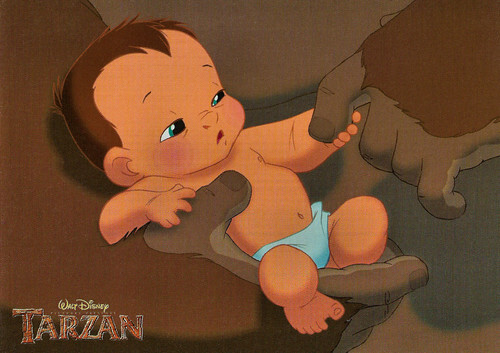
Taiwanese postcard by Starpics / Suwan Studio. Image: Edgar Rice Burroughs, Inc. / Walt Disney Enterprises. Little Tarzan in Tarzan (Chris Buck, Kevin Lima, 1999).
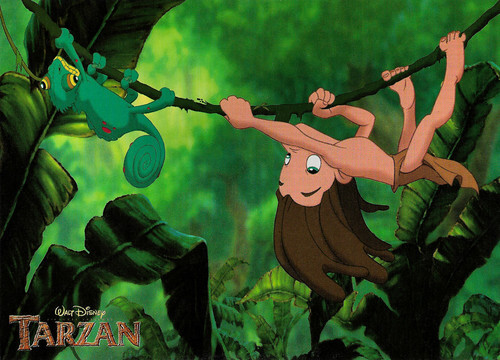
Taiwanese postcard by Starpics / Suwan Studio. Image: Edgar Rice Burroughs, Inc. / Walt Disney Enterprises. Tarzan in Tarzan (Chris Buck, Kevin Lima, 1999).

Taiwanese postcard by Starpics / Suwan Studio. Image: Edgar Rice Burroughs, Inc. / Walt Disney Enterprises. Tarzan in Tarzan (Chris Buck, Kevin Lima, 1999).

Taiwanese postcard by Starpics / Suwan Studio. Image: Edgar Rice Burroughs, Inc. / Walt Disney Enterprises. Tarzan in Tarzan (Chris Buck, Kevin Lima, 1999).
Torn between the jungle and going with Jane to England
A ship disappears burning in the waves. Only a young, British family, a couple and their baby survive the disaster. They end up in the African jungle, where they build a treehouse.
In that same jungle lives a group of gorillas led by the silverback Kerchak. Kerchak and his wife Kala have a child, who falls victim to the African leopard Sabor. Not much later, Kala finds the treehouse. Sabor turns out to have struck there too and killed the two people, only the baby is still alive. Kala manages to save the baby from Sabor.
Despite leader Kerchak's disapproval, Kala raises the baby renaming him, Tarzan. A few years later, young Tarzan struggles to keep up with the other gorillas as he is different. Eventually, he becomes friends with Kala's niece, Terk and the paranoid elephant Tantor.
In the following years, Tarzan develops all the instincts of an ape and learns all about the jungle and its dangers. As an adult, he masters all these skills and his athletic physical abilities. When the group is attacked by Sabor, Tarzan saves Kerchak and the group and kills the leopard with his spear.
Professor Archimedes Q. Porter and his daughter Jane are studying the gorillas led by their hunter guide Clayton. When Jane is chased by a pack of baboons, Tarzan rescues her. Tarzan discovers he is a human and must decide where he really belongs. He becomes torn between the jungle and going with Jane to England.

French double card. Image: Burroughs / Disney. Jane in Tarzan (Chris Buck, Kevin Lima, 1999).
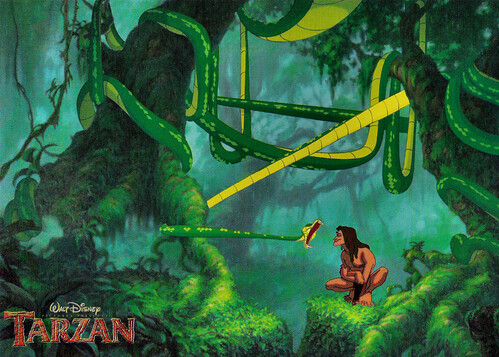
Taiwanese postcard by Starpics / Suwan Studio. Image: Edgar Rice Burroughs, Inc. / Walt Disney Enterprises. Tarzan in Tarzan (Chris Buck, Kevin Lima, 1999).
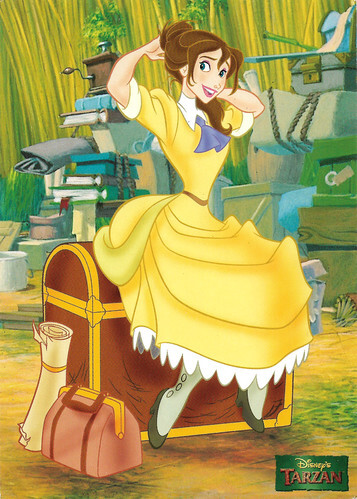
French postcard by Chromovogue, Boissy, no. 3S10140041476. Image: Disney. Jane in Tarzan (Chris Buck, Kevin Lima, 1999).
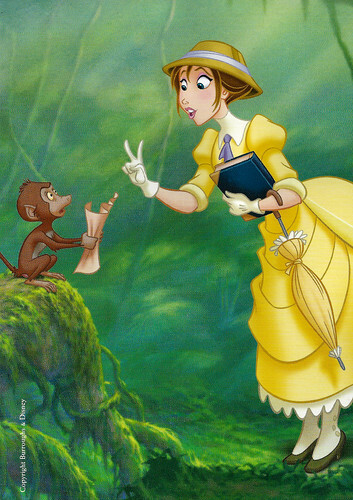
French double card. Image: Burroughs / Disney. Jane in Tarzan (Chris Buck, Kevin Lima, 1999).

Taiwanese postcard by Starpics / Suwan Studio. Image: Edgar Rice Burroughs, Inc. / Walt Disney Enterprises. Jane in Tarzan (Chris Buck, Kevin Lima, 1999).
The end of the Disney Renaissance
The screenplay for Tarzan (Chris Buck, Kevin Lima, 1999) was written by Tab Murphy, Bob Tzudiker and Noni White and they captured the spirit of the classic story by Edgar Rice Burroughs, 'Tarzan of the Apes' (1912). The plot, a good combination of drama, action, comedy and romance, is basic and easy to follow but more remarkable is the character development.
All the characters are memorable and Tarzan and Jane's relationship is wonderfully developed. Tarzan is charismatic, emotional, outgoing, and at the same time, goofy and boyish. Jane is eccentric, feisty, benevolent, and intelligent. The scenes between Tarzan and his ape mother, Kala, are tender and it's beautiful to see how Jane helps Tarzan to understand the ways of human life.
Glen Keane served as the supervising animator for Tarzan as an adult, while John Ripa animated Tarzan as an infant and child. Ripa studied the movements of young chimpanzees to use for young Tarzan's animation, while Keane used the movements of a gibbon and used it for the animation of adult Tarzan, he also watched his son Max Keane do his skateboarding and snowboarding and used surfers' moves in the scenes where Tarzan is sliding through the trees.
Terk and Tantor provide great comic relief, and the gorillas provide plenty of quite emotional scenes. The animation is mind-blowing. The jungle feels immersive and lifelike and it's exciting to see Tarzan energetically swinging in the trees. Also impressive are the fire effects used in the jungle, and the smoke effects from the guns used by the poachers.
Kudos to the makers for how they managed to combine hand-drawn animation with CGI effects. The action scenes move at such a fast and steady pace, unseen before in a hand-drawn film. The songs by Phil Collins are spectacular, even winning an Oscar for 'You'll be in My Heart'. Tarzan was Disney's last big box office hit and widely acclaimed film for a number of years. It would be the end of a great period that had started with The Little Mermaid (Ron Clements, John Musker, 1989), a period now known as the Disney Renaissance.
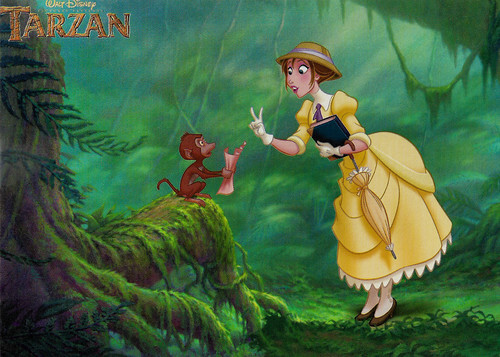
Taiwanese postcard by Starpics / Suwan Studio. Image: Edgar Rice Burroughs, Inc. / Walt Disney Enterprises. Jane in Tarzan (Chris Buck, Kevin Lima, 1999).
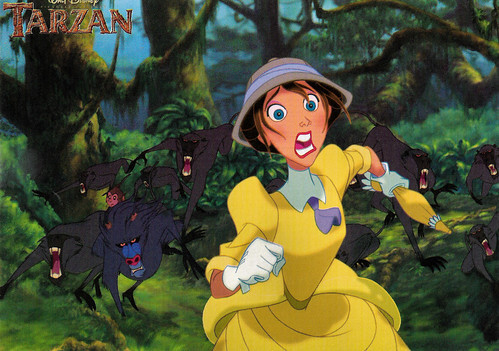
Taiwanese postcard by Starpics / Suwan Studio. Image: Edgar Rice Burroughs, Inc. / Walt Disney Enterprises. Jane in Tarzan (Chris Buck, Kevin Lima, 1999).

Taiwanese postcard by Starpics / Suwan Studio. Image: Edgar Rice Burroughs, Inc. / Walt Disney Enterprises. Tarzan in Tarzan (Chris Buck, Kevin Lima, 1999).

Taiwanese postcard by Starpics / Suwan Studio. Image: Edgar Rice Burroughs, Inc. / Walt Disney Enterprises. Tarzan and Jane in Tarzan (Chris Buck, Kevin Lima, 1999).
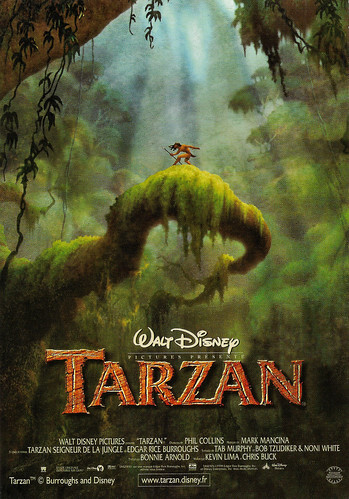
French postcard by Sonis, no. C. 1043. Image: Edgar Rice Burroughs, Inc. / Walt Disney Enterprises. French poster for Tarzan (Chris Buck, Kevin Lima, 1999).
Sources: Wikipedia (Dutch and English) and IMDb.

French double card. Image: Burroughs / Disney. Jane in Tarzan (Chris Buck, Kevin Lima, 1999).

Taiwanese postcard by Starpics / Suwan Studio. Image: Edgar Rice Burroughs, Inc. / Walt Disney Enterprises. Little Tarzan in Tarzan (Chris Buck, Kevin Lima, 1999).

Taiwanese postcard by Starpics / Suwan Studio. Image: Edgar Rice Burroughs, Inc. / Walt Disney Enterprises. Tarzan in Tarzan (Chris Buck, Kevin Lima, 1999).

Taiwanese postcard by Starpics / Suwan Studio. Image: Edgar Rice Burroughs, Inc. / Walt Disney Enterprises. Tarzan in Tarzan (Chris Buck, Kevin Lima, 1999).

Taiwanese postcard by Starpics / Suwan Studio. Image: Edgar Rice Burroughs, Inc. / Walt Disney Enterprises. Tarzan in Tarzan (Chris Buck, Kevin Lima, 1999).
Torn between the jungle and going with Jane to England
A ship disappears burning in the waves. Only a young, British family, a couple and their baby survive the disaster. They end up in the African jungle, where they build a treehouse.
In that same jungle lives a group of gorillas led by the silverback Kerchak. Kerchak and his wife Kala have a child, who falls victim to the African leopard Sabor. Not much later, Kala finds the treehouse. Sabor turns out to have struck there too and killed the two people, only the baby is still alive. Kala manages to save the baby from Sabor.
Despite leader Kerchak's disapproval, Kala raises the baby renaming him, Tarzan. A few years later, young Tarzan struggles to keep up with the other gorillas as he is different. Eventually, he becomes friends with Kala's niece, Terk and the paranoid elephant Tantor.
In the following years, Tarzan develops all the instincts of an ape and learns all about the jungle and its dangers. As an adult, he masters all these skills and his athletic physical abilities. When the group is attacked by Sabor, Tarzan saves Kerchak and the group and kills the leopard with his spear.
Professor Archimedes Q. Porter and his daughter Jane are studying the gorillas led by their hunter guide Clayton. When Jane is chased by a pack of baboons, Tarzan rescues her. Tarzan discovers he is a human and must decide where he really belongs. He becomes torn between the jungle and going with Jane to England.

French double card. Image: Burroughs / Disney. Jane in Tarzan (Chris Buck, Kevin Lima, 1999).

Taiwanese postcard by Starpics / Suwan Studio. Image: Edgar Rice Burroughs, Inc. / Walt Disney Enterprises. Tarzan in Tarzan (Chris Buck, Kevin Lima, 1999).

French postcard by Chromovogue, Boissy, no. 3S10140041476. Image: Disney. Jane in Tarzan (Chris Buck, Kevin Lima, 1999).

French double card. Image: Burroughs / Disney. Jane in Tarzan (Chris Buck, Kevin Lima, 1999).

Taiwanese postcard by Starpics / Suwan Studio. Image: Edgar Rice Burroughs, Inc. / Walt Disney Enterprises. Jane in Tarzan (Chris Buck, Kevin Lima, 1999).
The end of the Disney Renaissance
The screenplay for Tarzan (Chris Buck, Kevin Lima, 1999) was written by Tab Murphy, Bob Tzudiker and Noni White and they captured the spirit of the classic story by Edgar Rice Burroughs, 'Tarzan of the Apes' (1912). The plot, a good combination of drama, action, comedy and romance, is basic and easy to follow but more remarkable is the character development.
All the characters are memorable and Tarzan and Jane's relationship is wonderfully developed. Tarzan is charismatic, emotional, outgoing, and at the same time, goofy and boyish. Jane is eccentric, feisty, benevolent, and intelligent. The scenes between Tarzan and his ape mother, Kala, are tender and it's beautiful to see how Jane helps Tarzan to understand the ways of human life.
Glen Keane served as the supervising animator for Tarzan as an adult, while John Ripa animated Tarzan as an infant and child. Ripa studied the movements of young chimpanzees to use for young Tarzan's animation, while Keane used the movements of a gibbon and used it for the animation of adult Tarzan, he also watched his son Max Keane do his skateboarding and snowboarding and used surfers' moves in the scenes where Tarzan is sliding through the trees.
Terk and Tantor provide great comic relief, and the gorillas provide plenty of quite emotional scenes. The animation is mind-blowing. The jungle feels immersive and lifelike and it's exciting to see Tarzan energetically swinging in the trees. Also impressive are the fire effects used in the jungle, and the smoke effects from the guns used by the poachers.
Kudos to the makers for how they managed to combine hand-drawn animation with CGI effects. The action scenes move at such a fast and steady pace, unseen before in a hand-drawn film. The songs by Phil Collins are spectacular, even winning an Oscar for 'You'll be in My Heart'. Tarzan was Disney's last big box office hit and widely acclaimed film for a number of years. It would be the end of a great period that had started with The Little Mermaid (Ron Clements, John Musker, 1989), a period now known as the Disney Renaissance.

Taiwanese postcard by Starpics / Suwan Studio. Image: Edgar Rice Burroughs, Inc. / Walt Disney Enterprises. Jane in Tarzan (Chris Buck, Kevin Lima, 1999).

Taiwanese postcard by Starpics / Suwan Studio. Image: Edgar Rice Burroughs, Inc. / Walt Disney Enterprises. Jane in Tarzan (Chris Buck, Kevin Lima, 1999).

Taiwanese postcard by Starpics / Suwan Studio. Image: Edgar Rice Burroughs, Inc. / Walt Disney Enterprises. Tarzan in Tarzan (Chris Buck, Kevin Lima, 1999).

Taiwanese postcard by Starpics / Suwan Studio. Image: Edgar Rice Burroughs, Inc. / Walt Disney Enterprises. Tarzan and Jane in Tarzan (Chris Buck, Kevin Lima, 1999).

French postcard by Sonis, no. C. 1043. Image: Edgar Rice Burroughs, Inc. / Walt Disney Enterprises. French poster for Tarzan (Chris Buck, Kevin Lima, 1999).
Sources: Wikipedia (Dutch and English) and IMDb.
Published on February 07, 2023 22:30
Paul van Yperen's Blog
- Paul van Yperen's profile
- 13 followers
Paul van Yperen isn't a Goodreads Author
(yet),
but they
do have a blog,
so here are some recent posts imported from
their feed.



